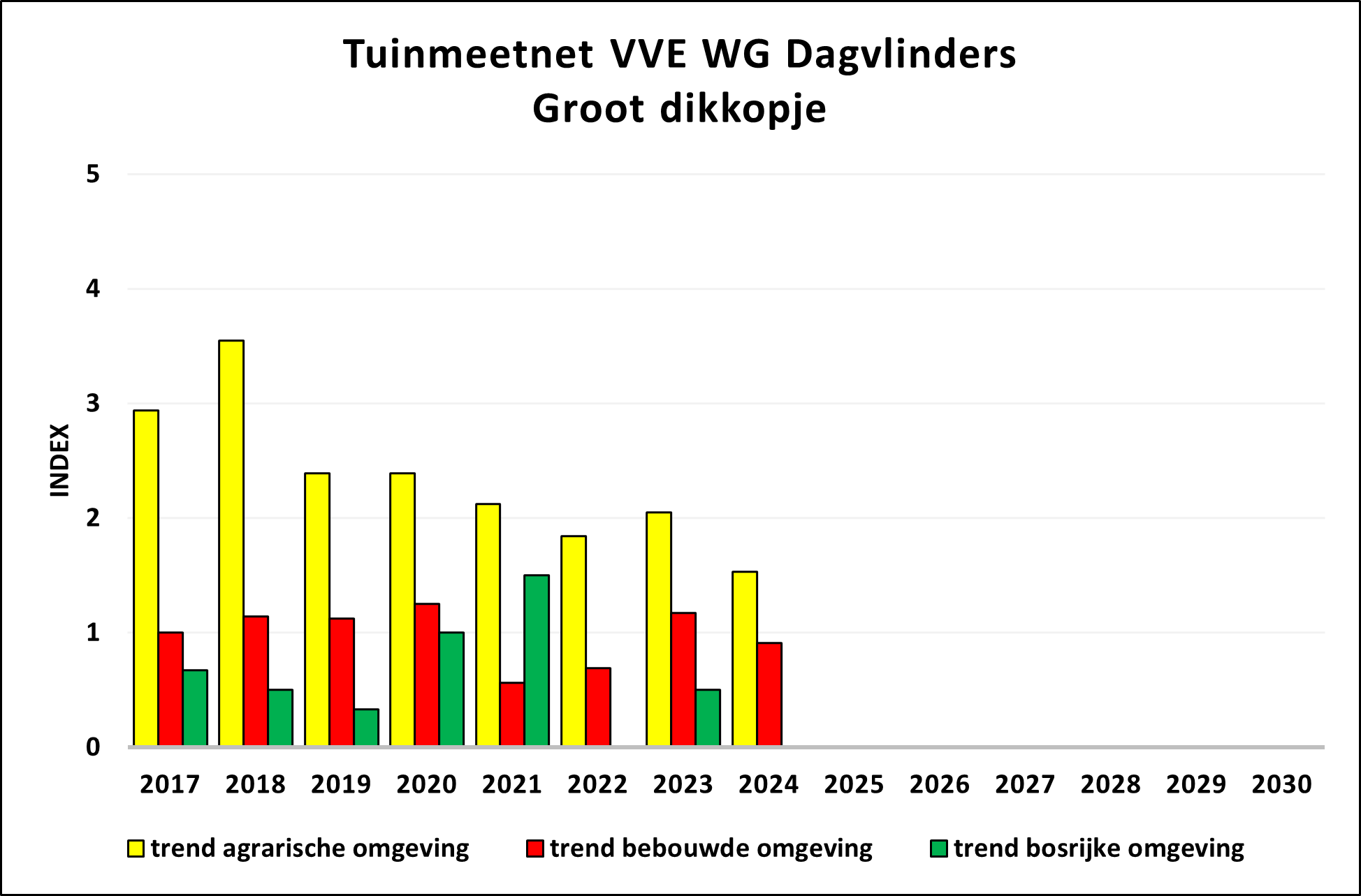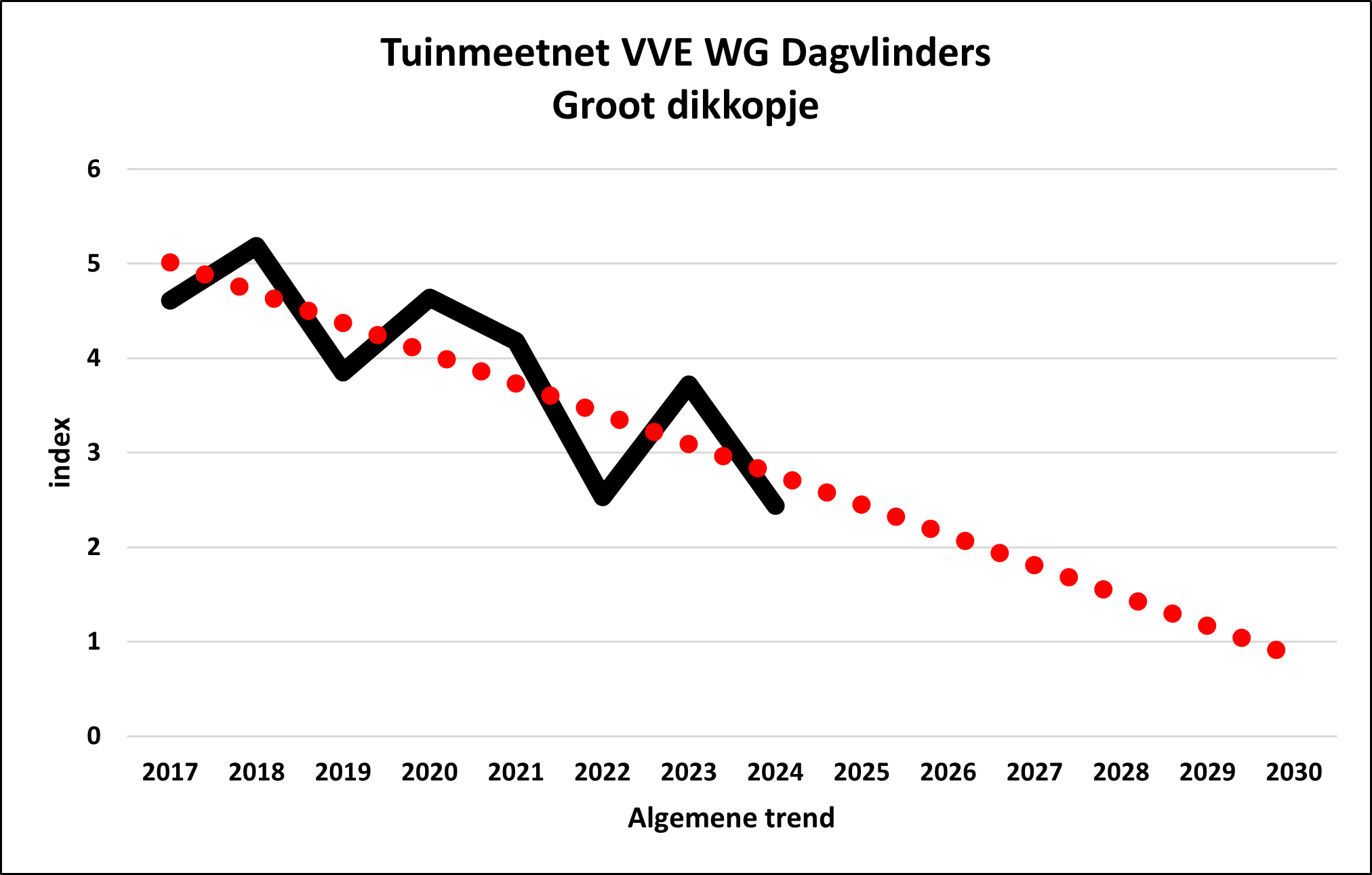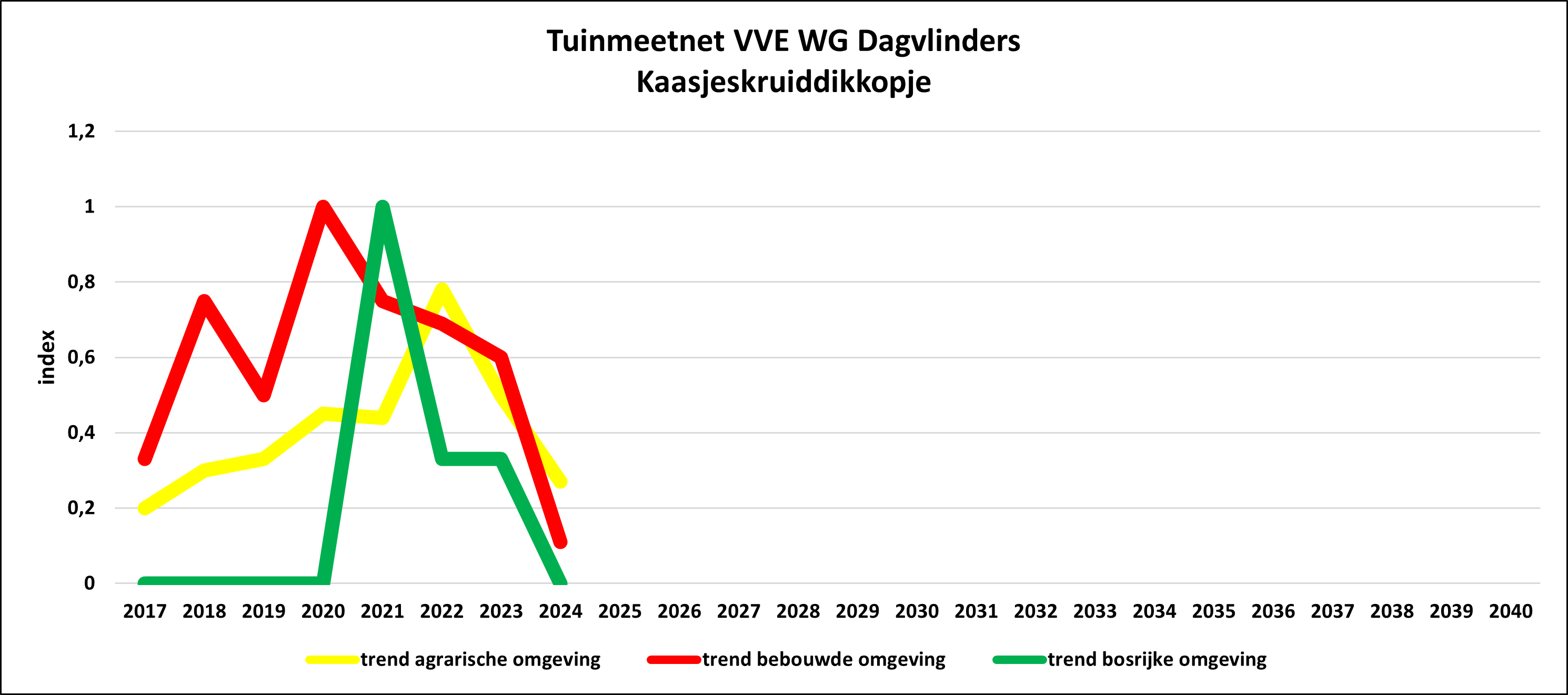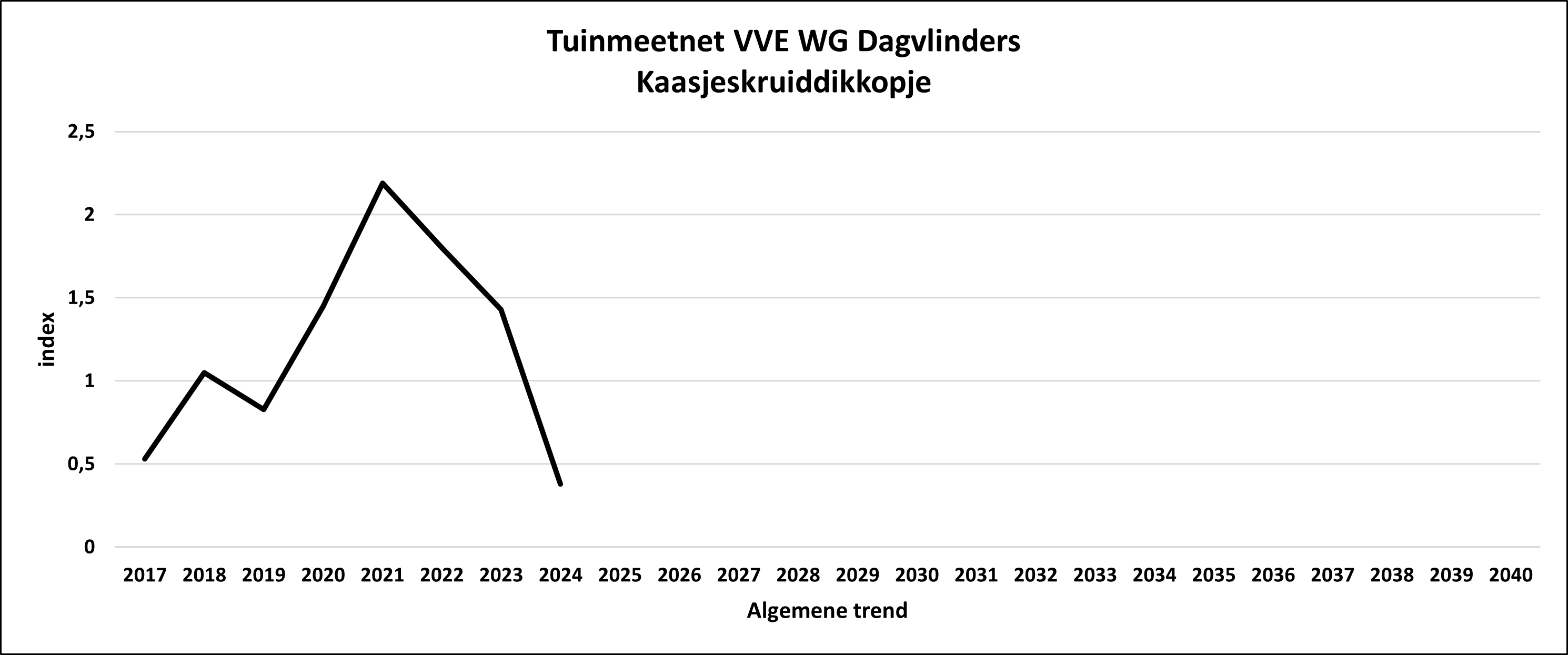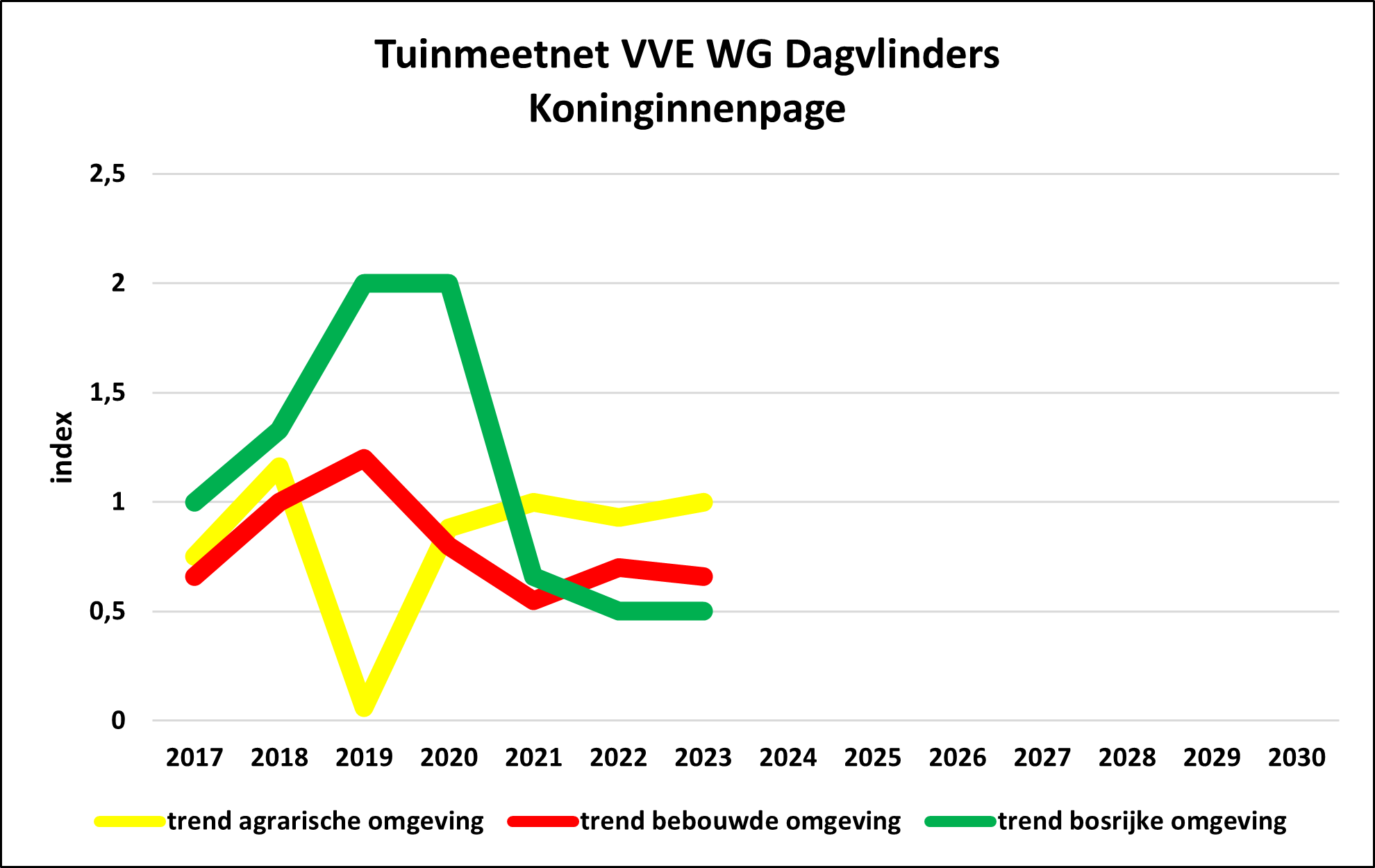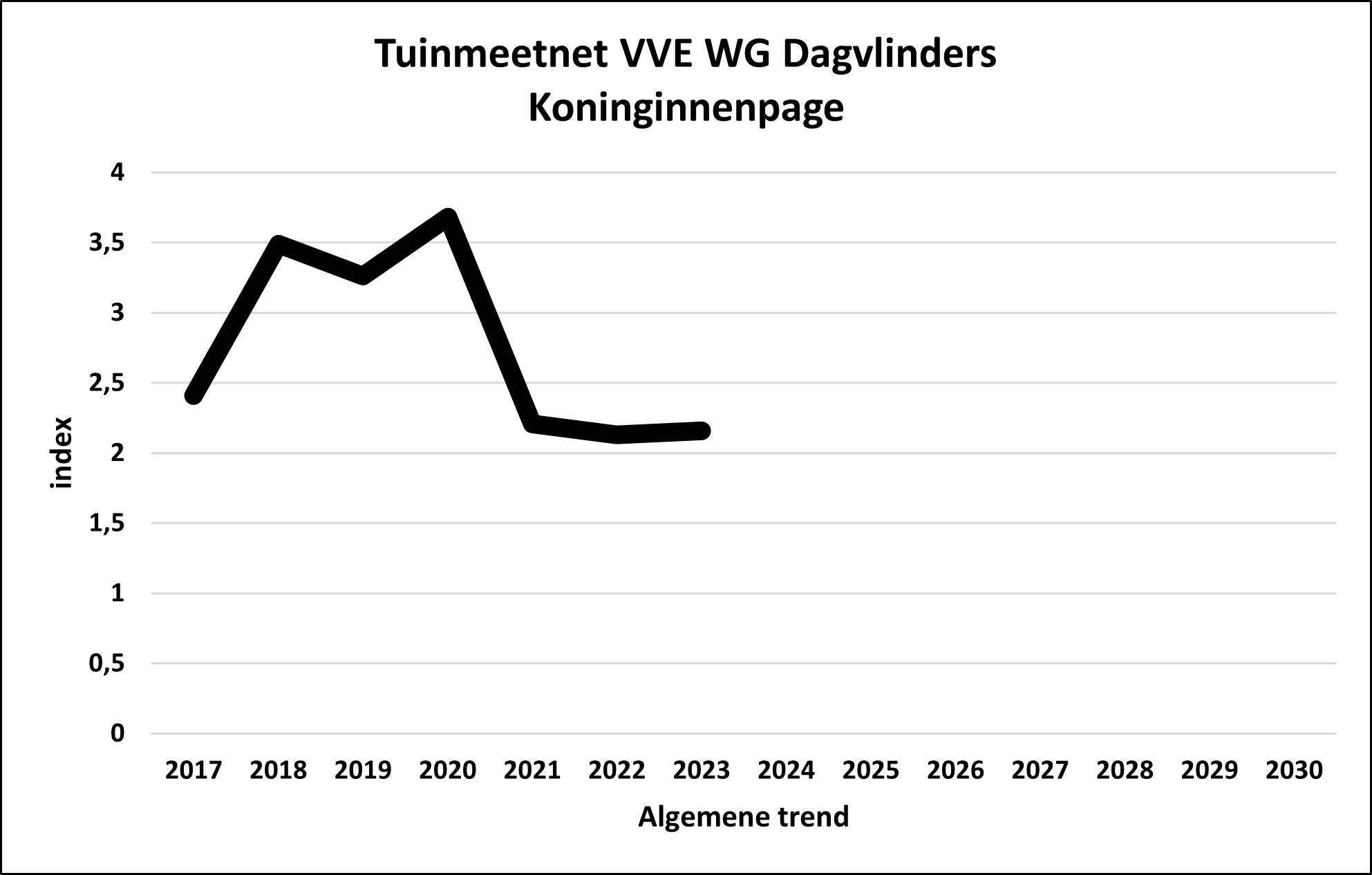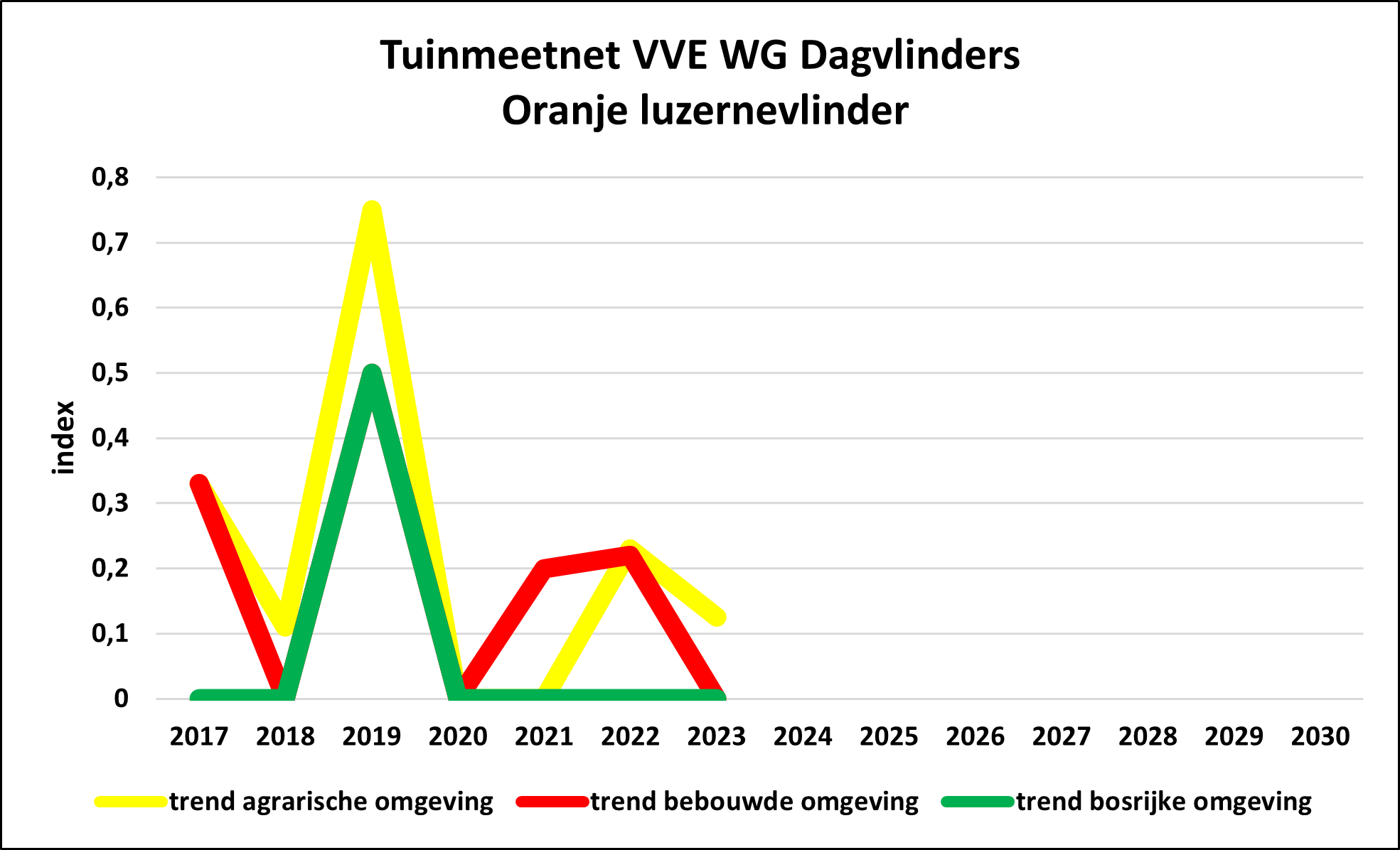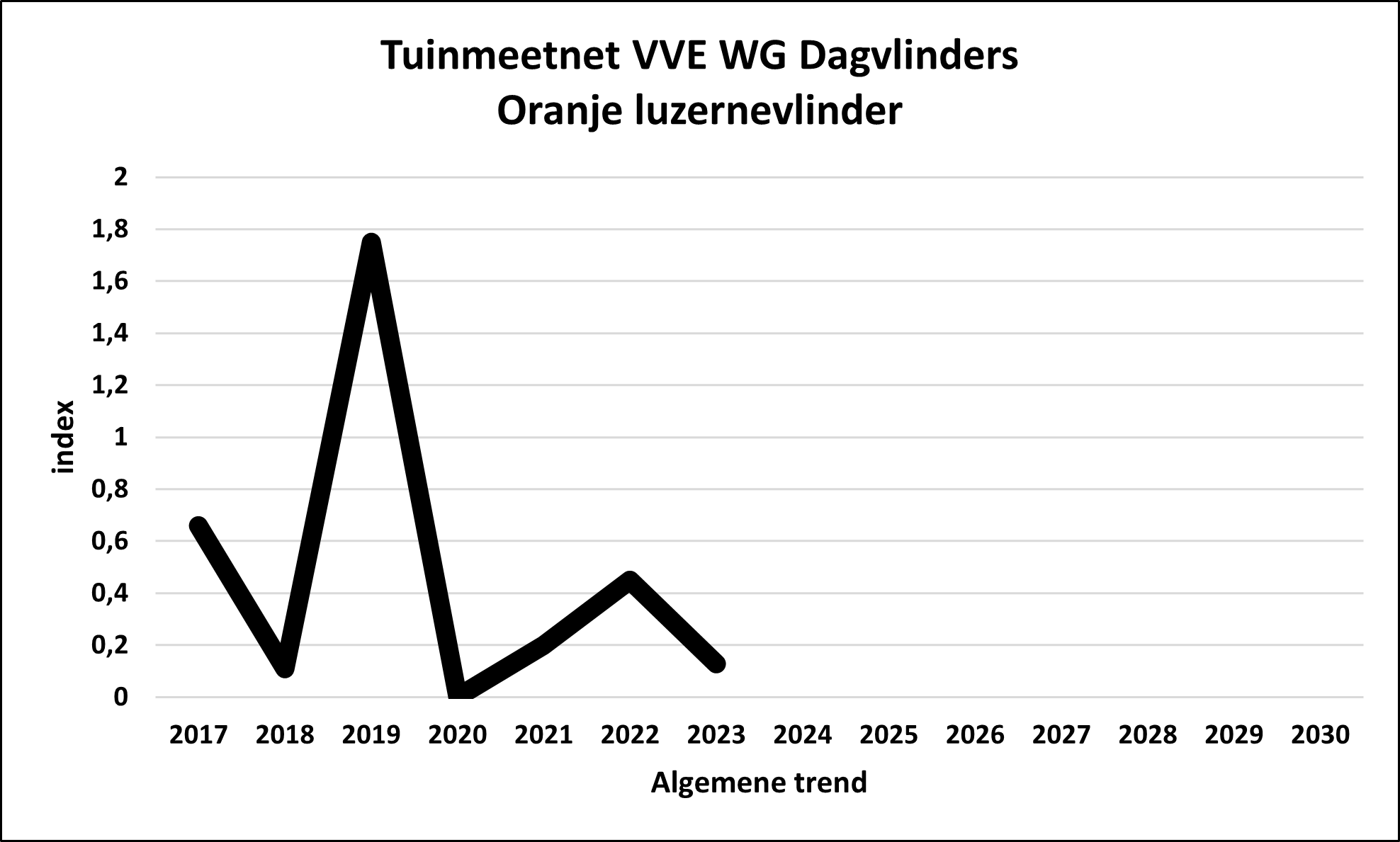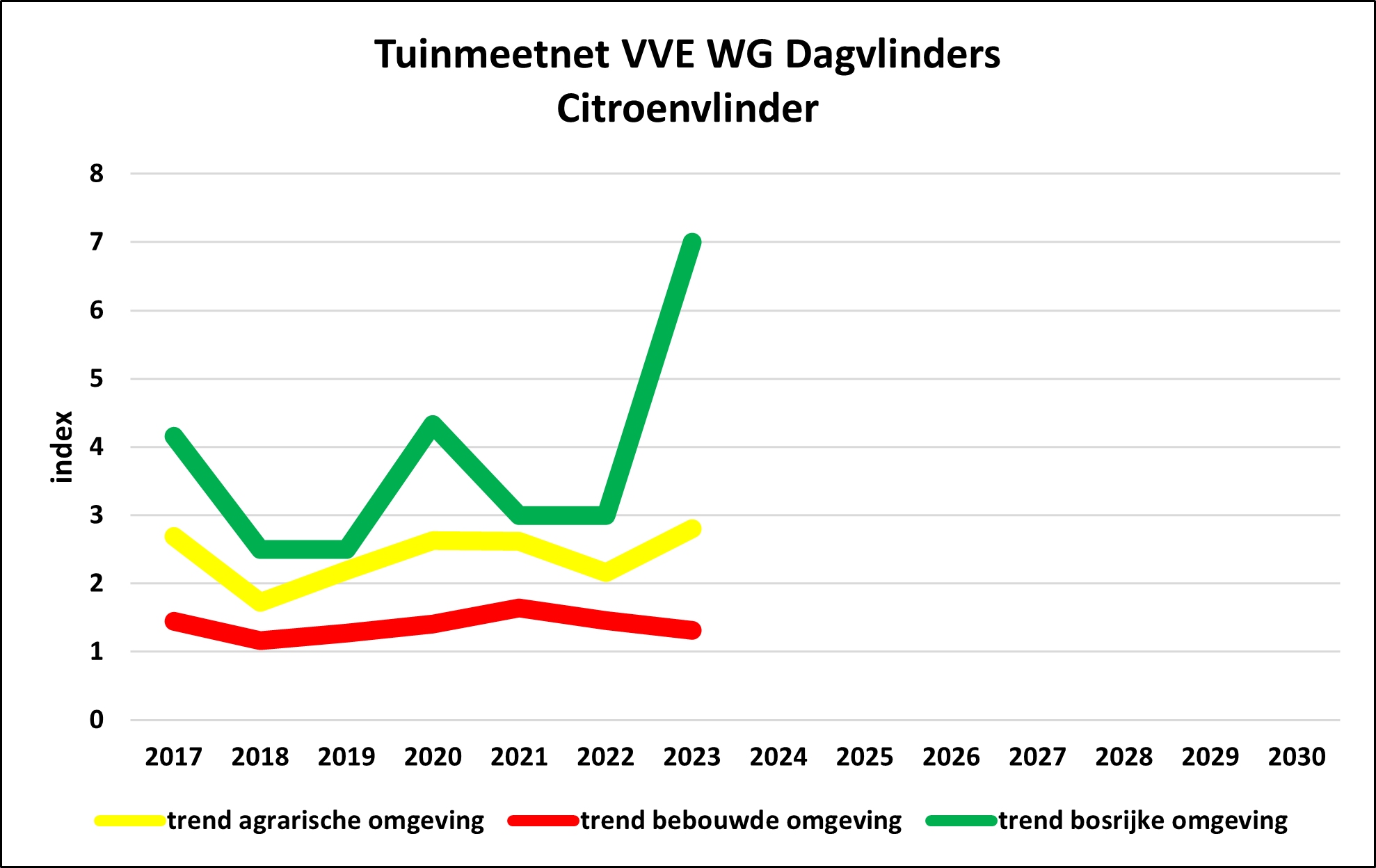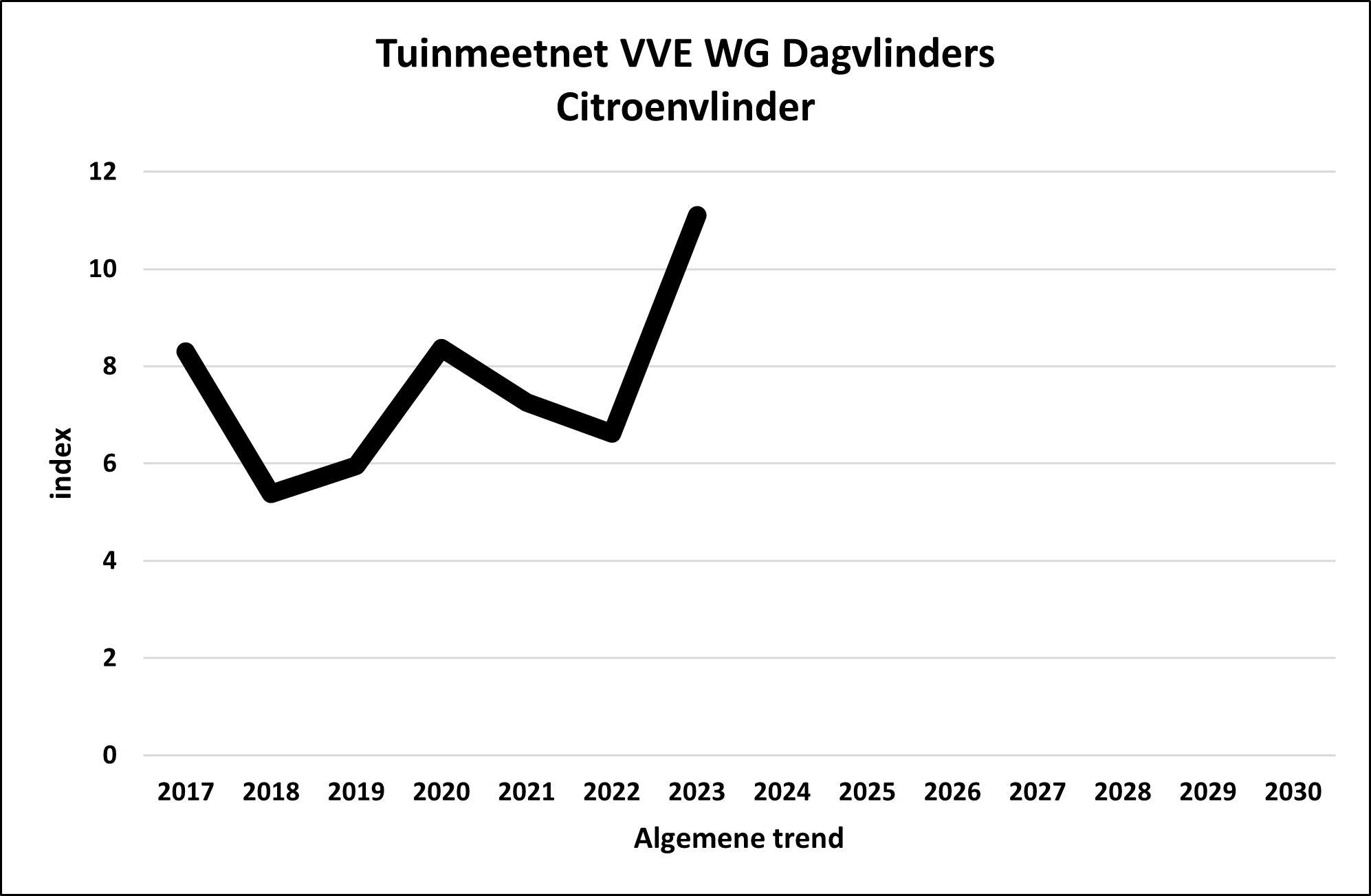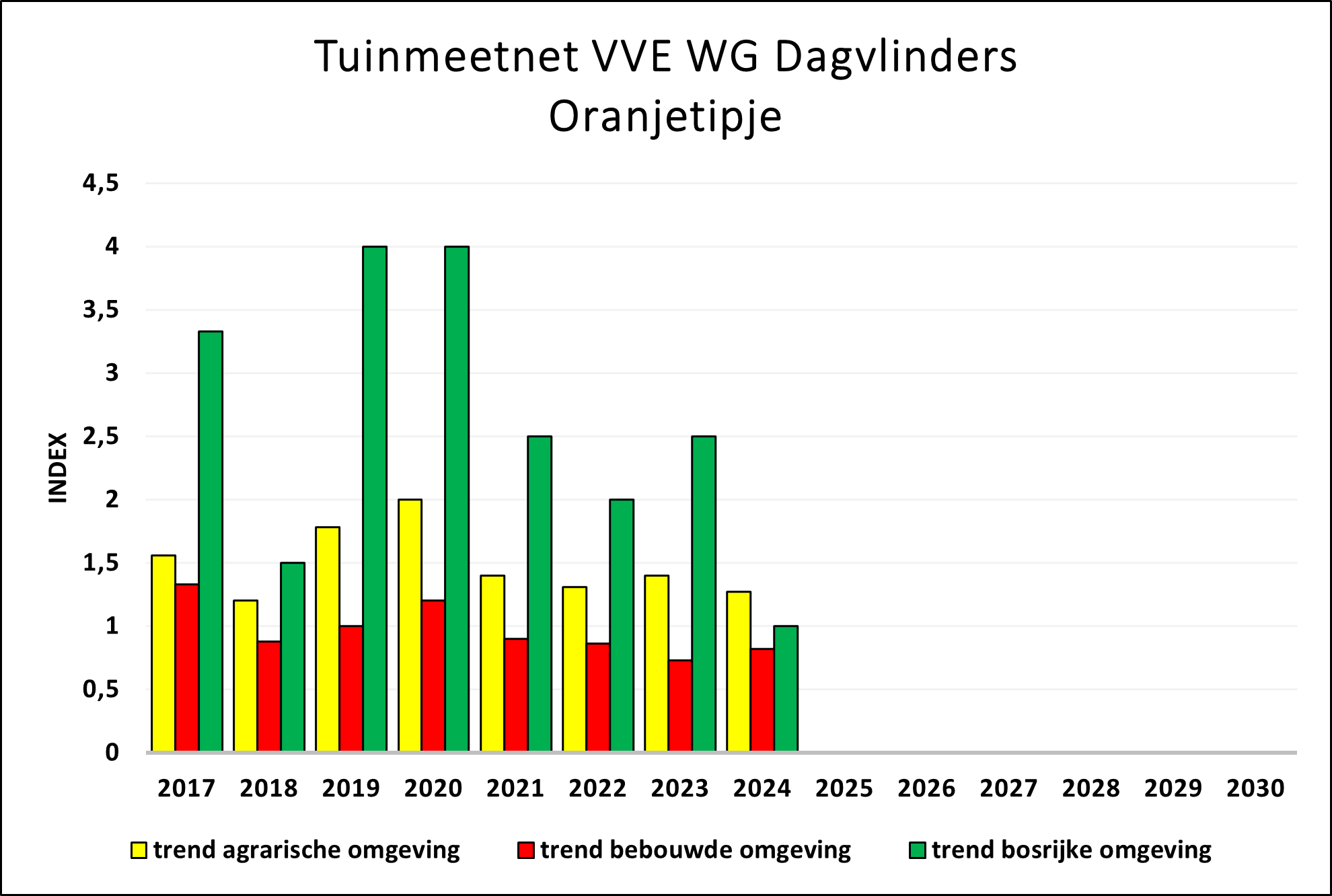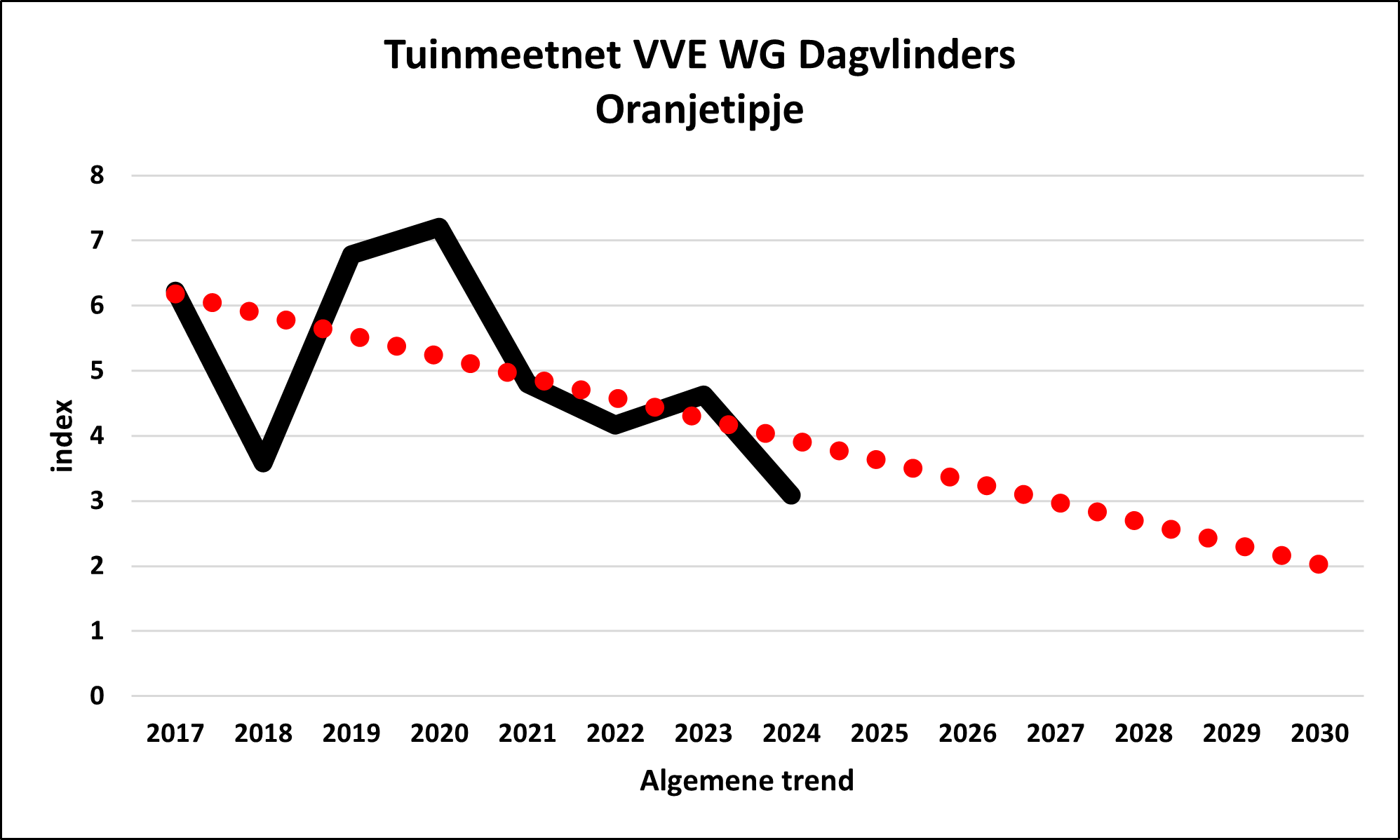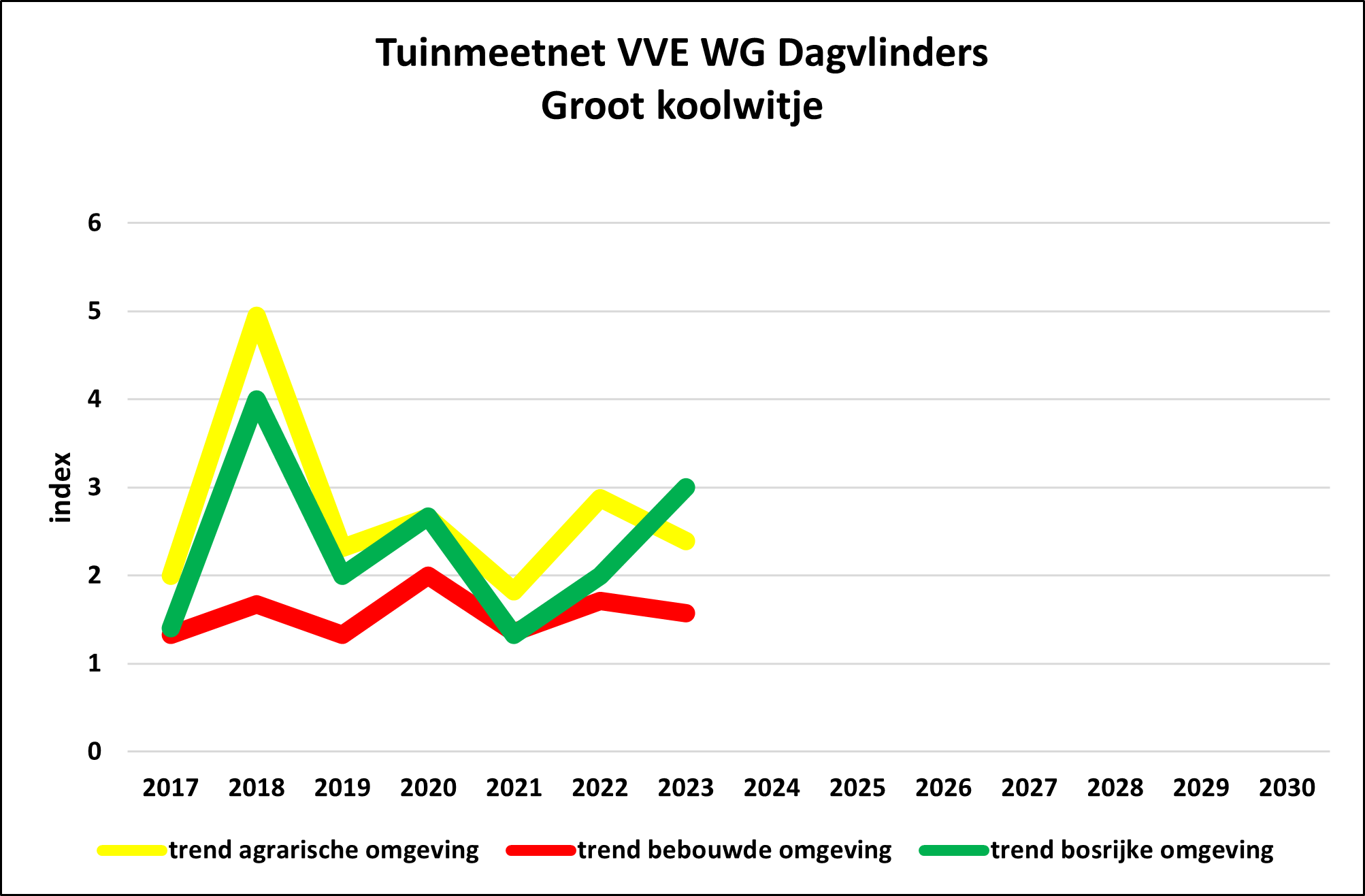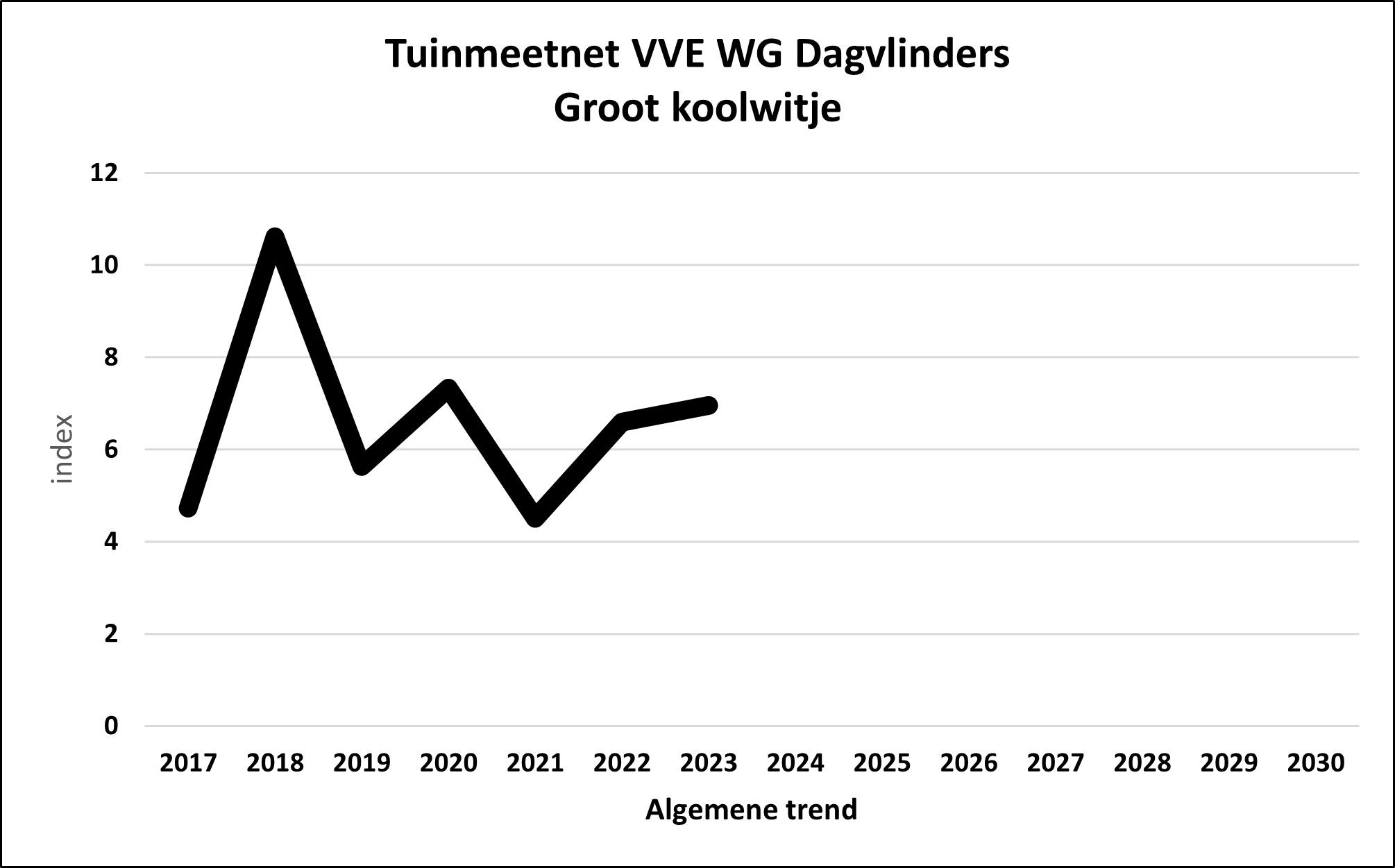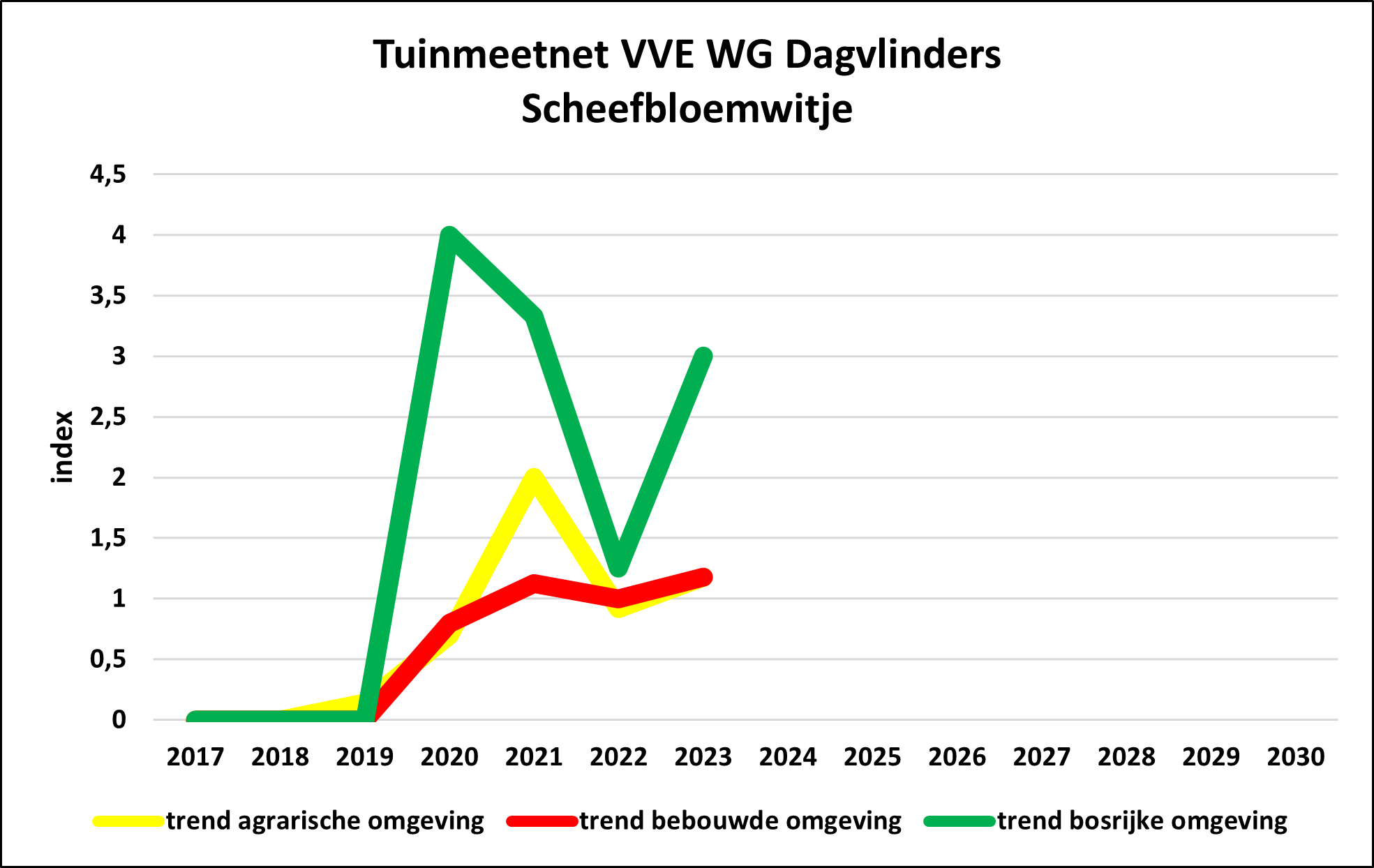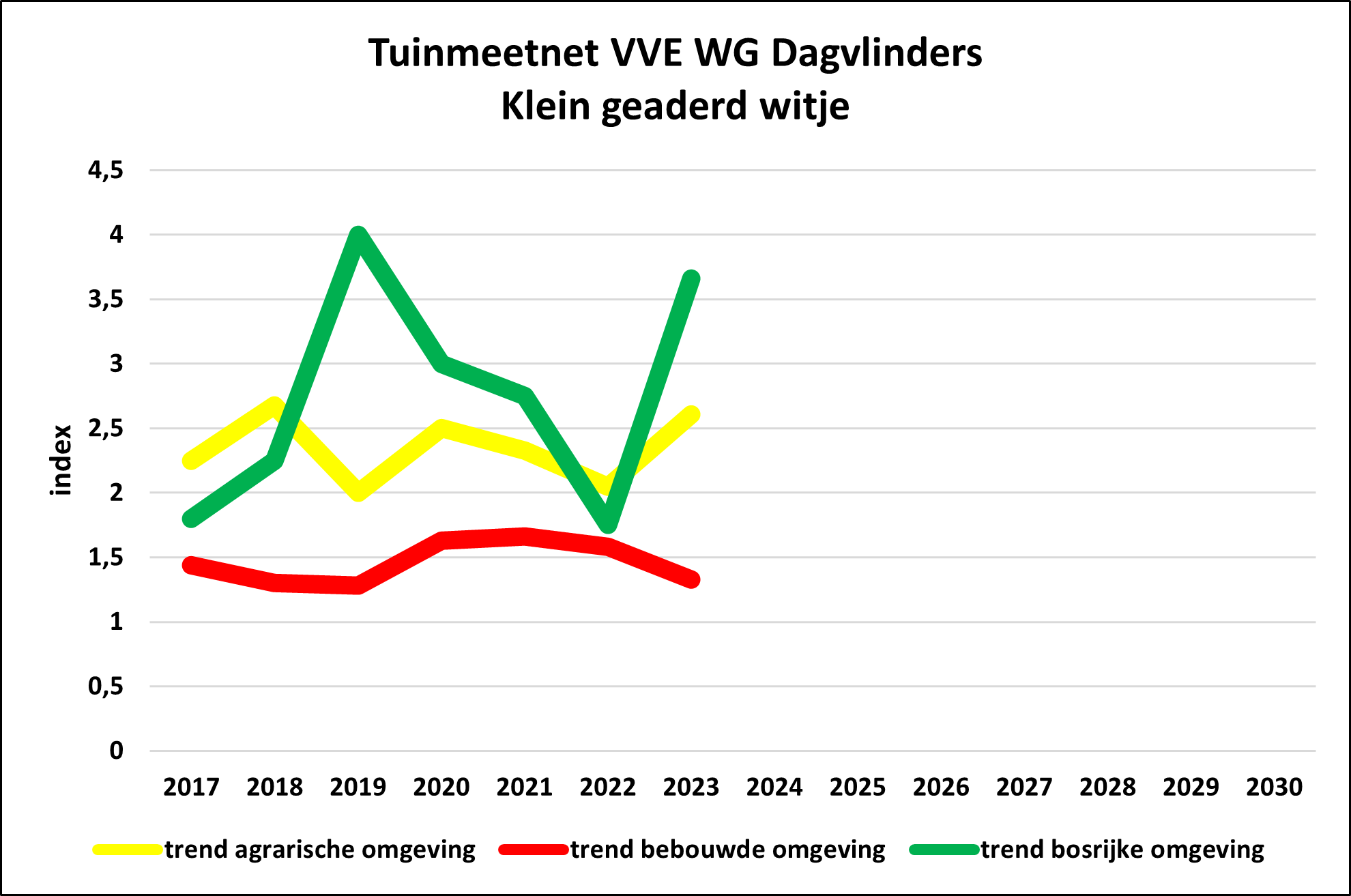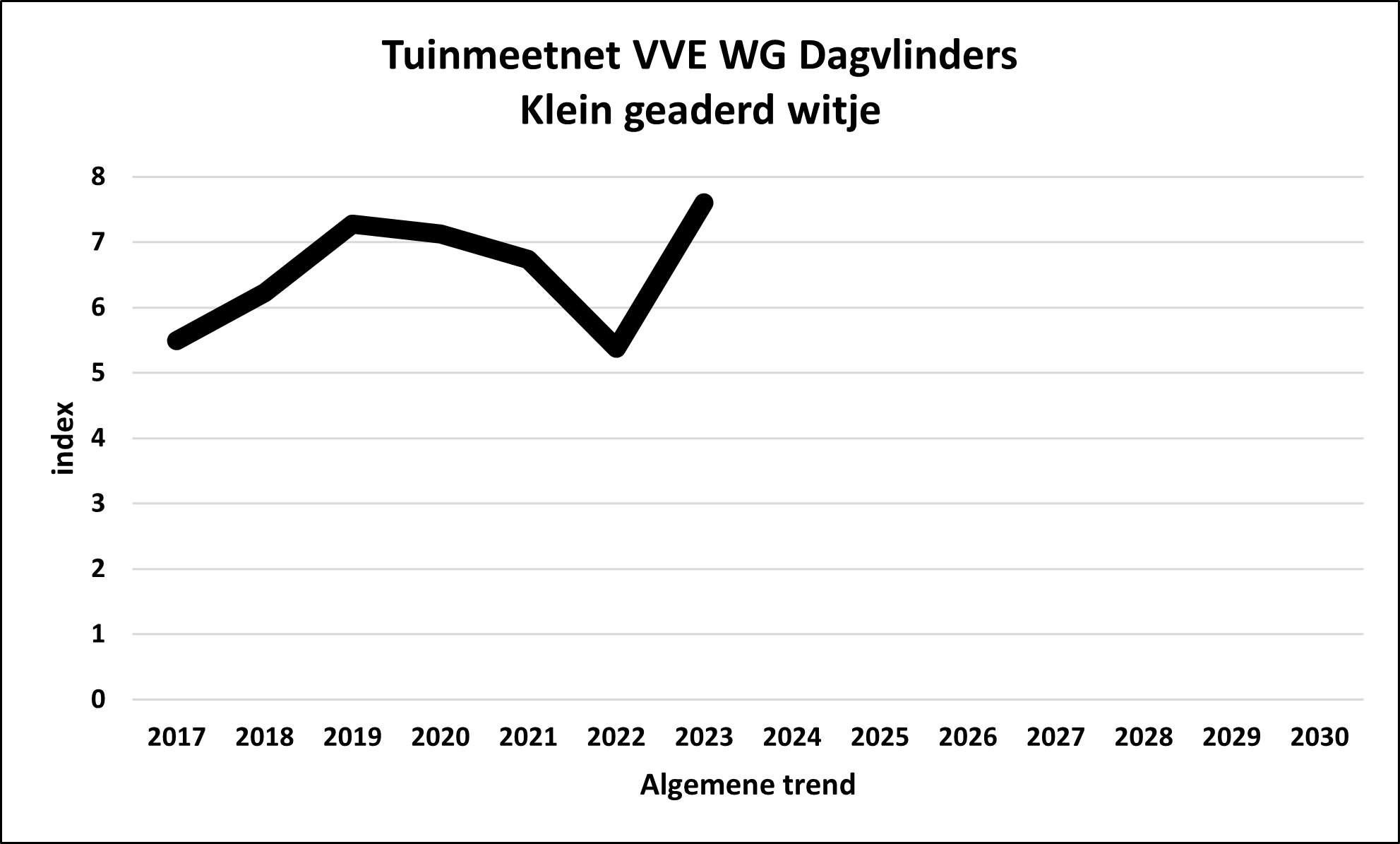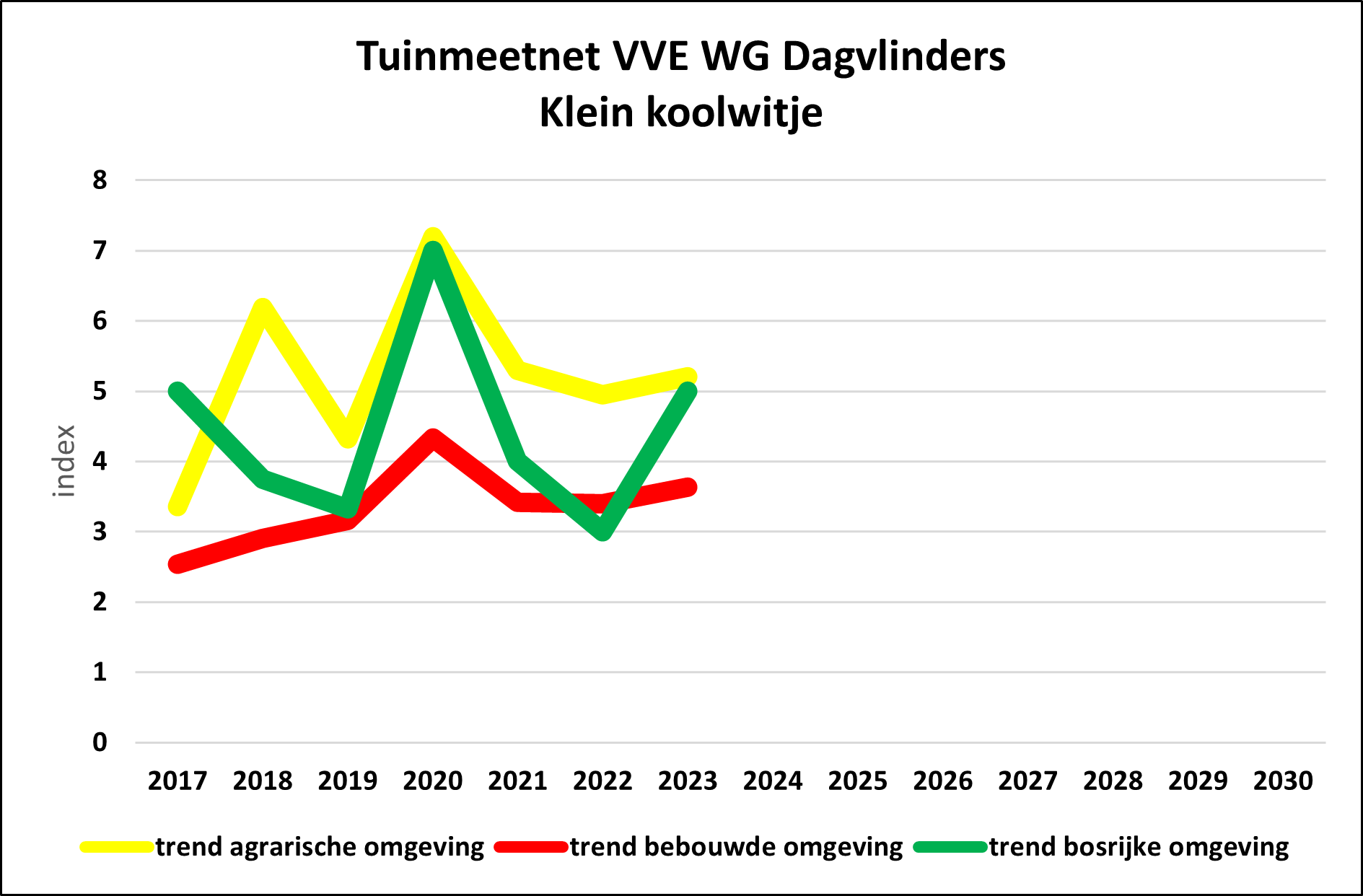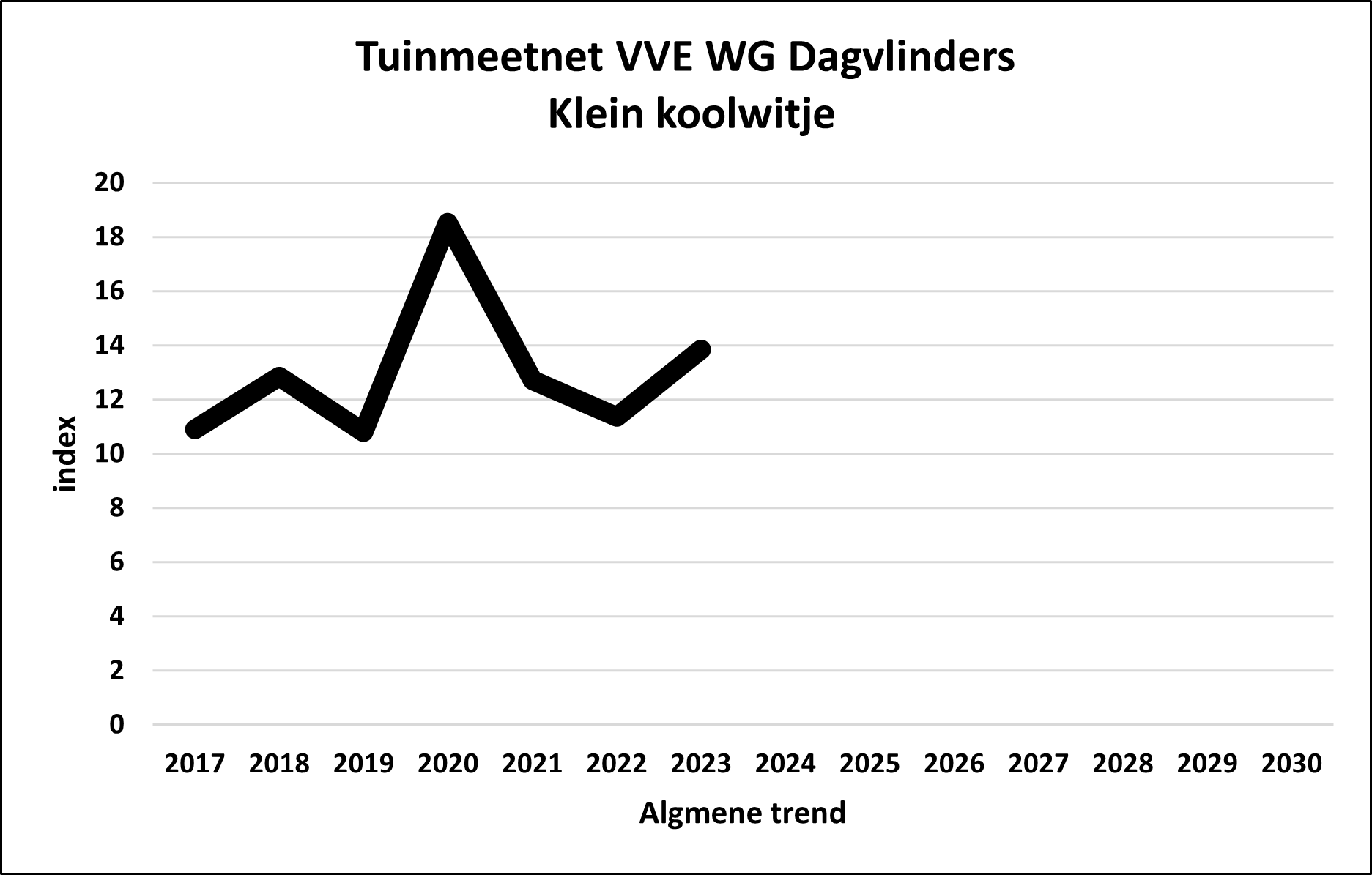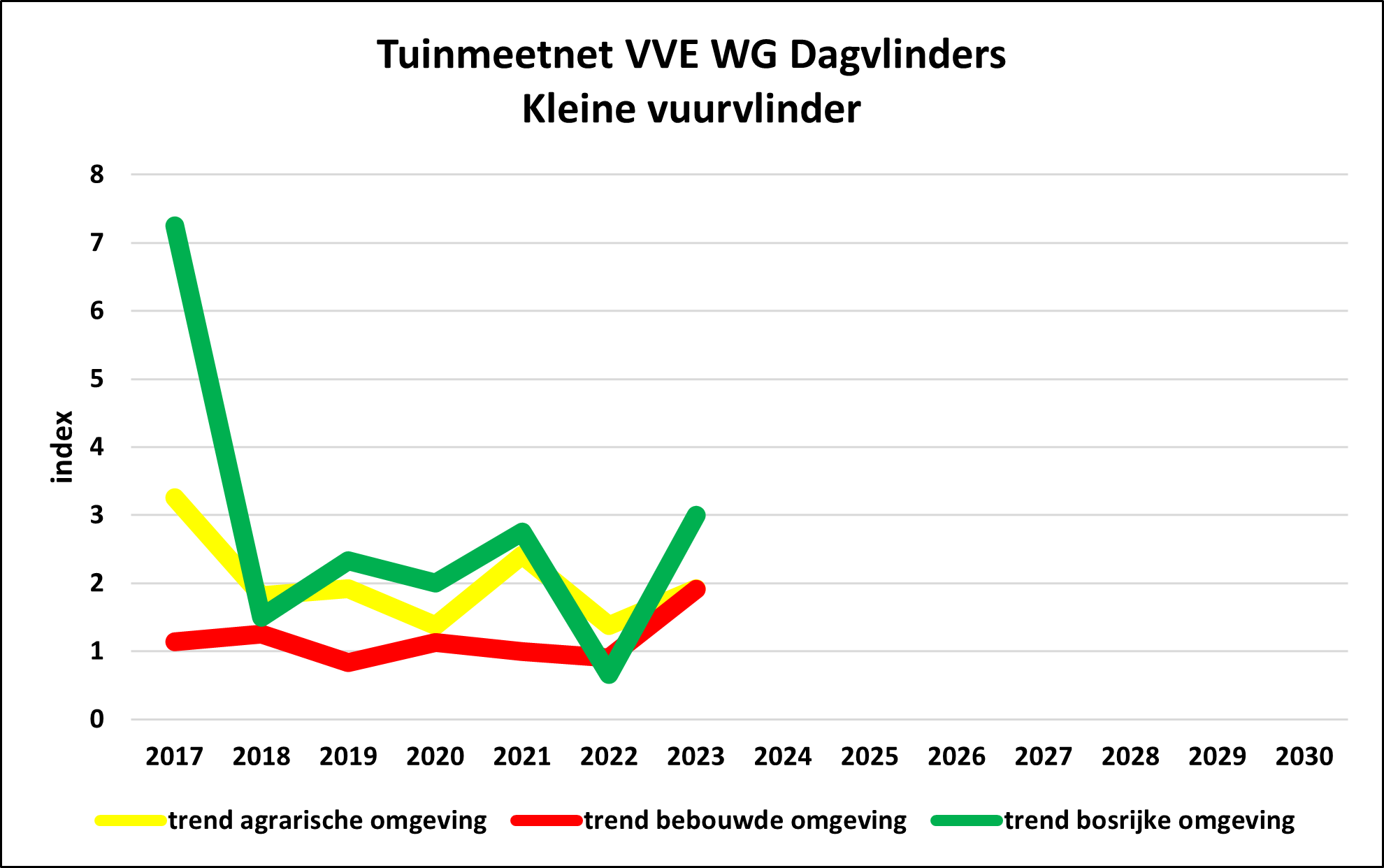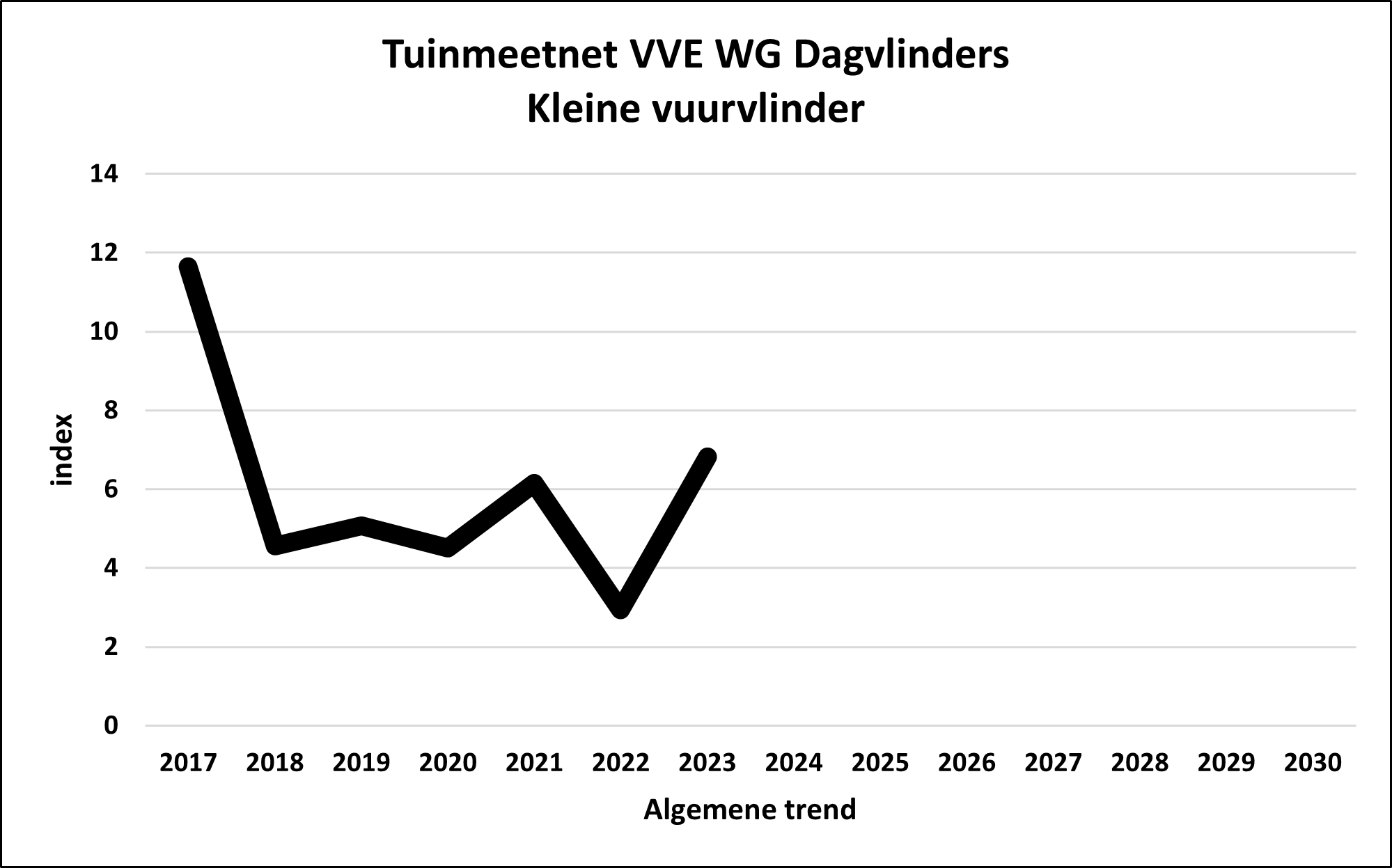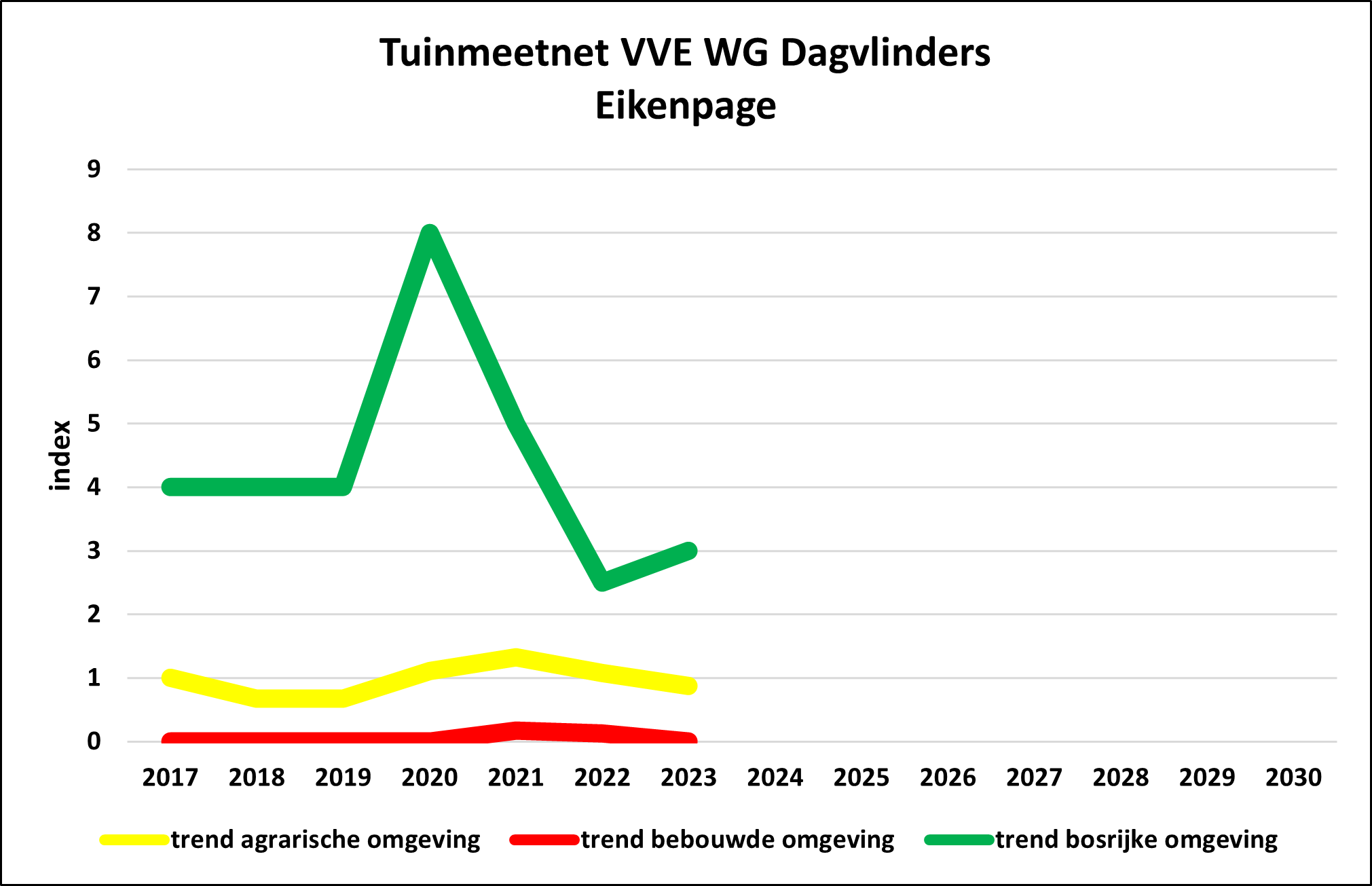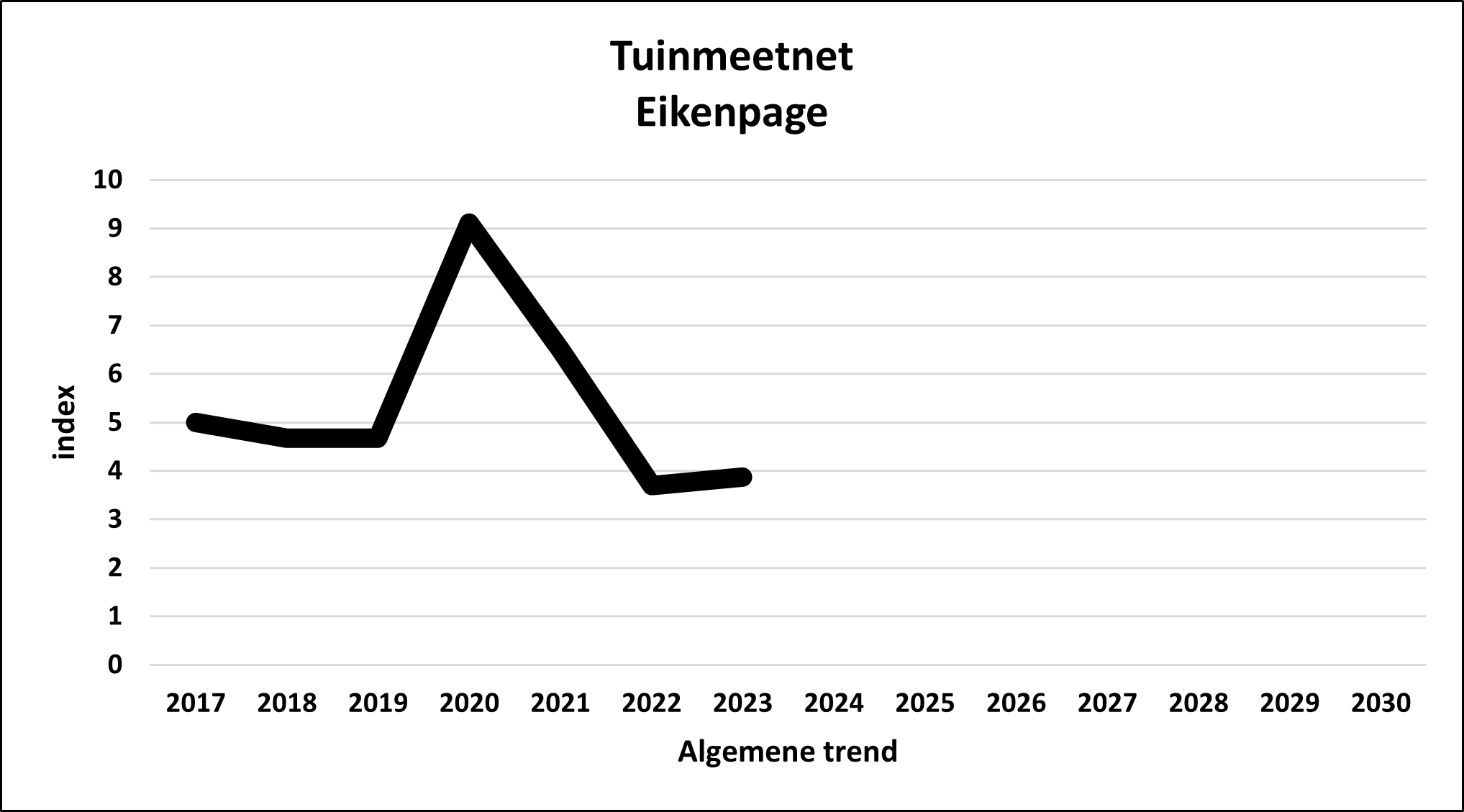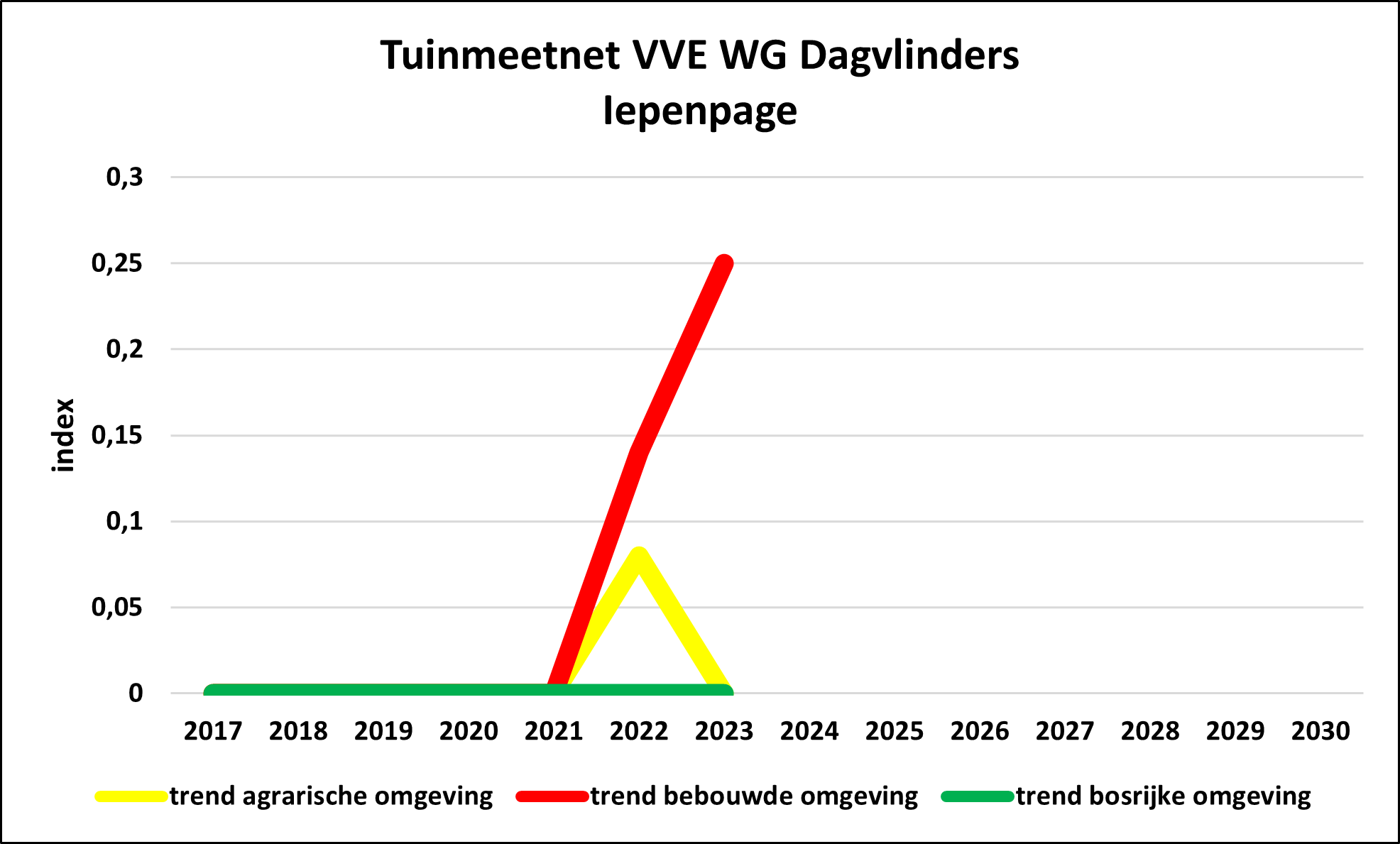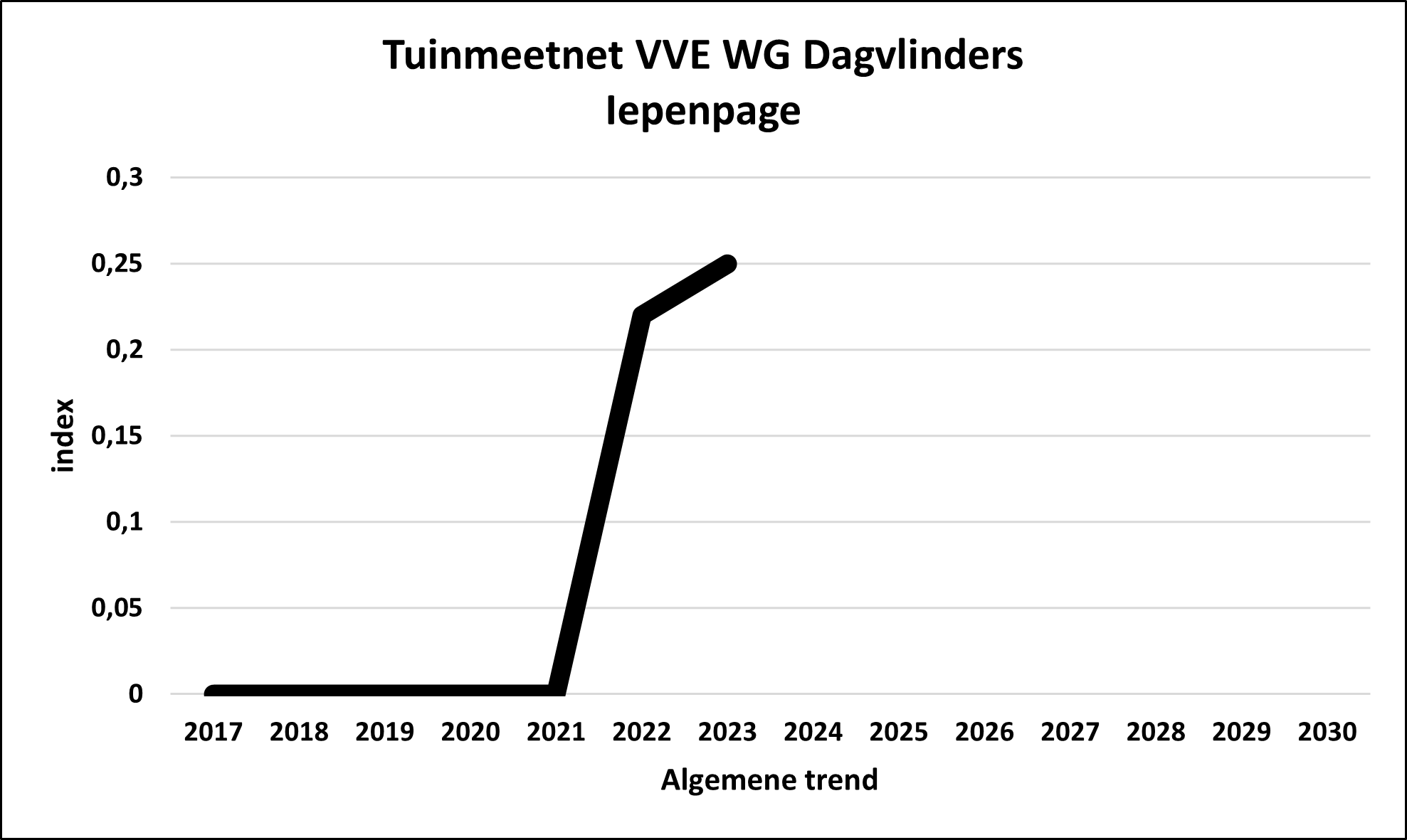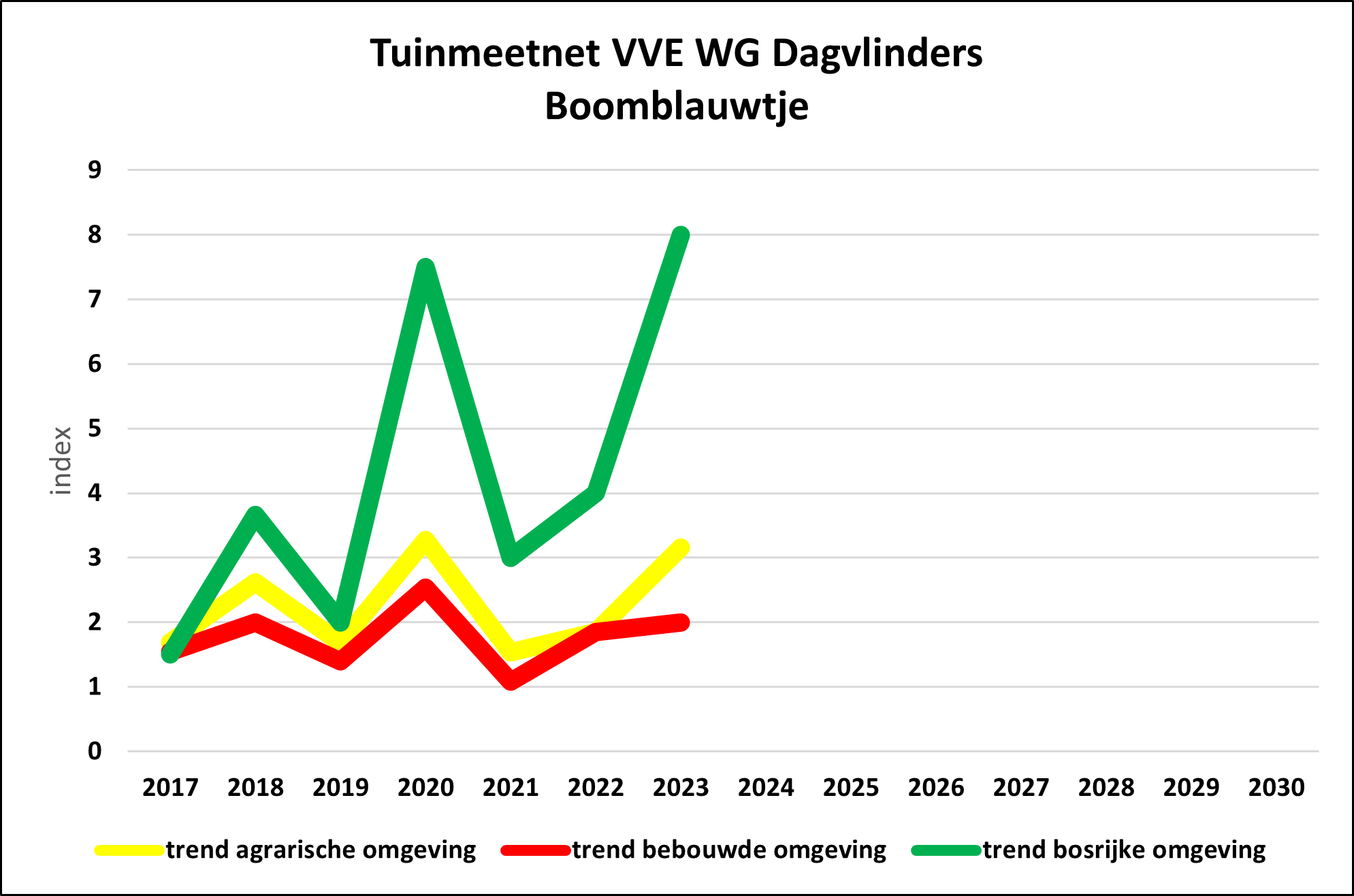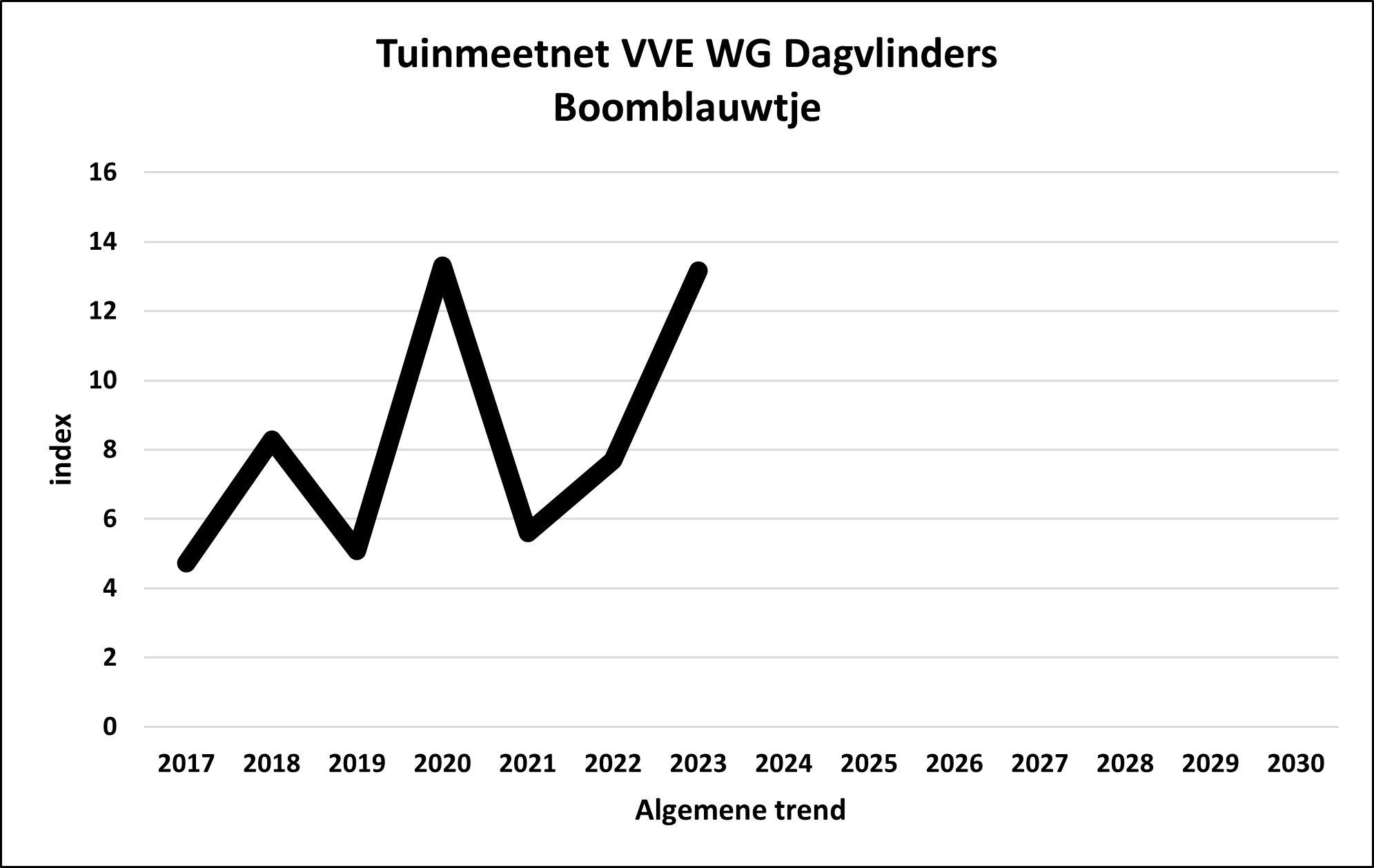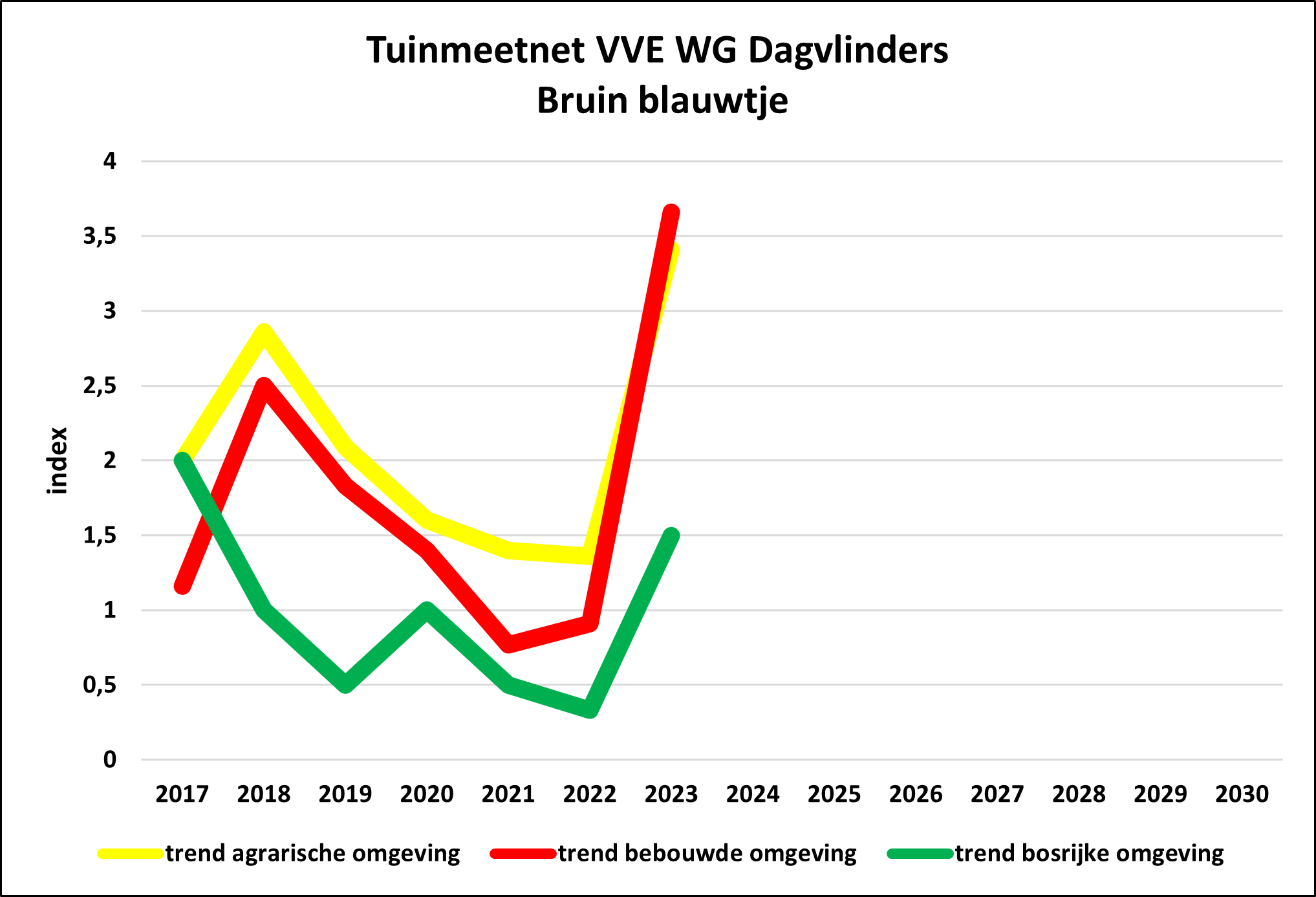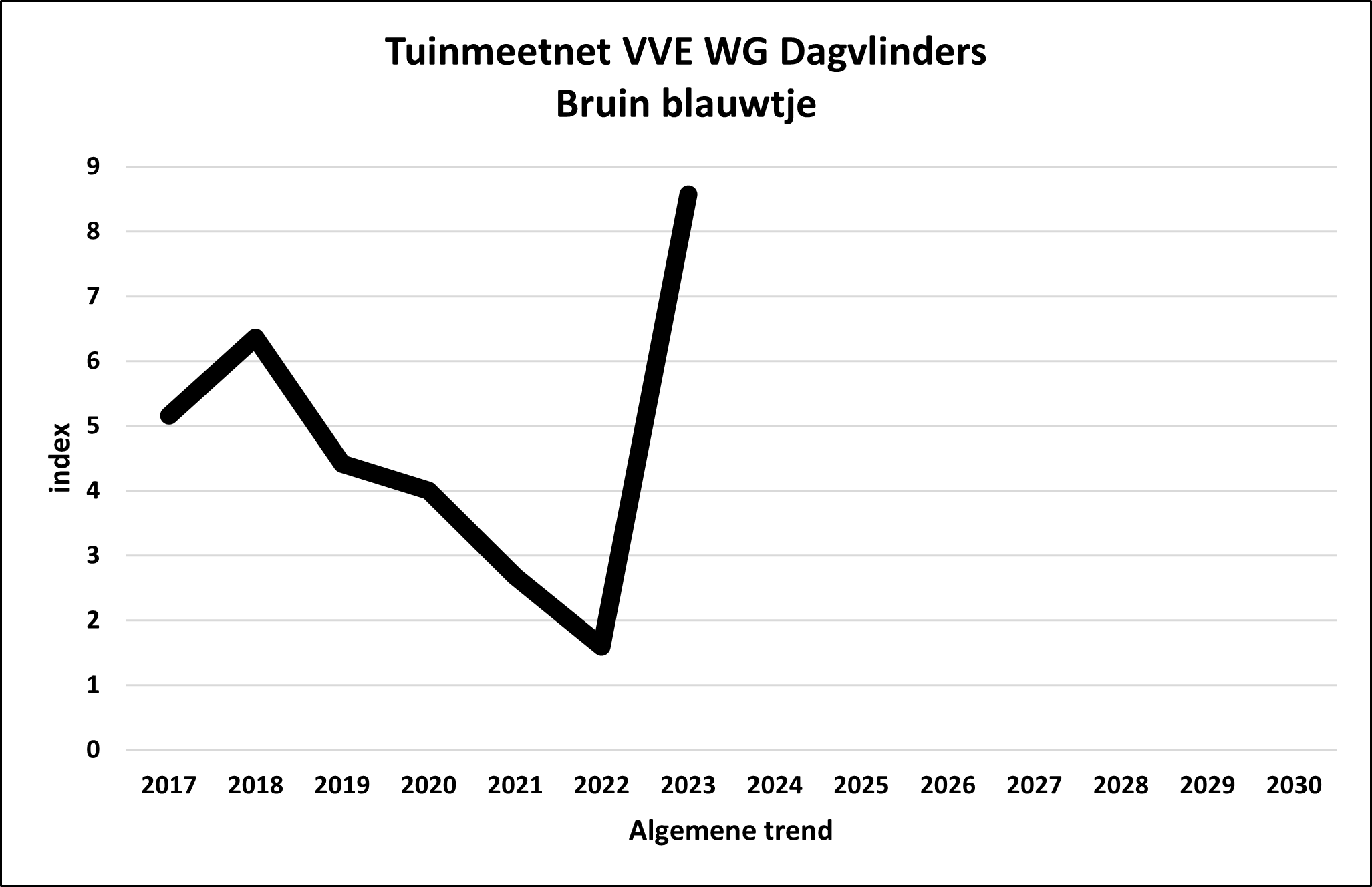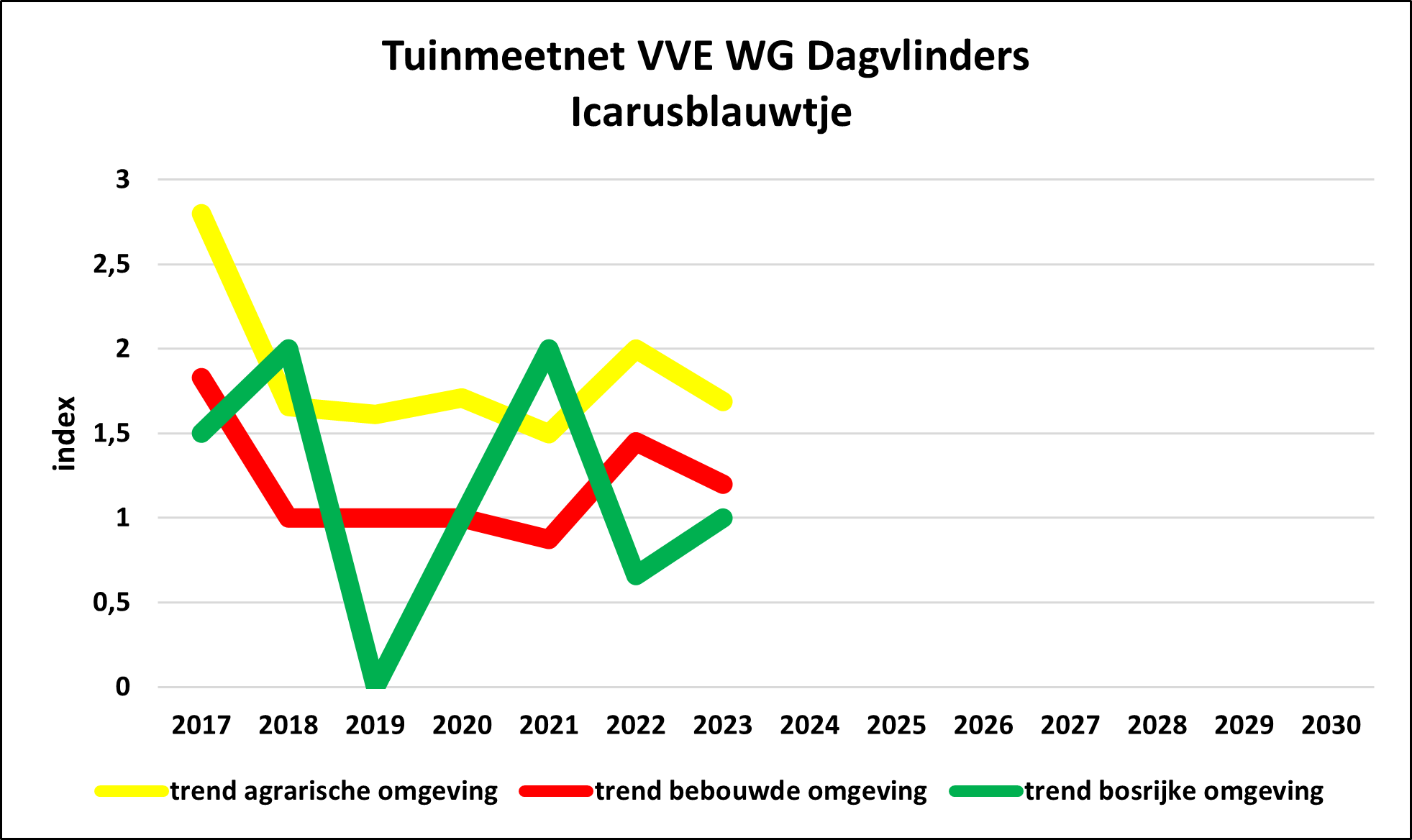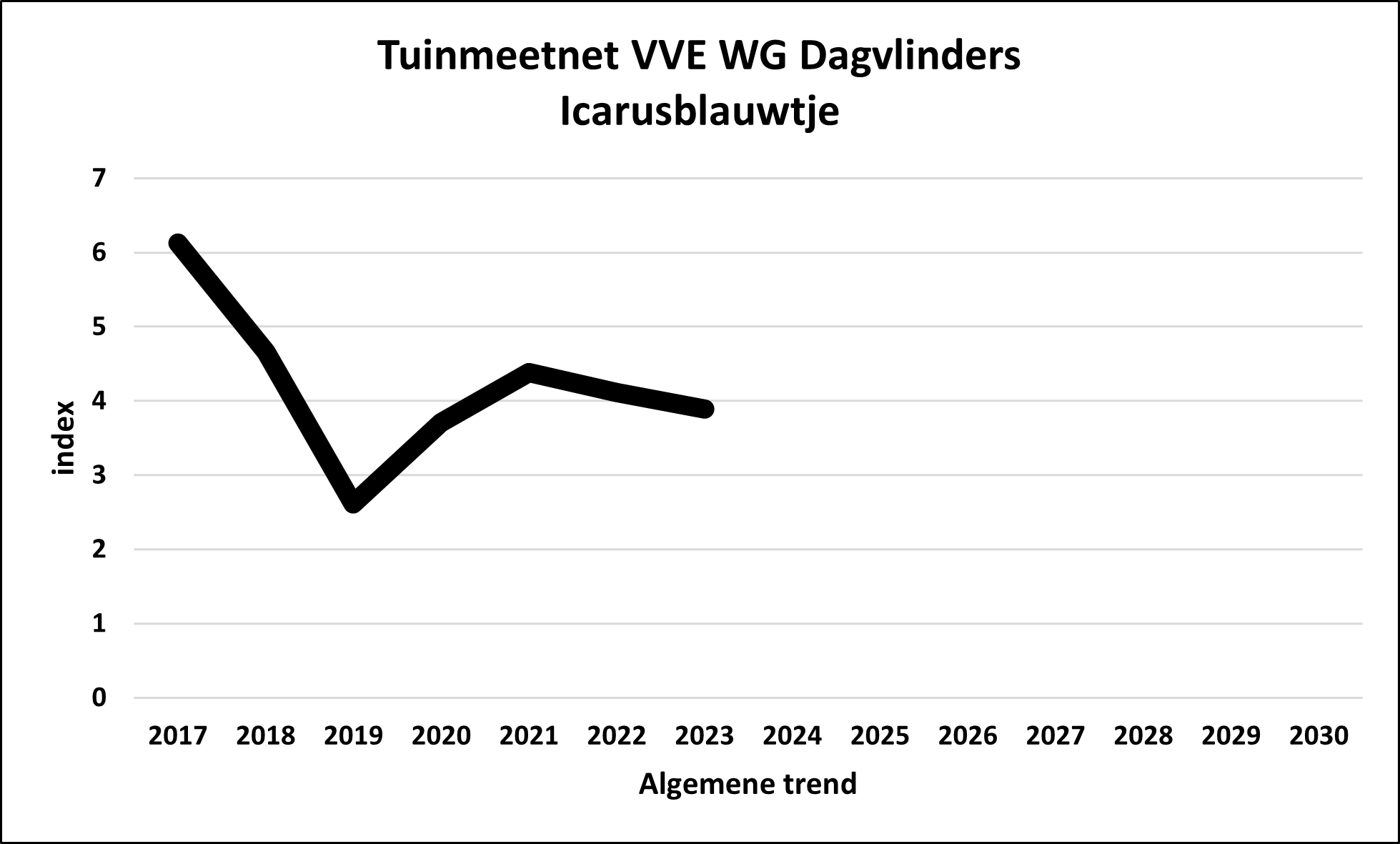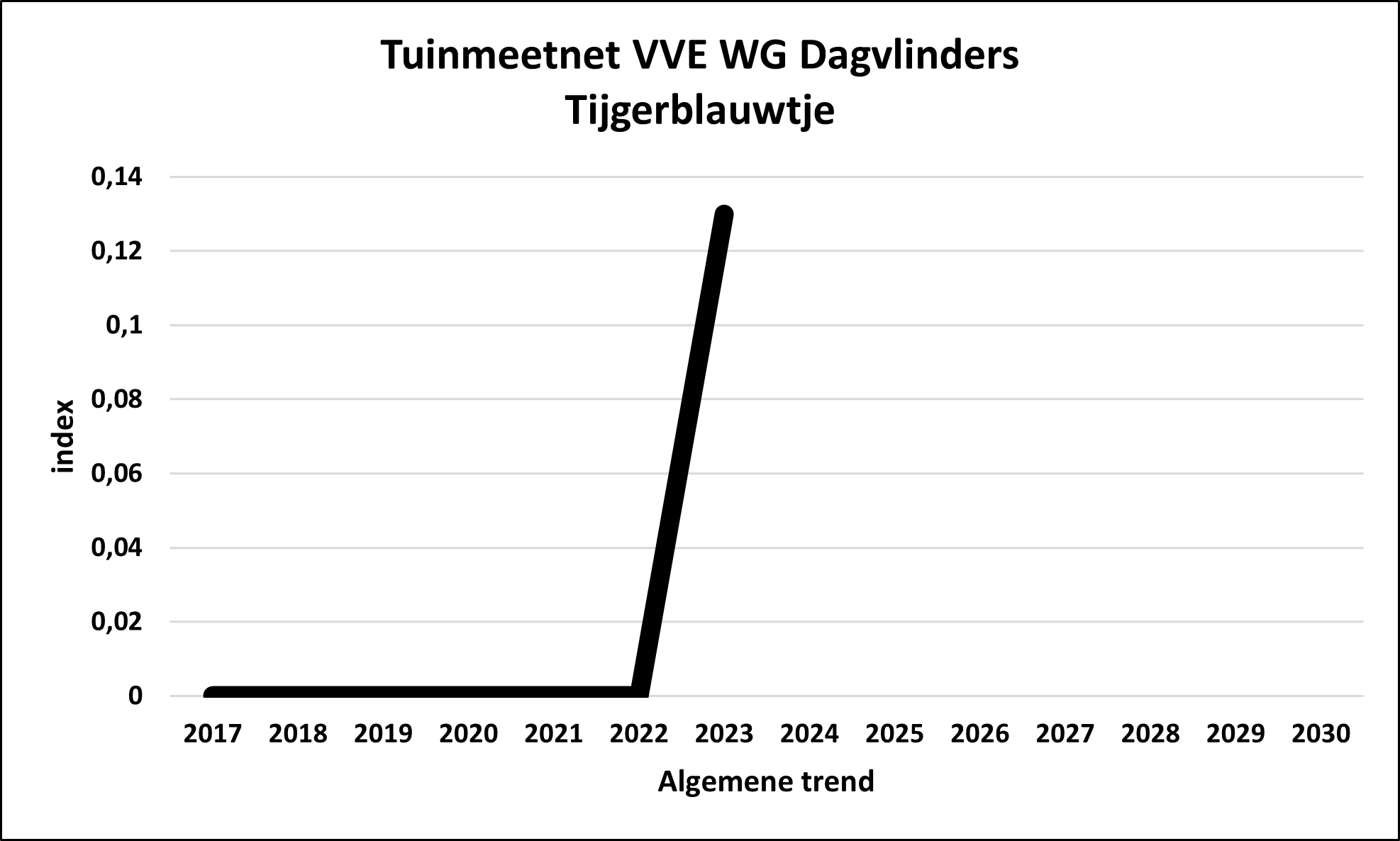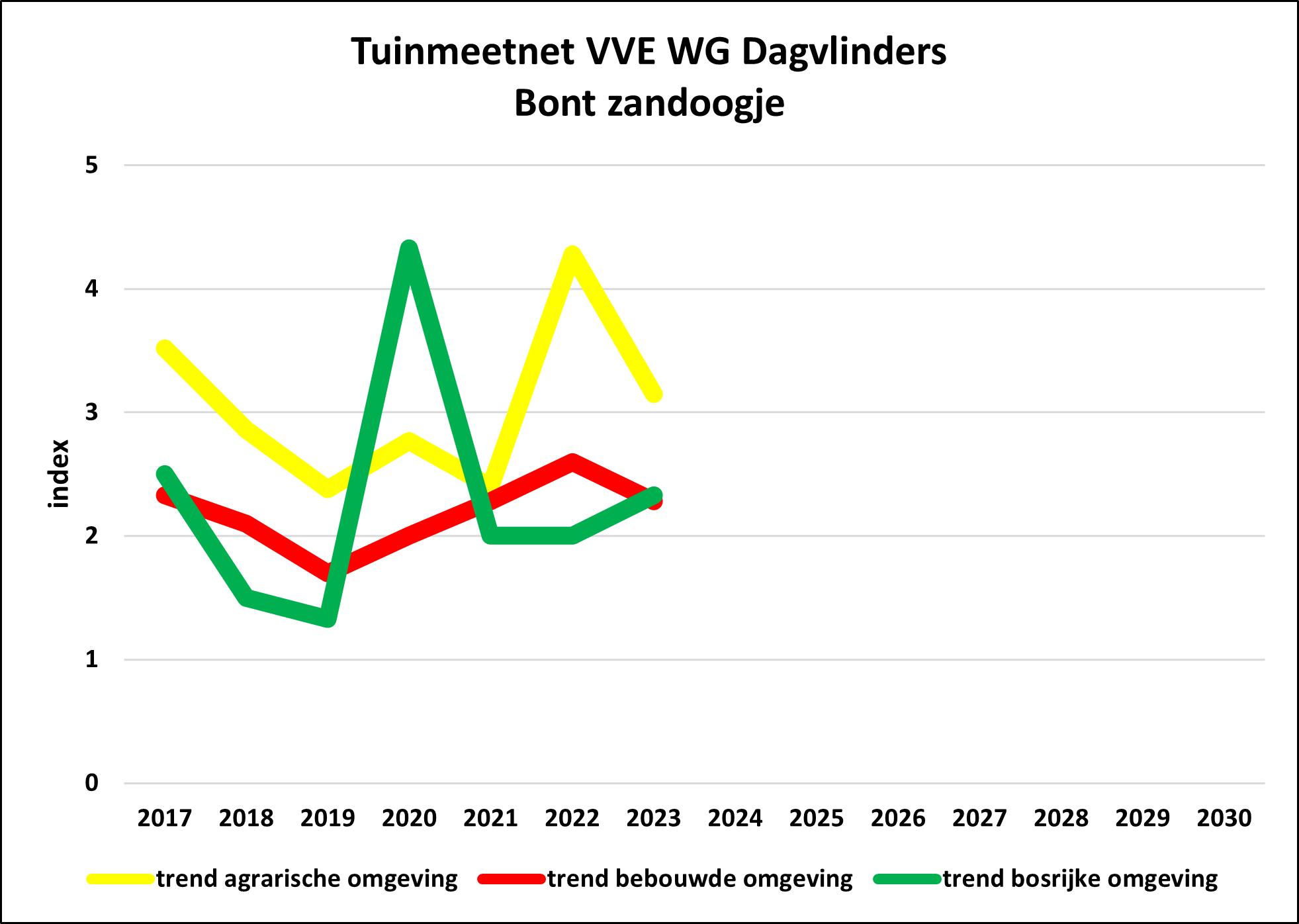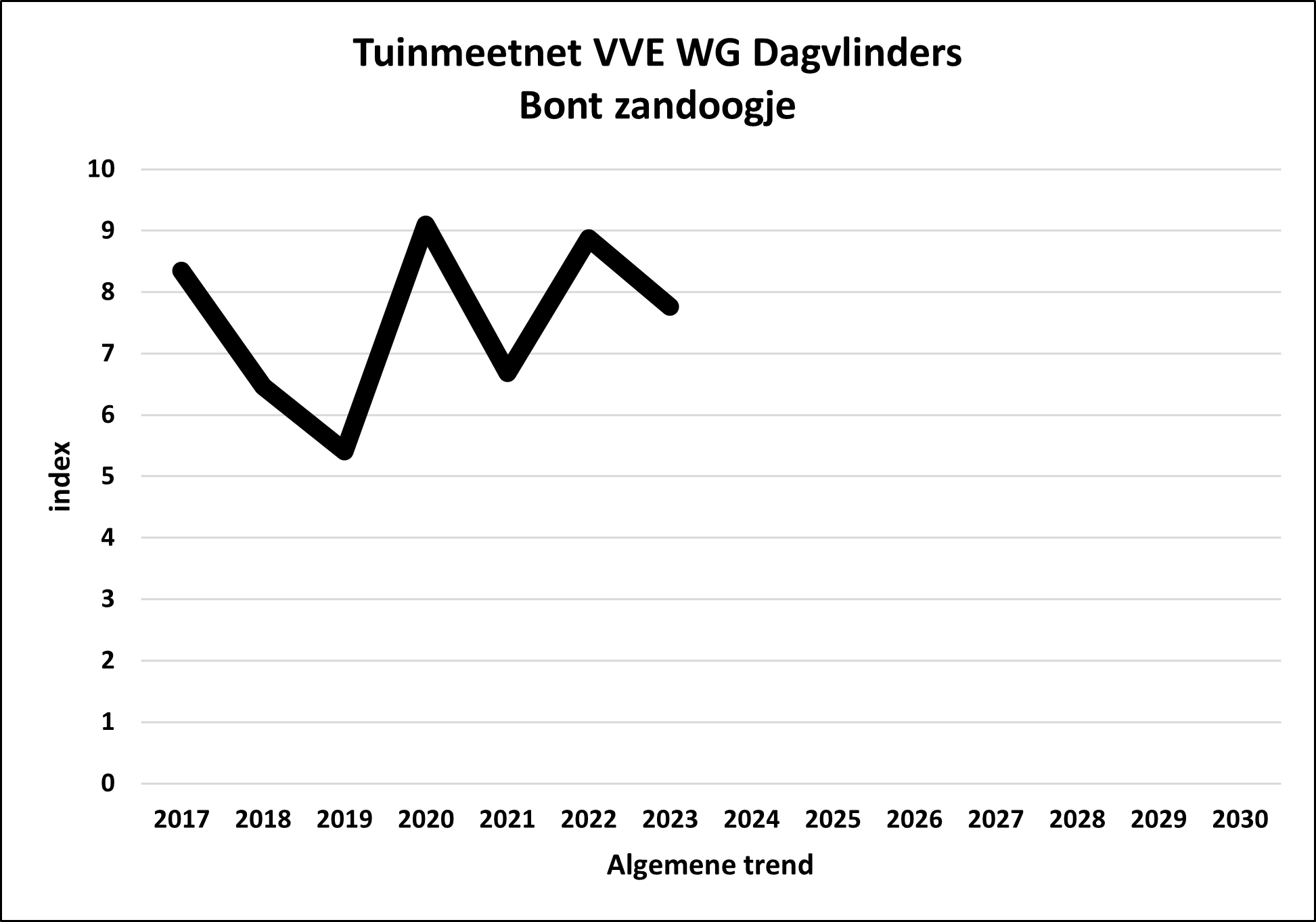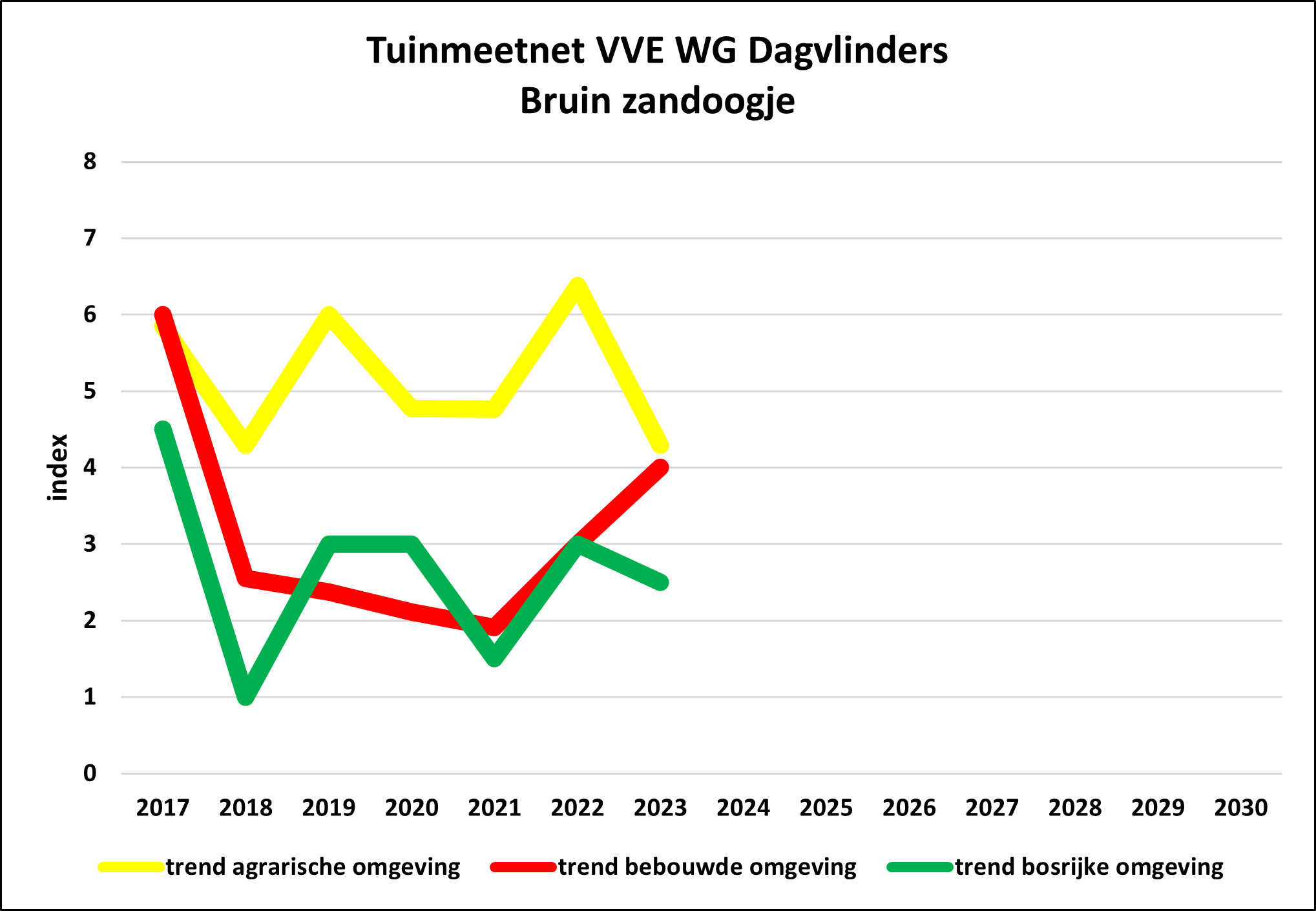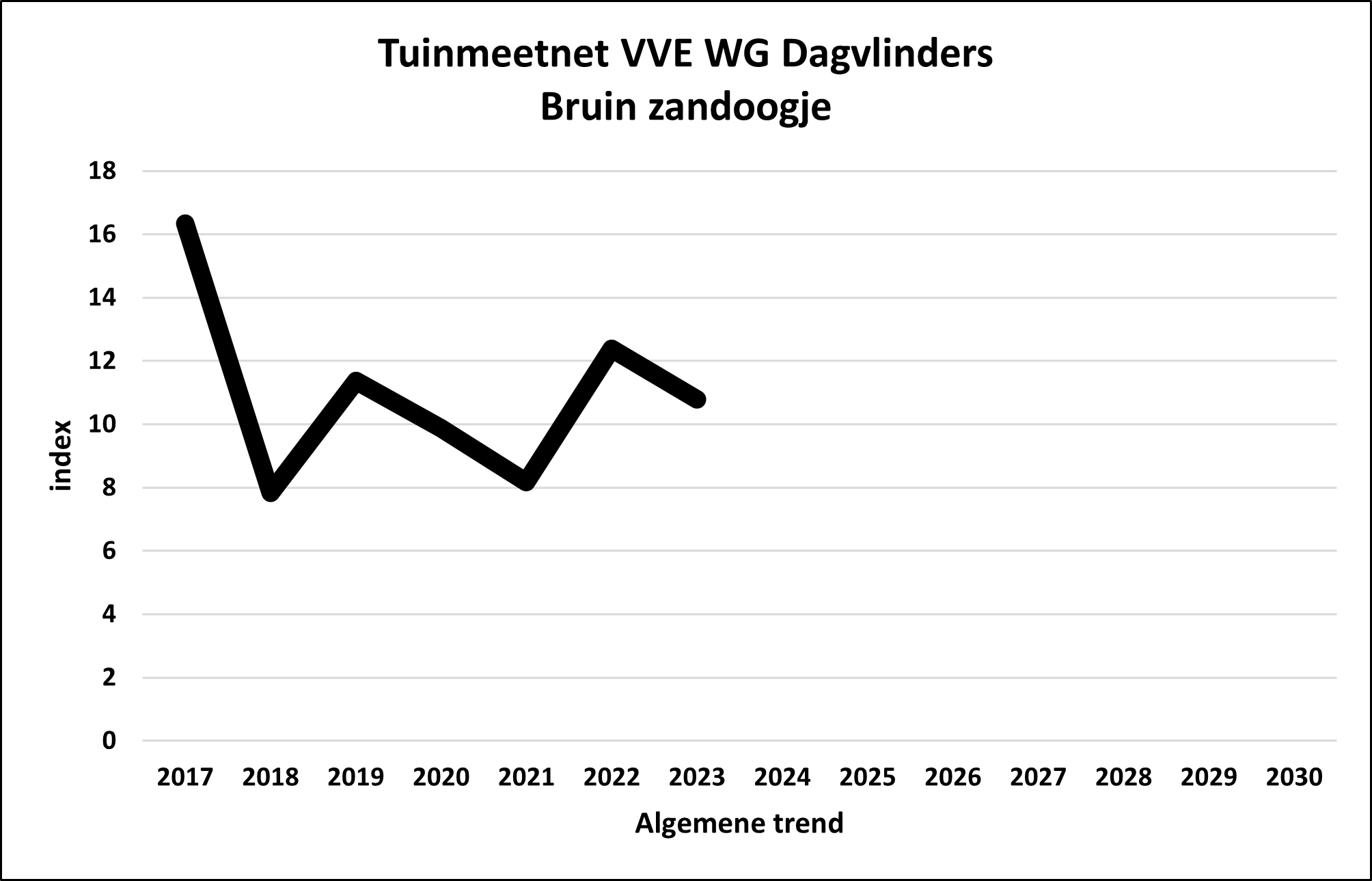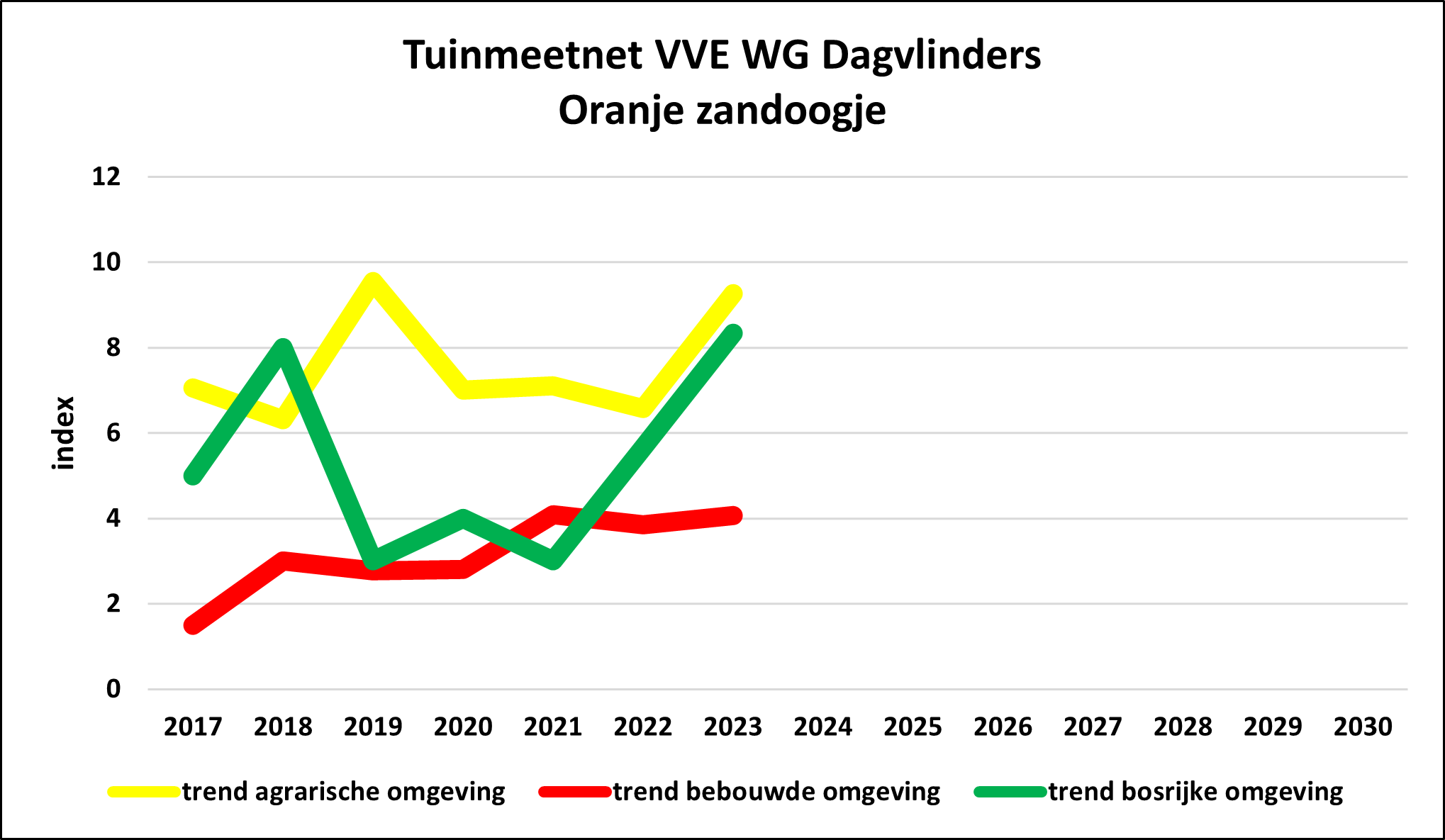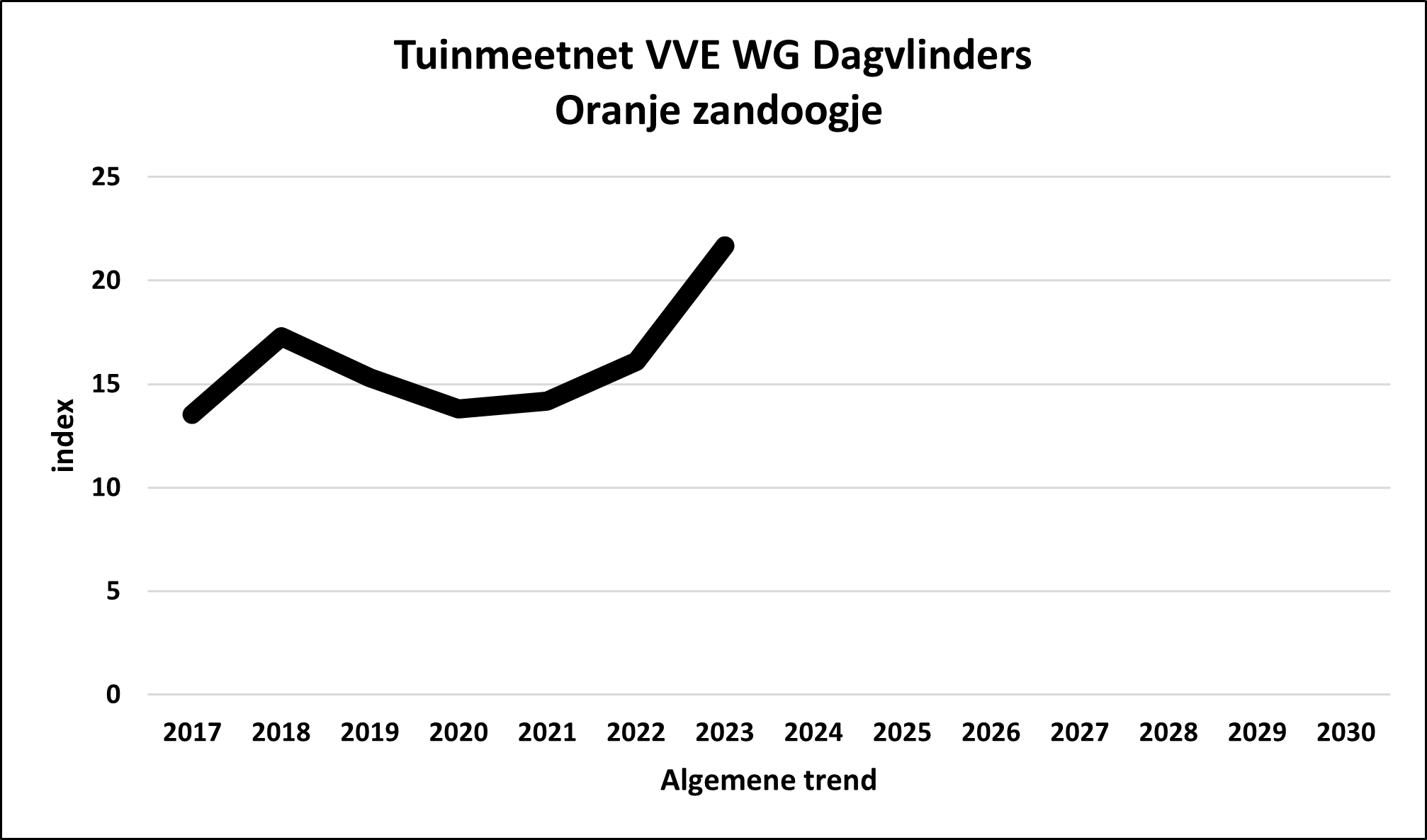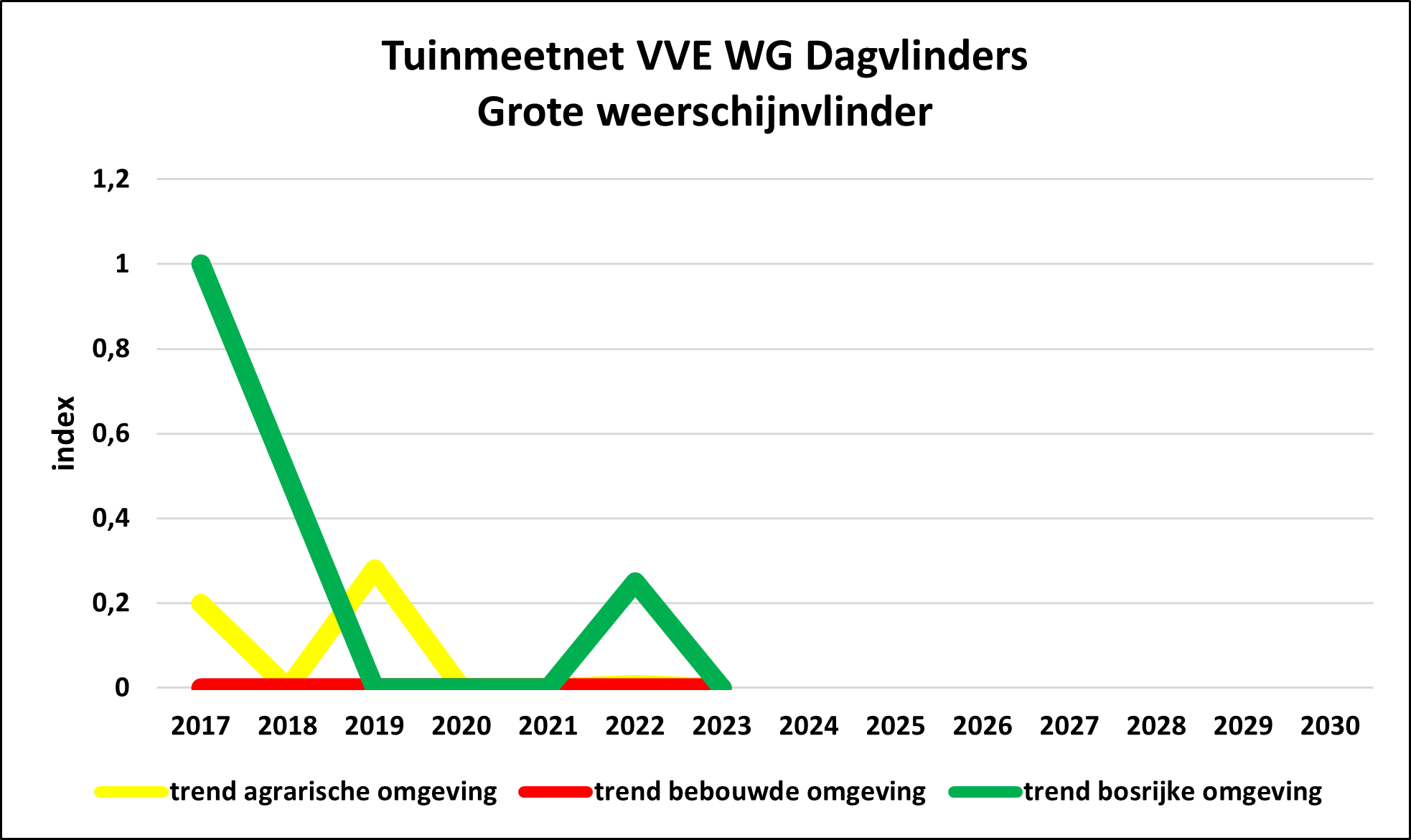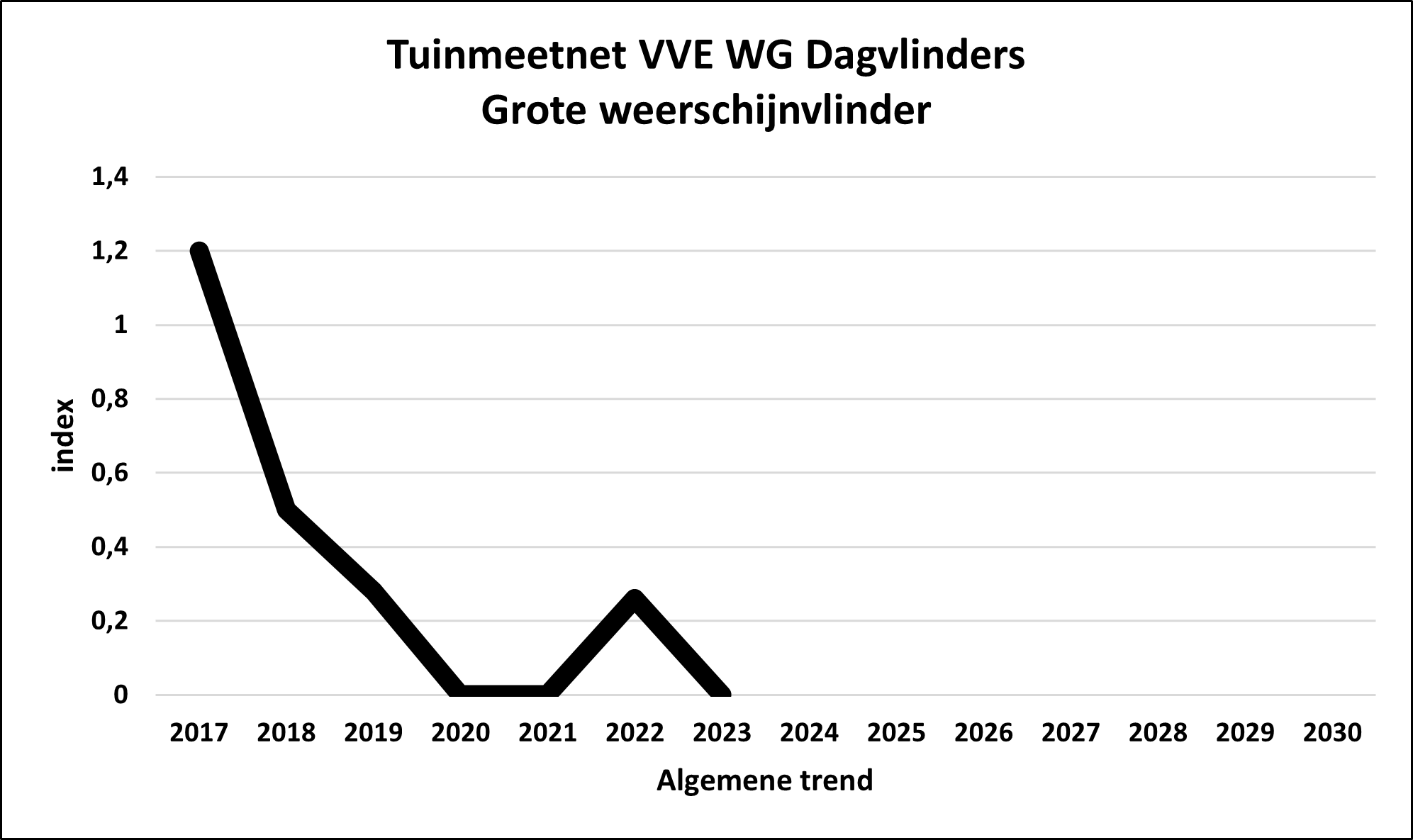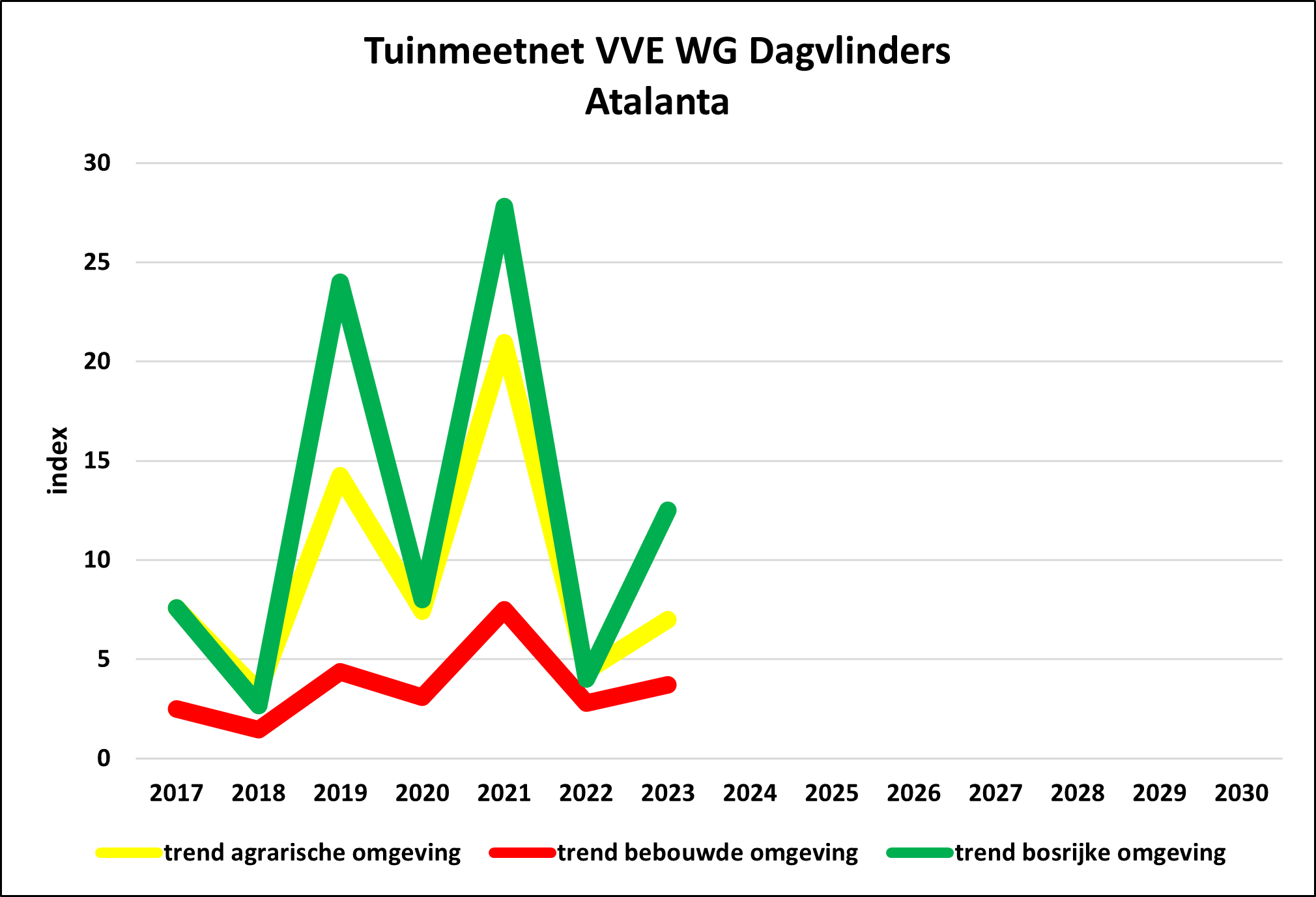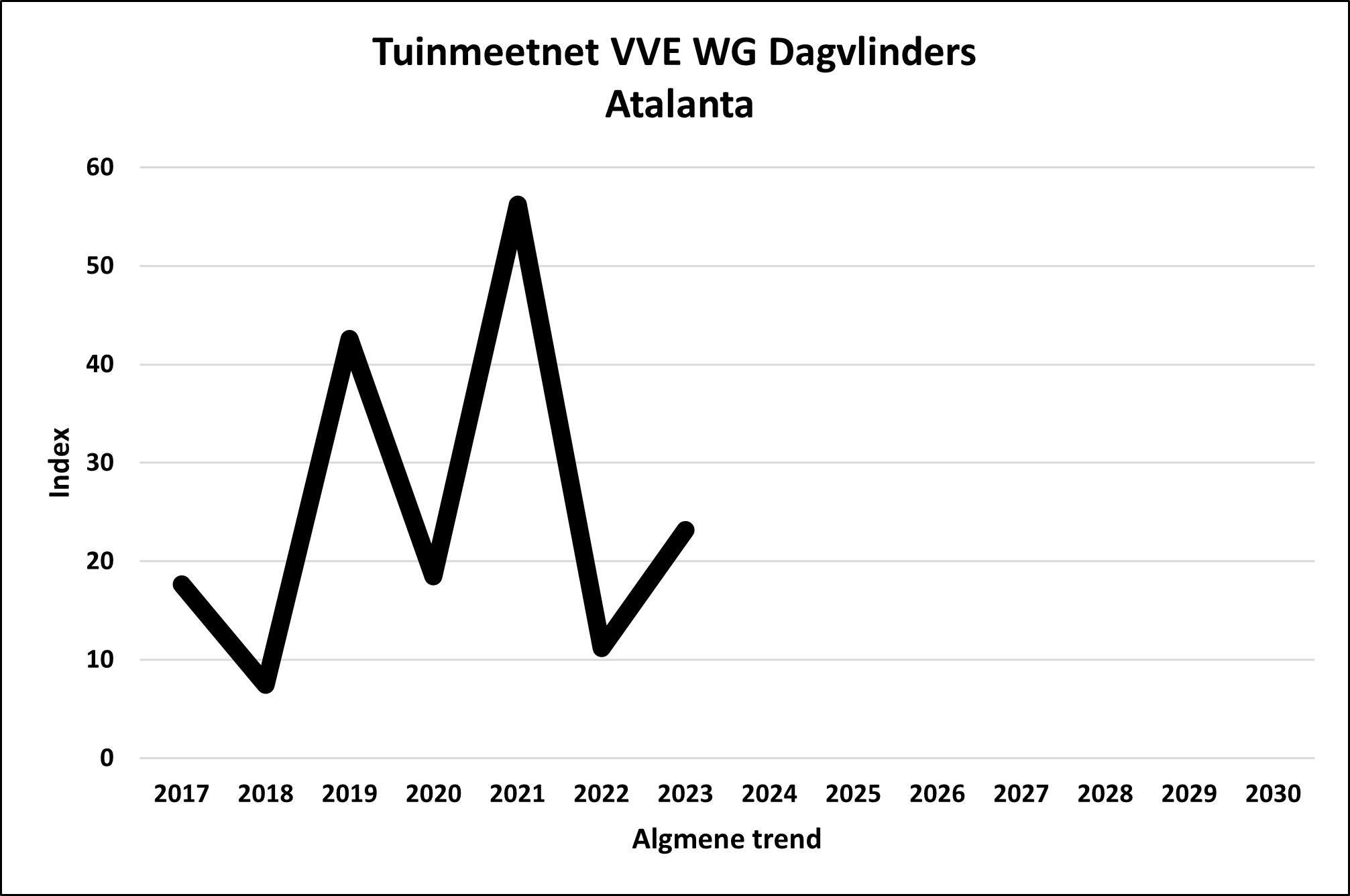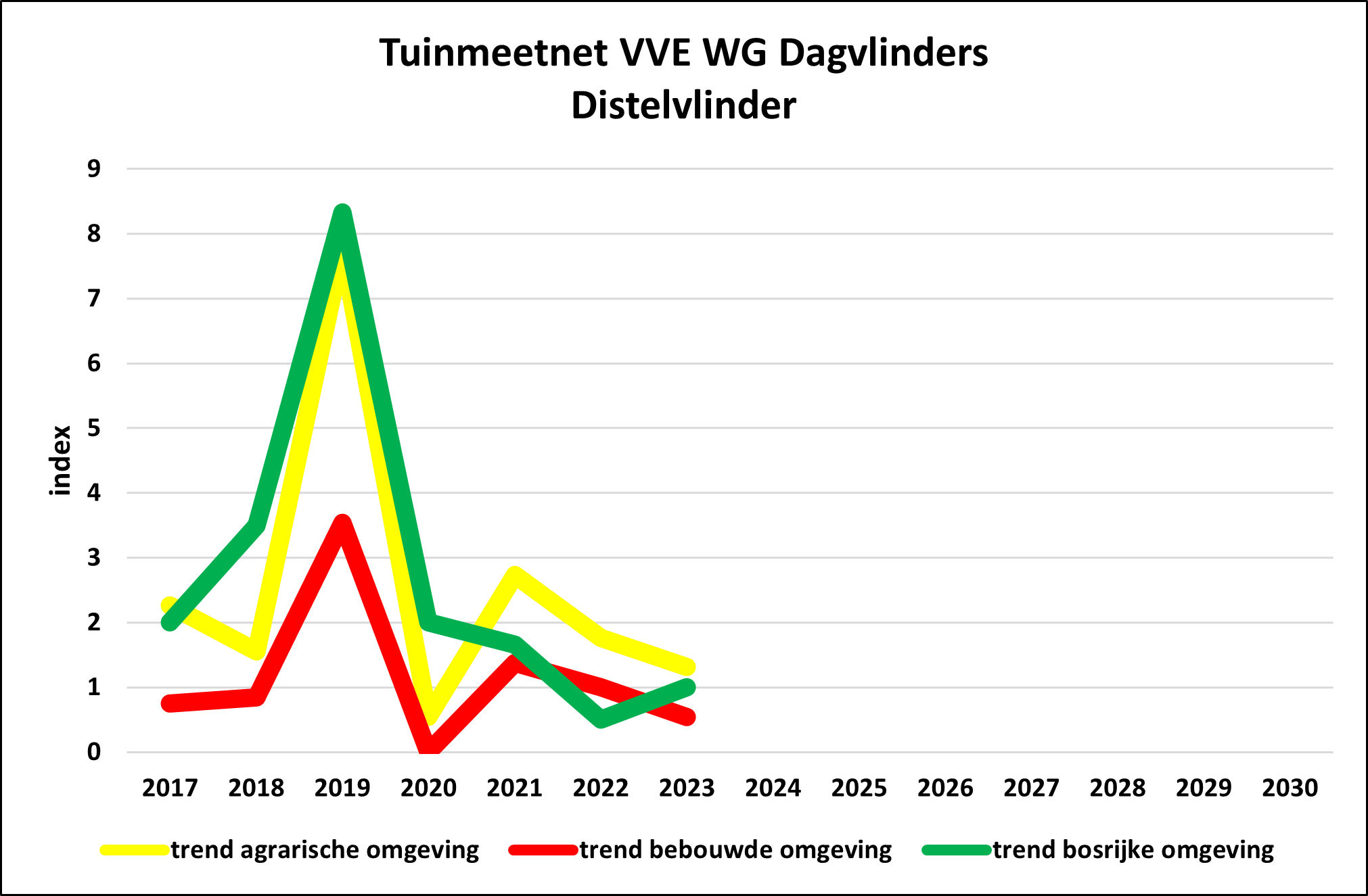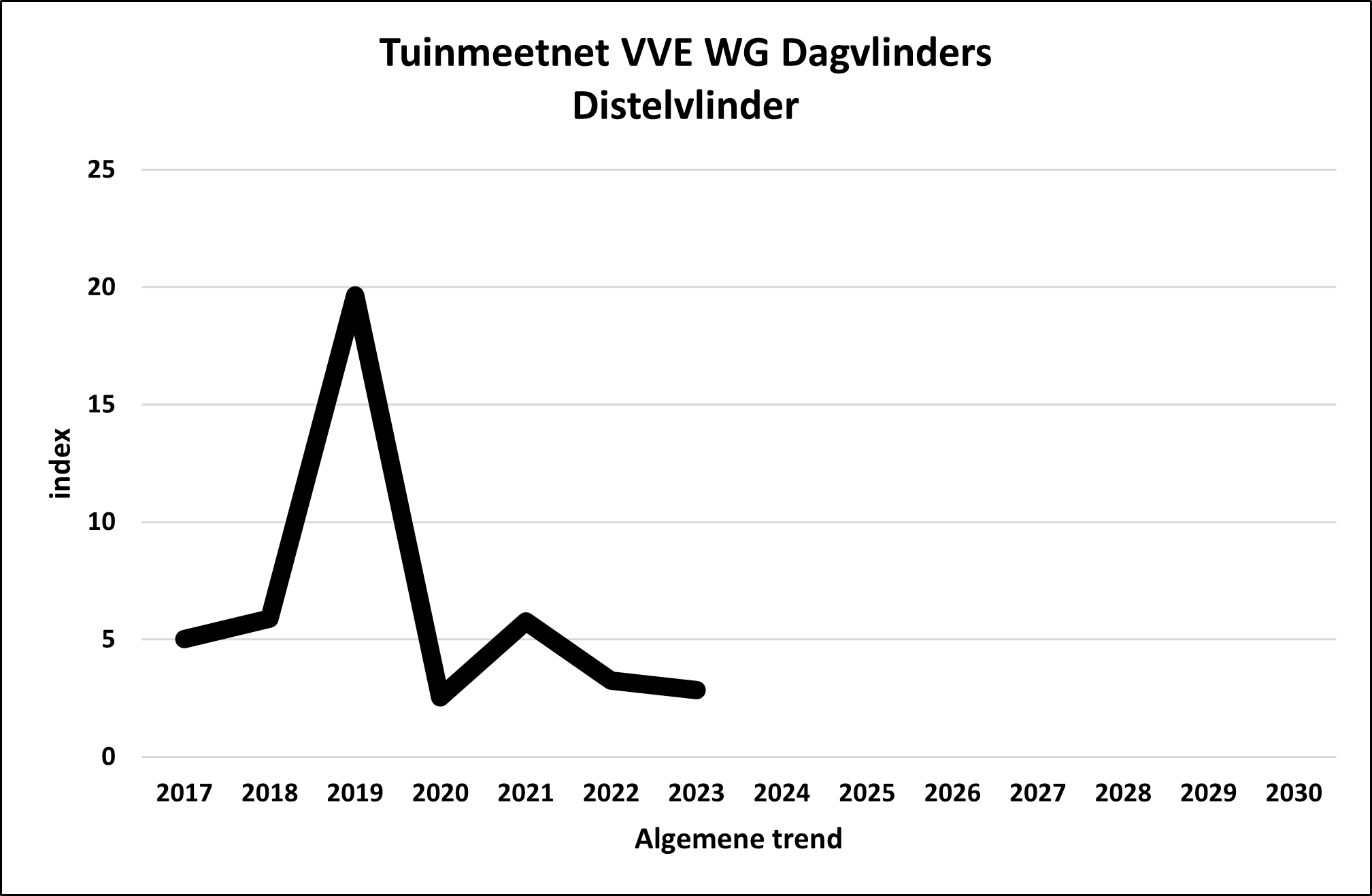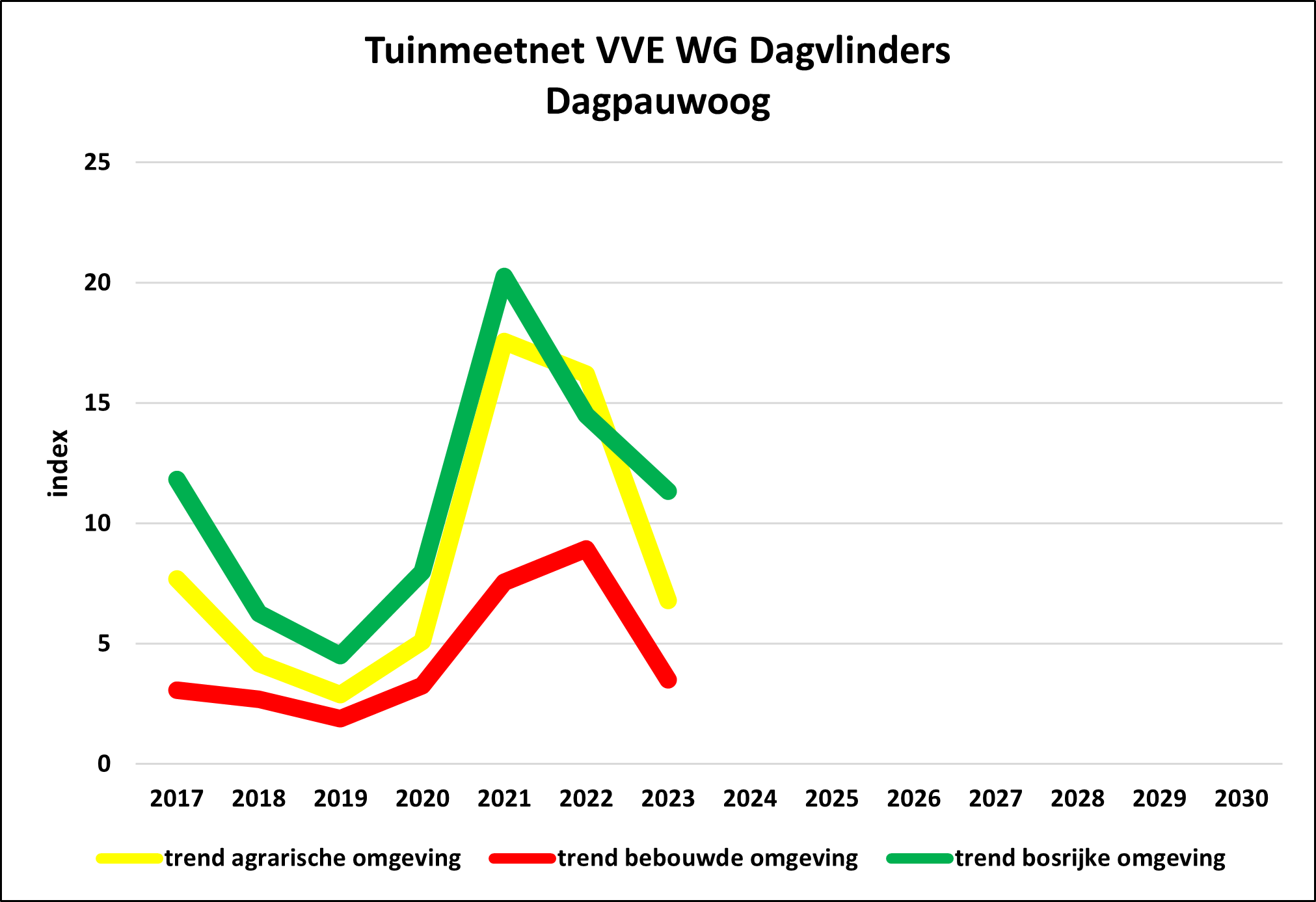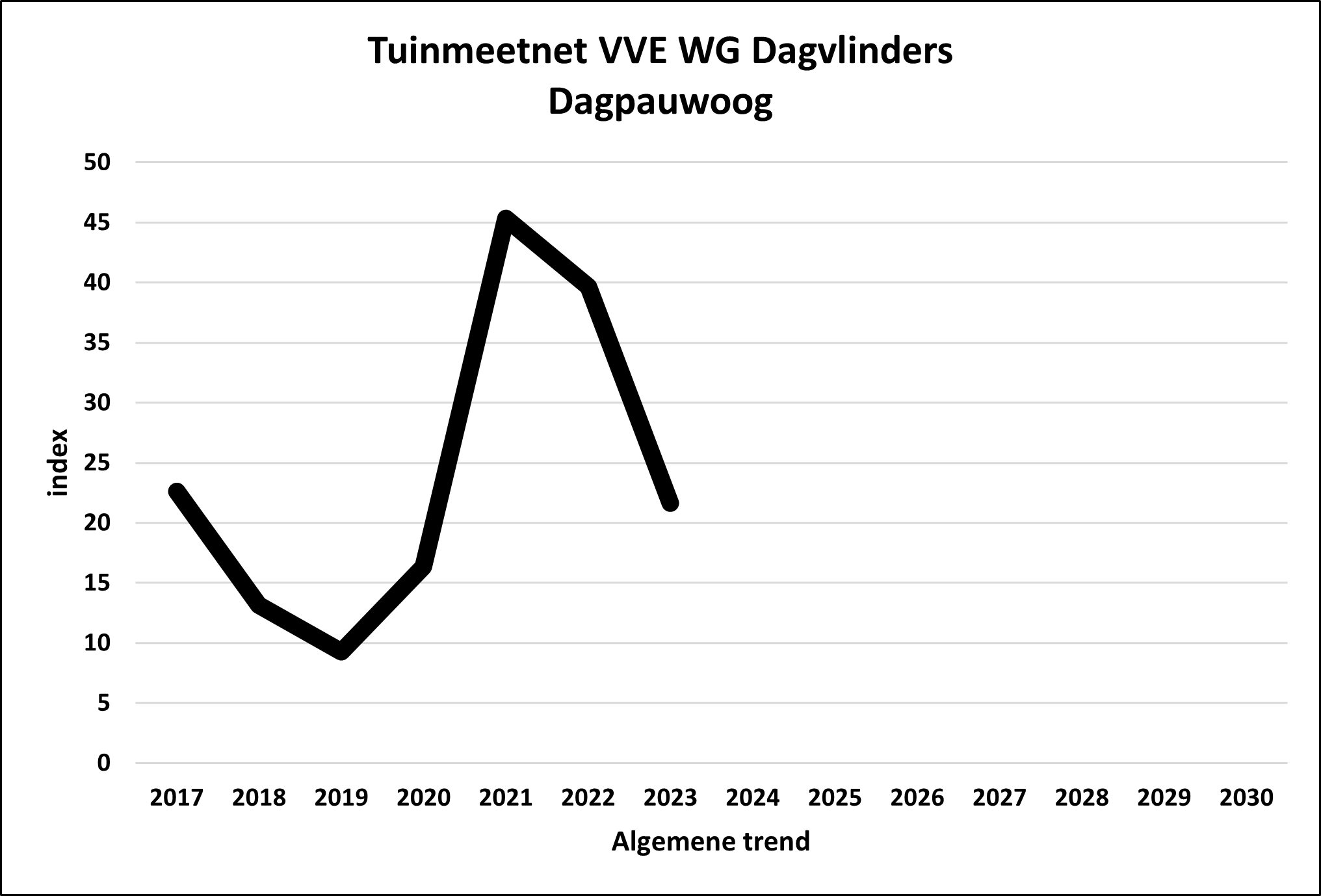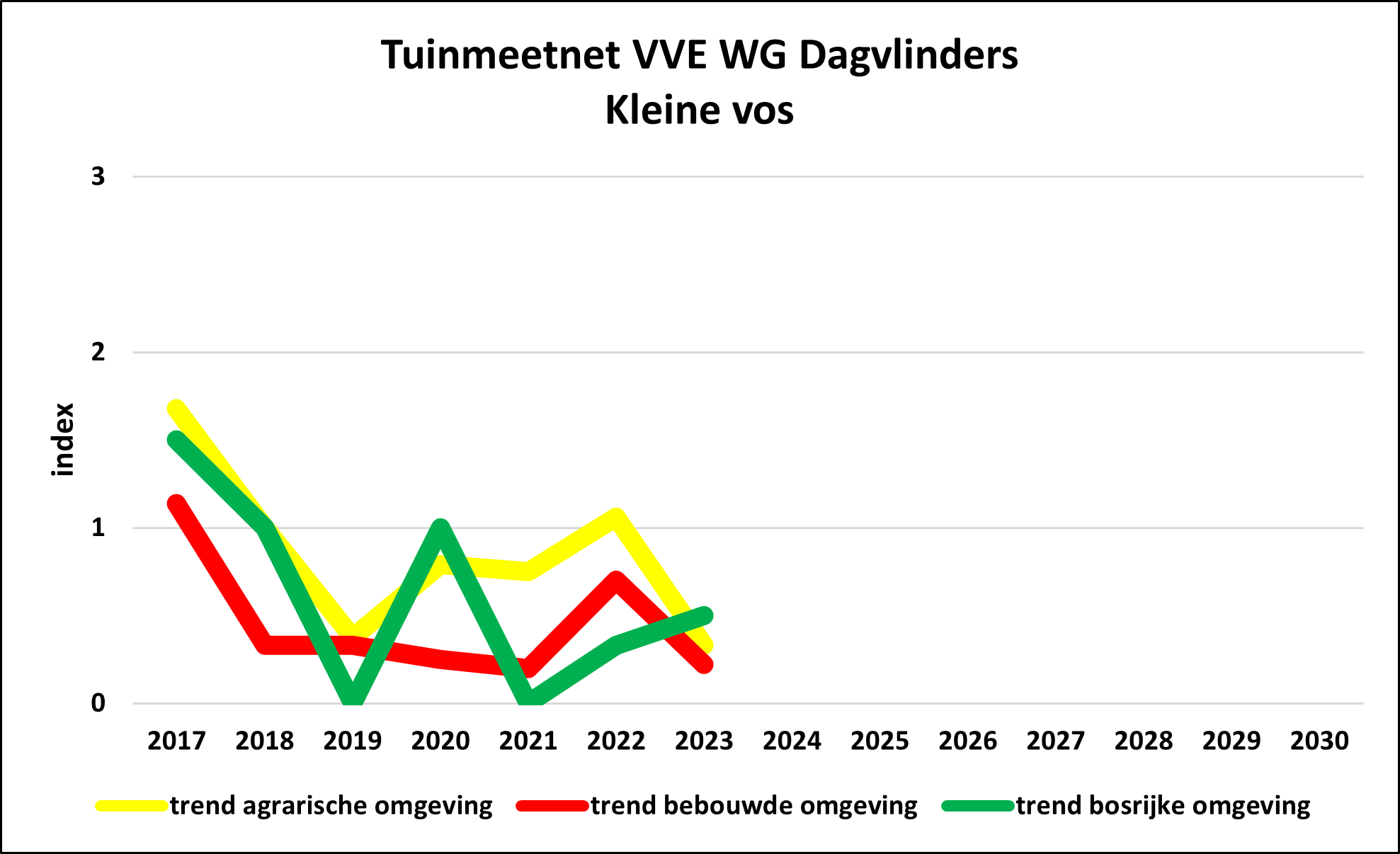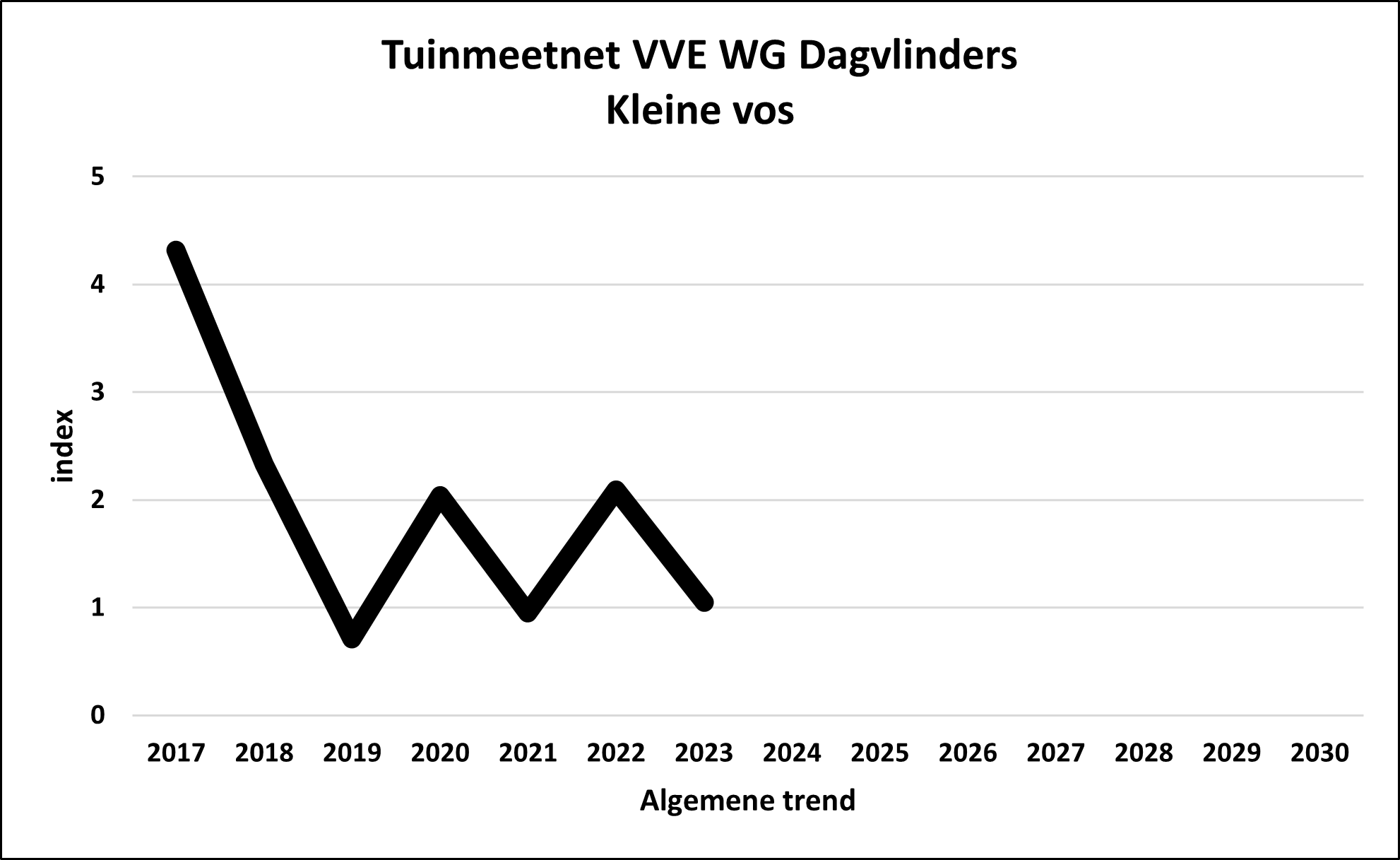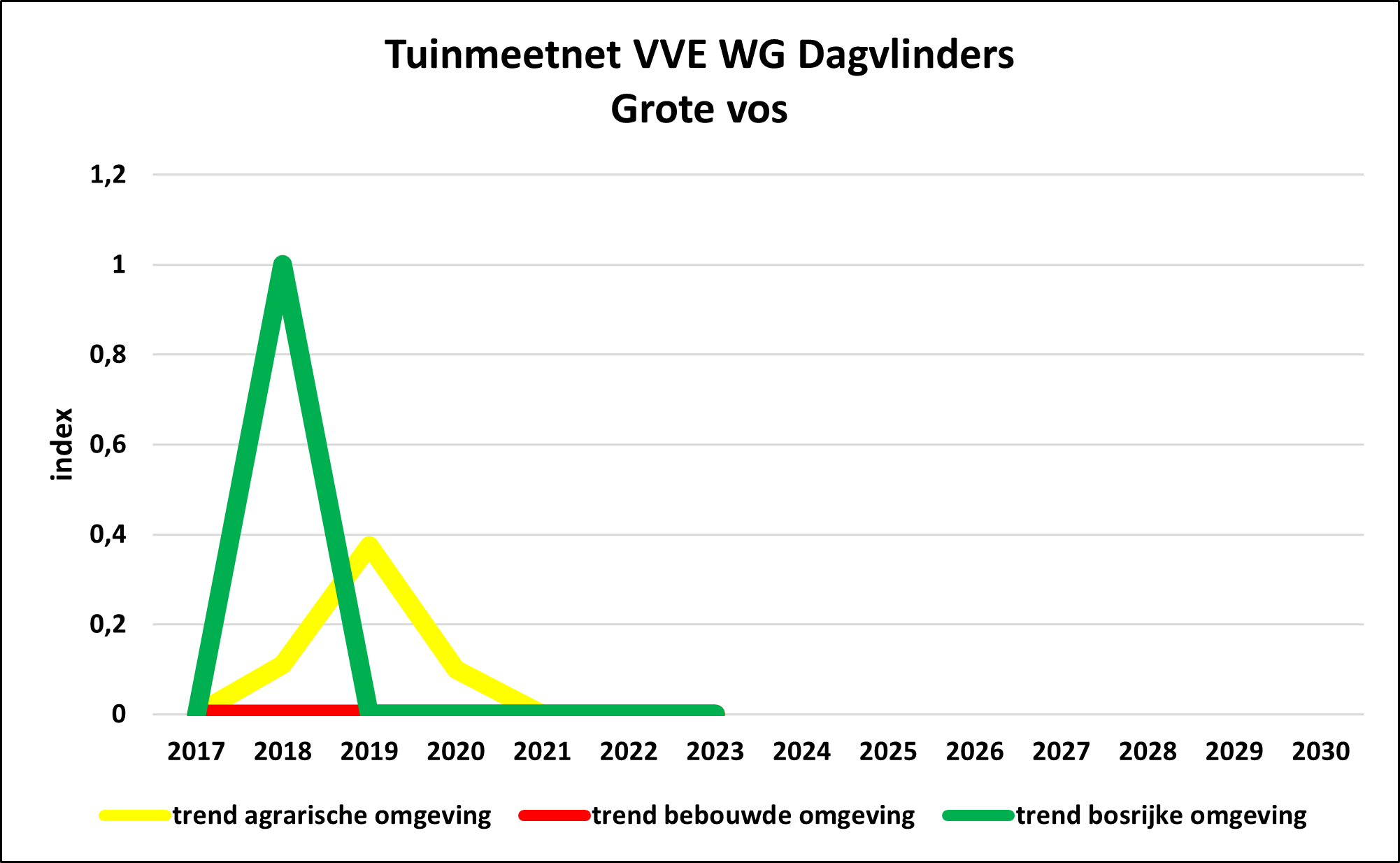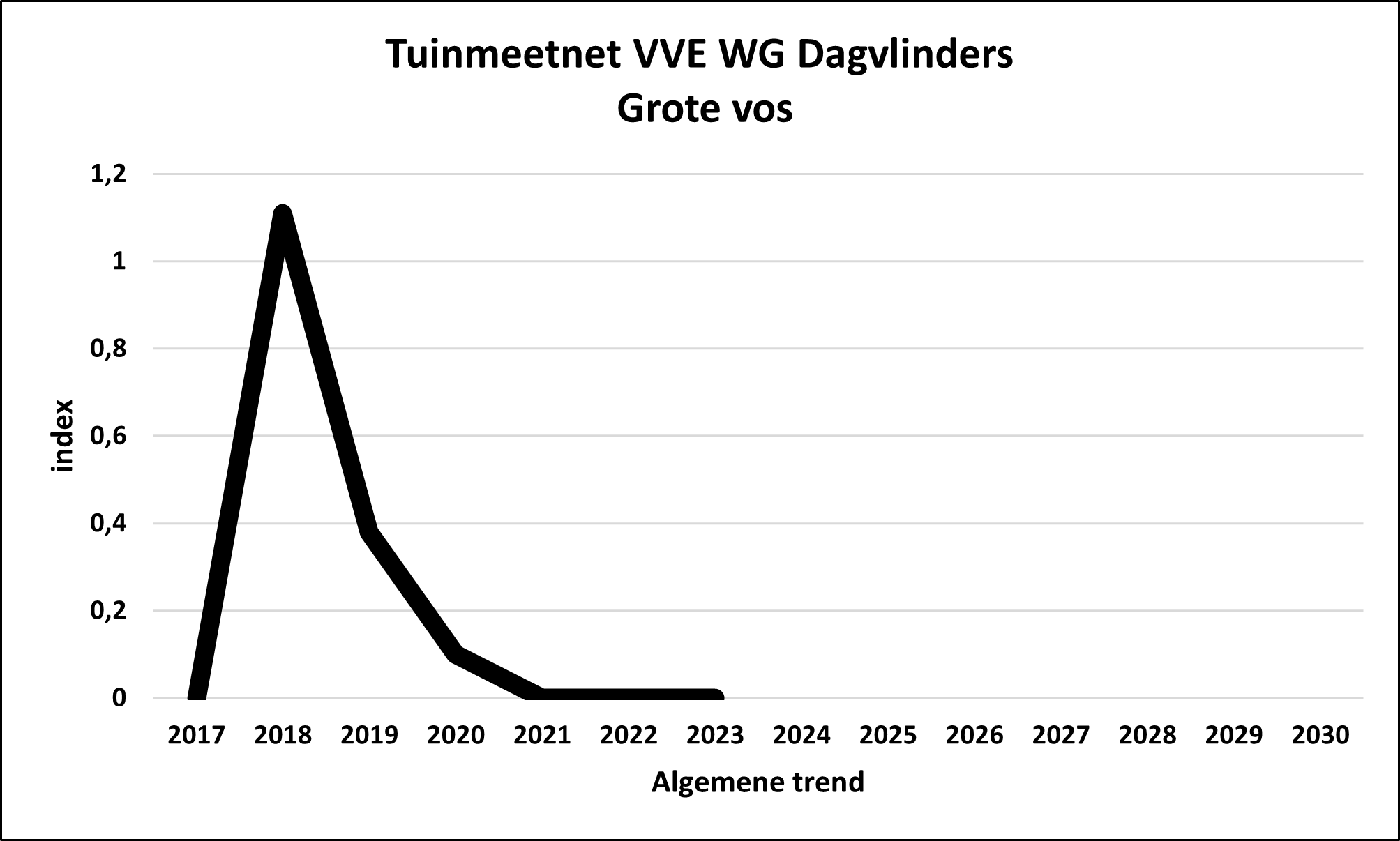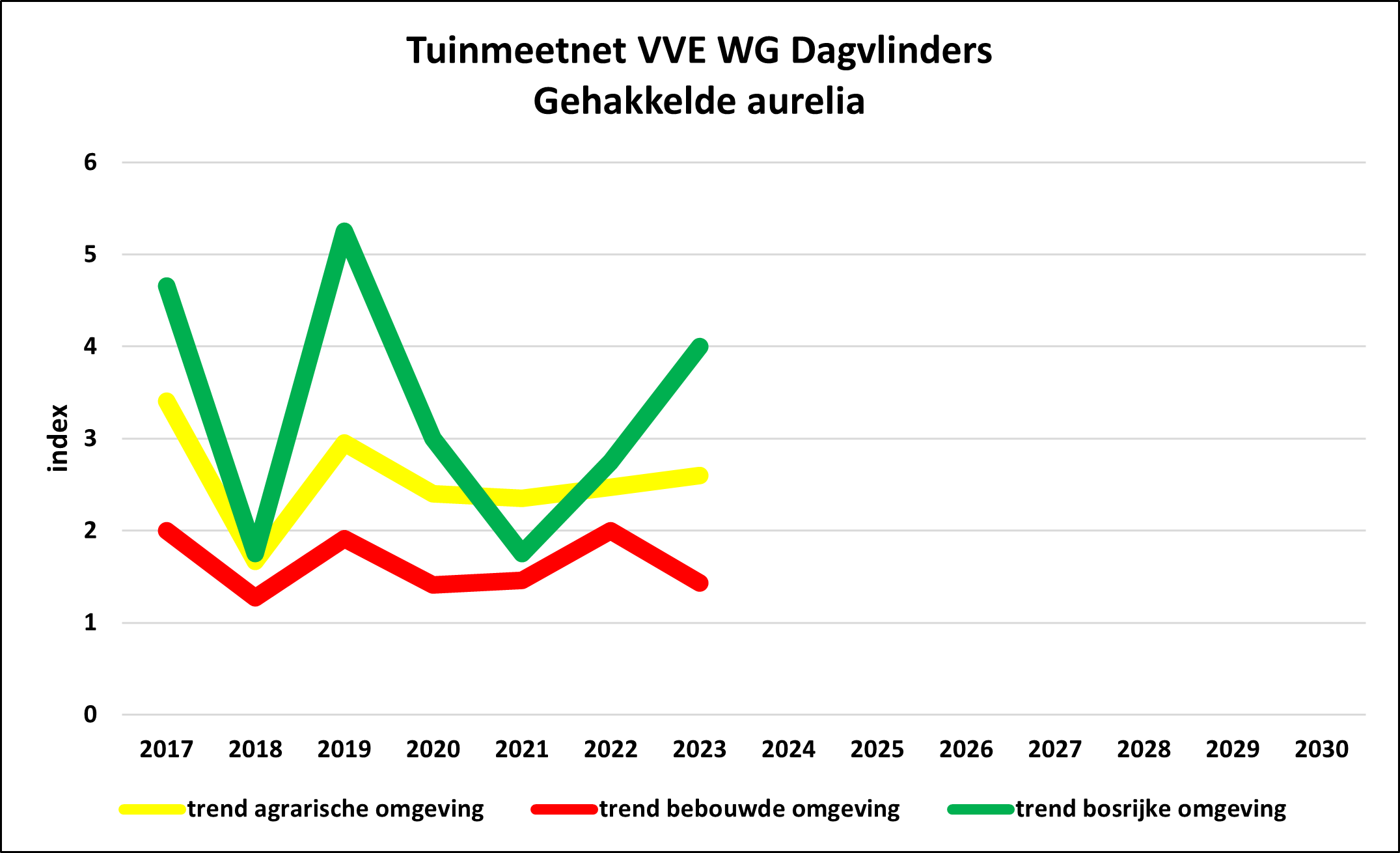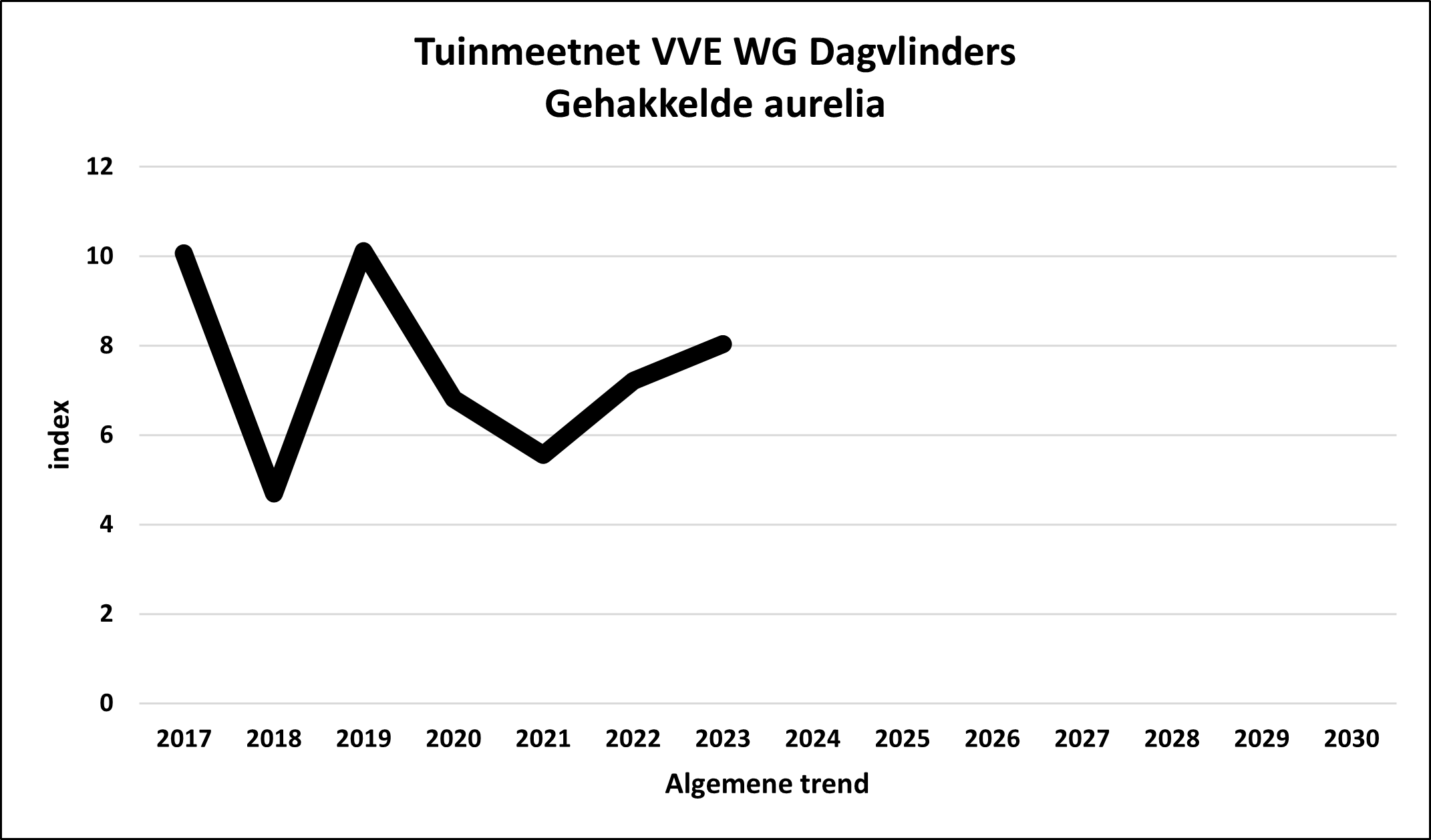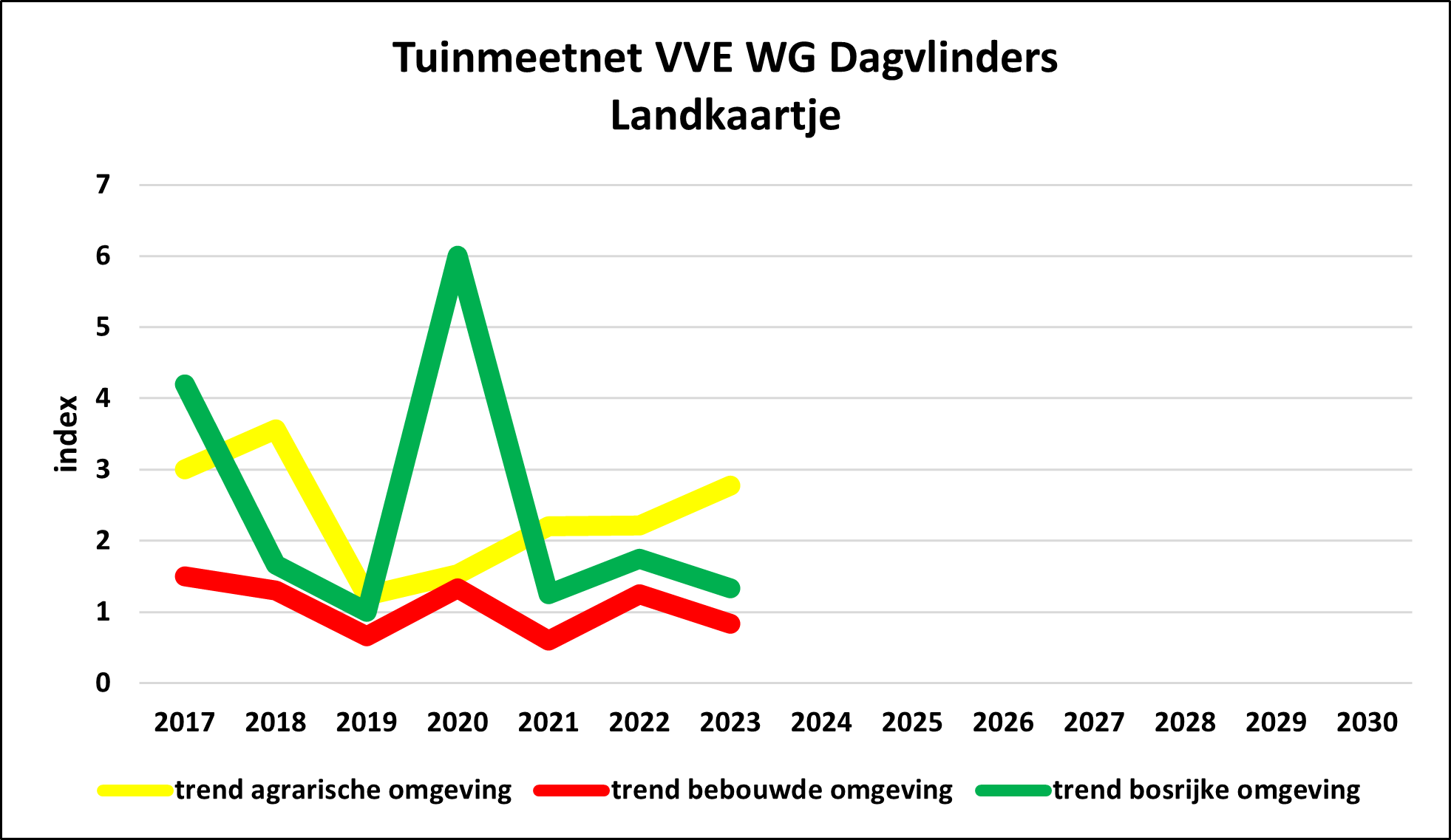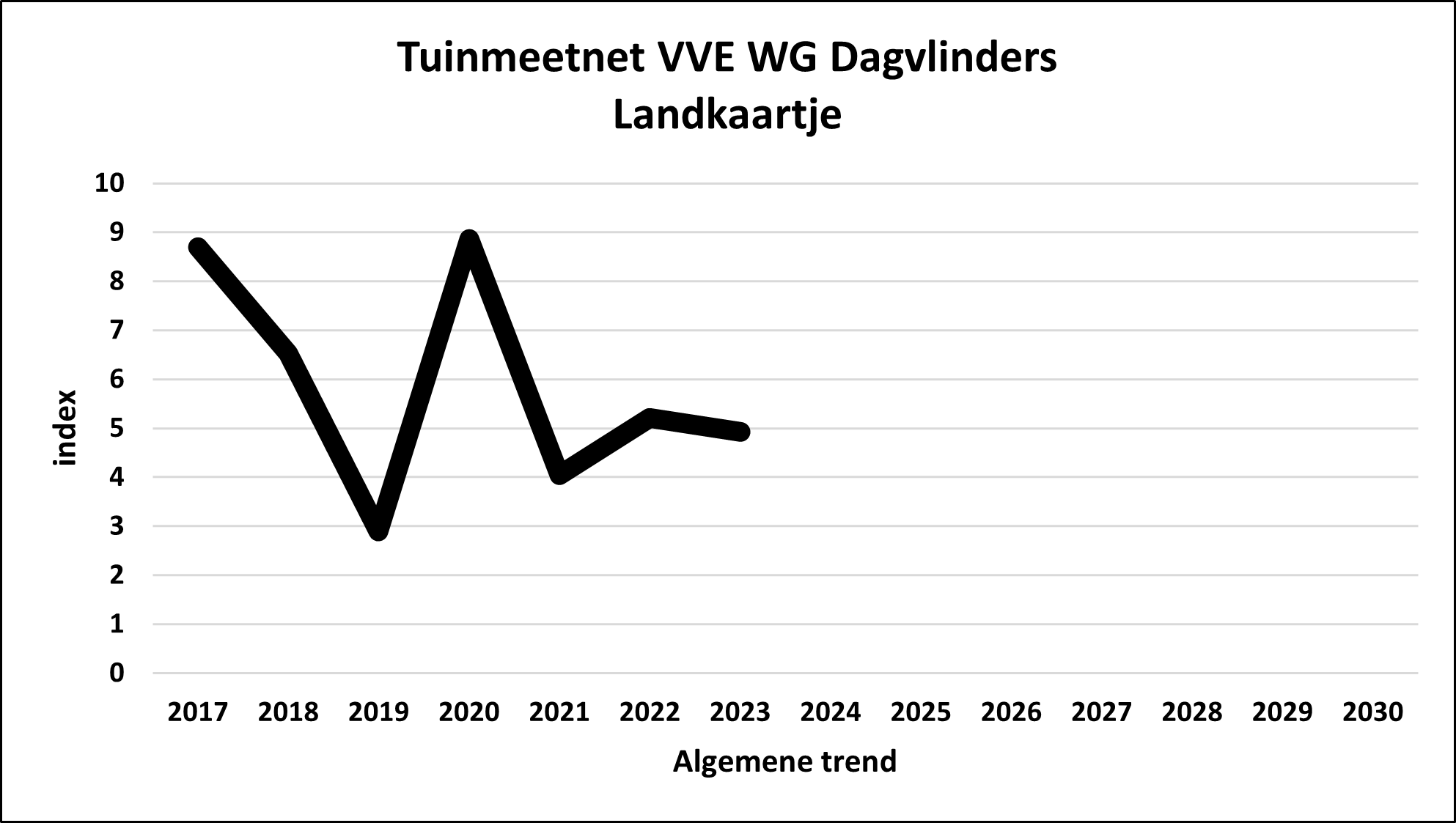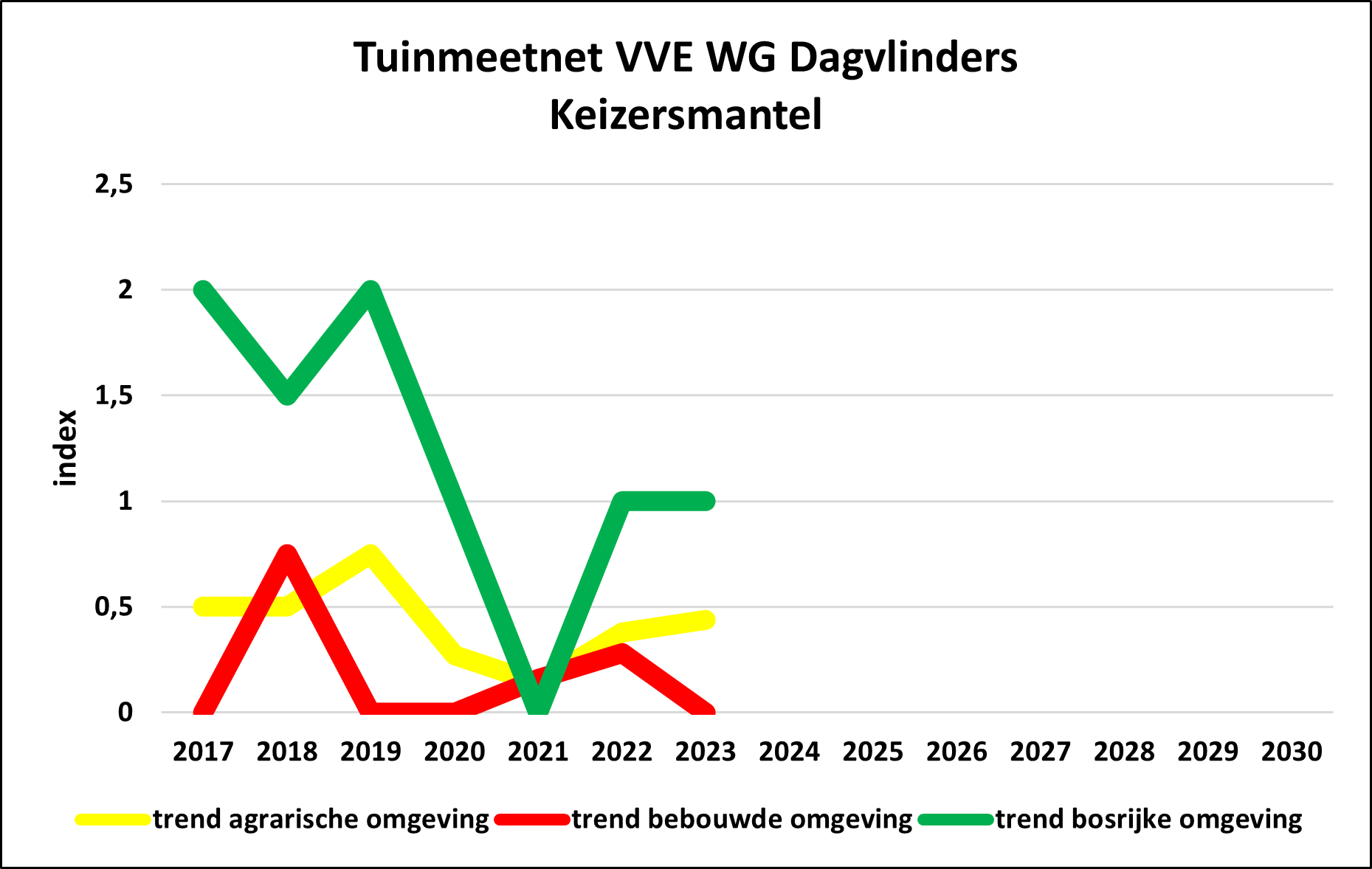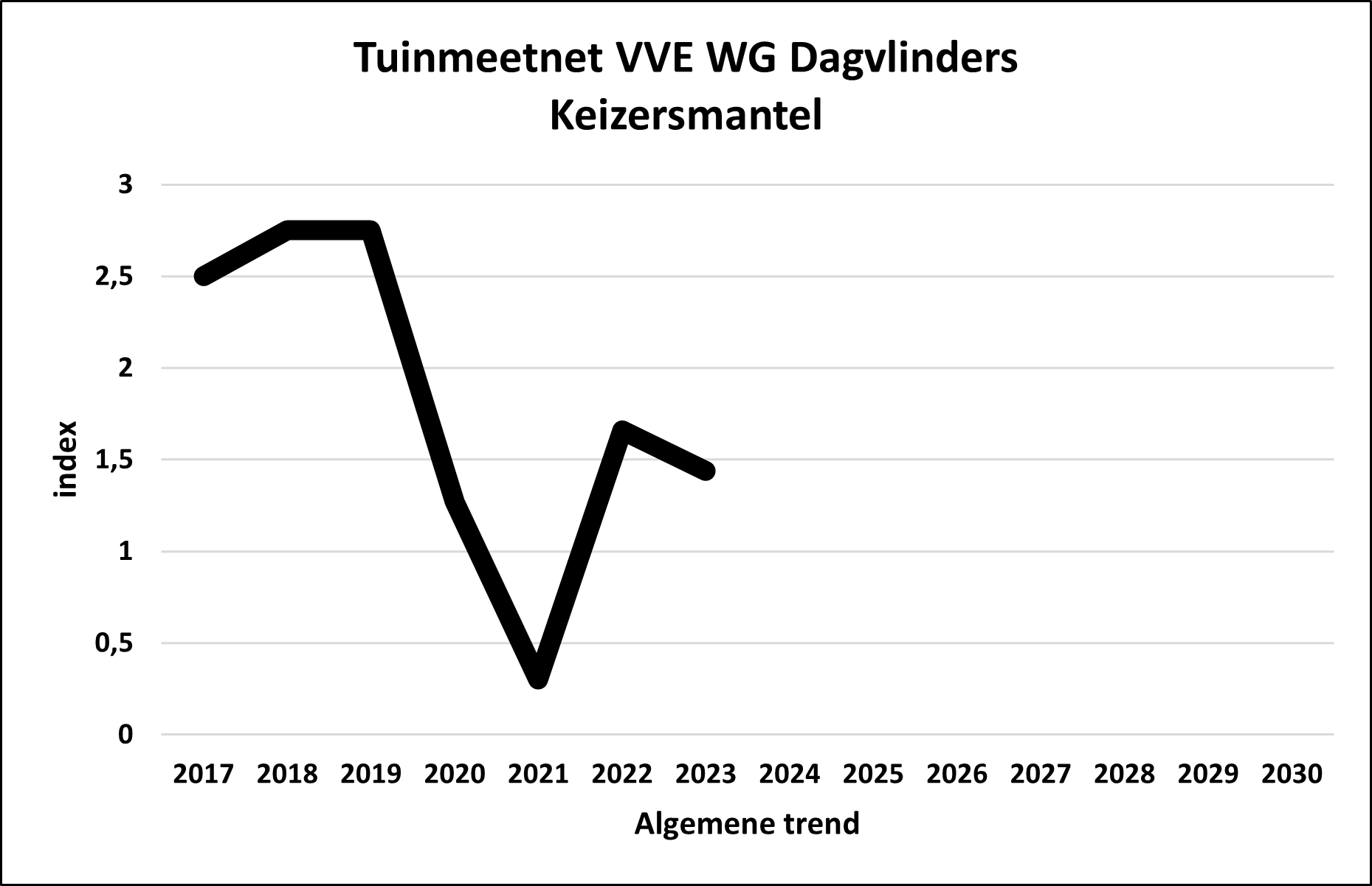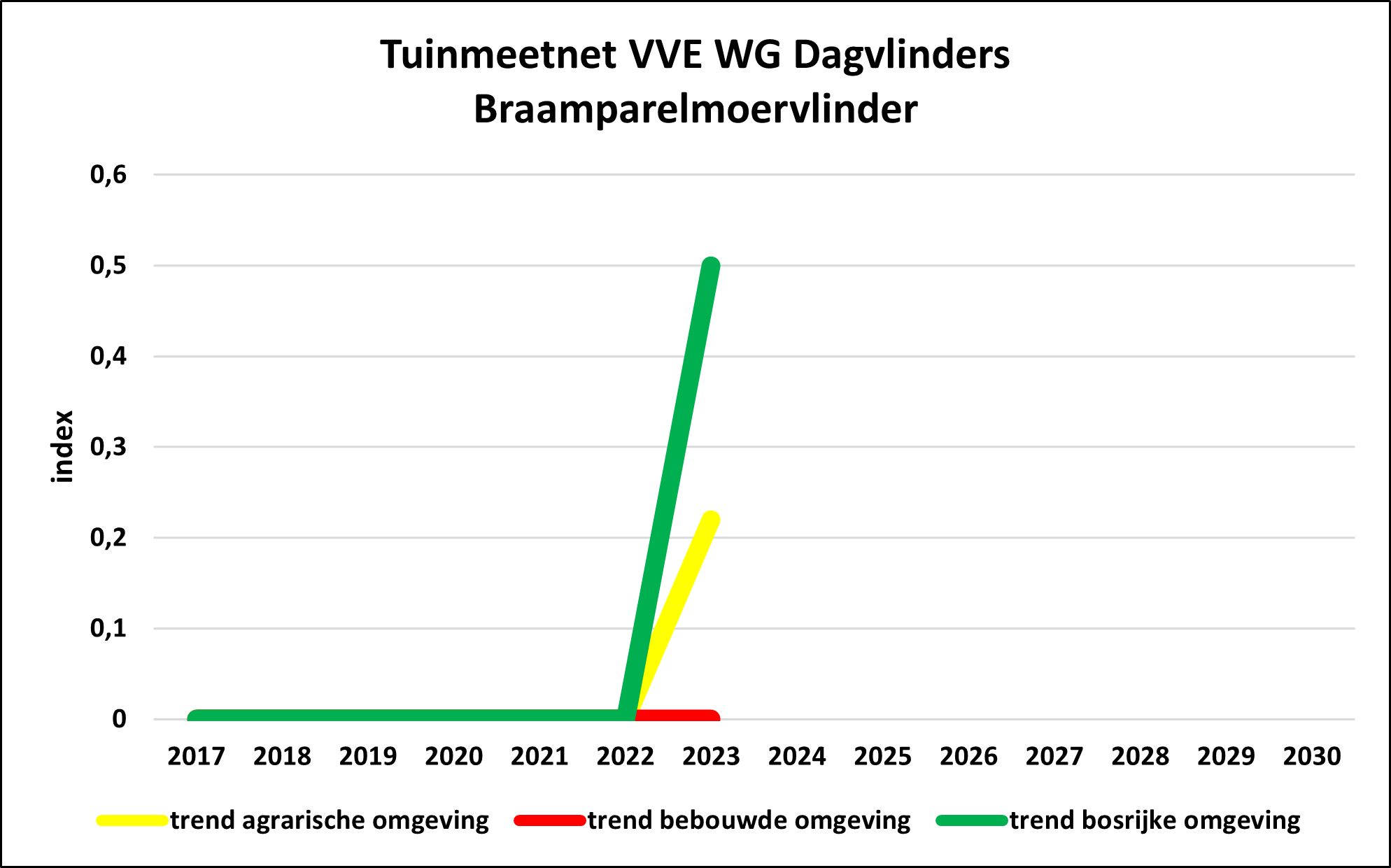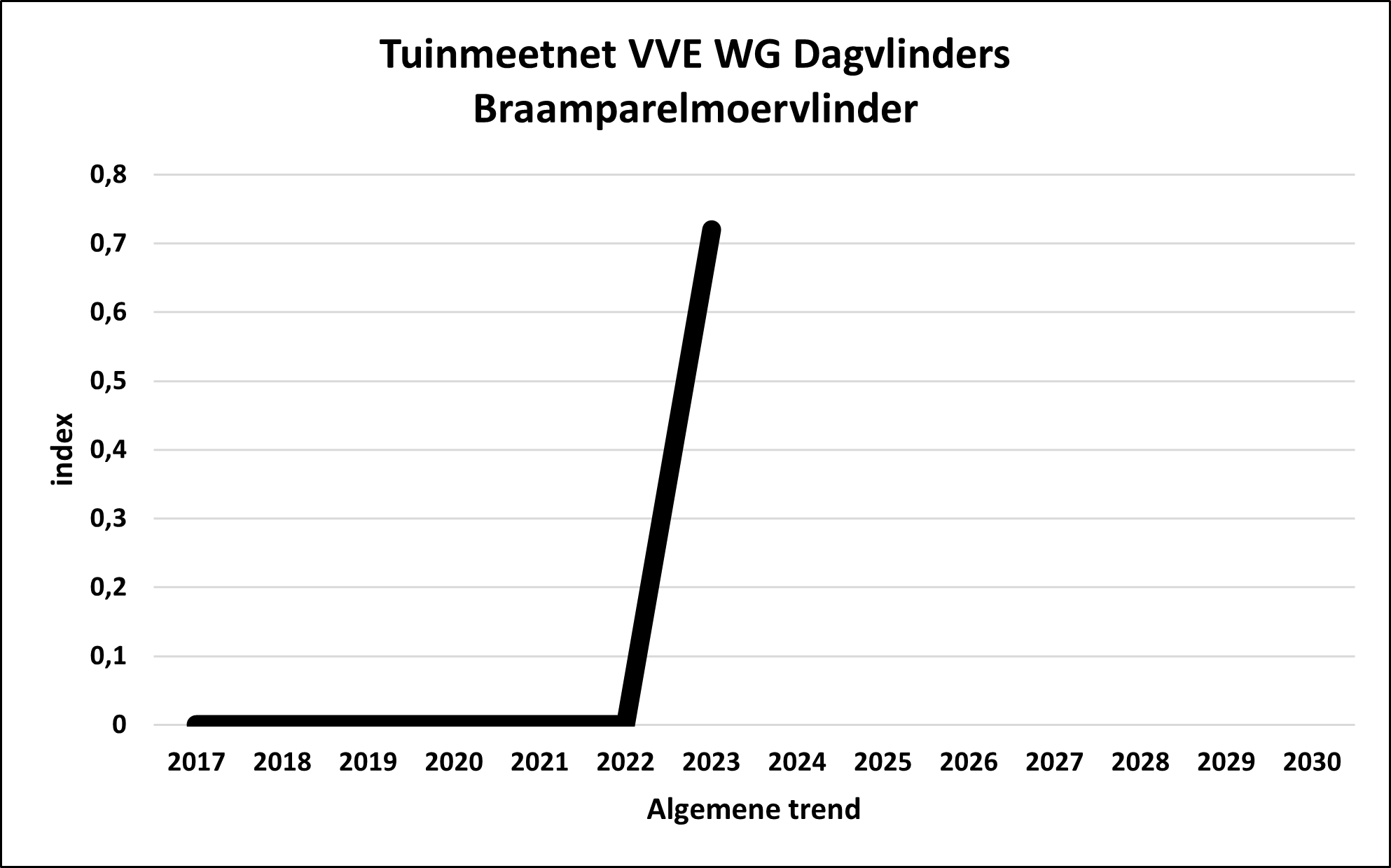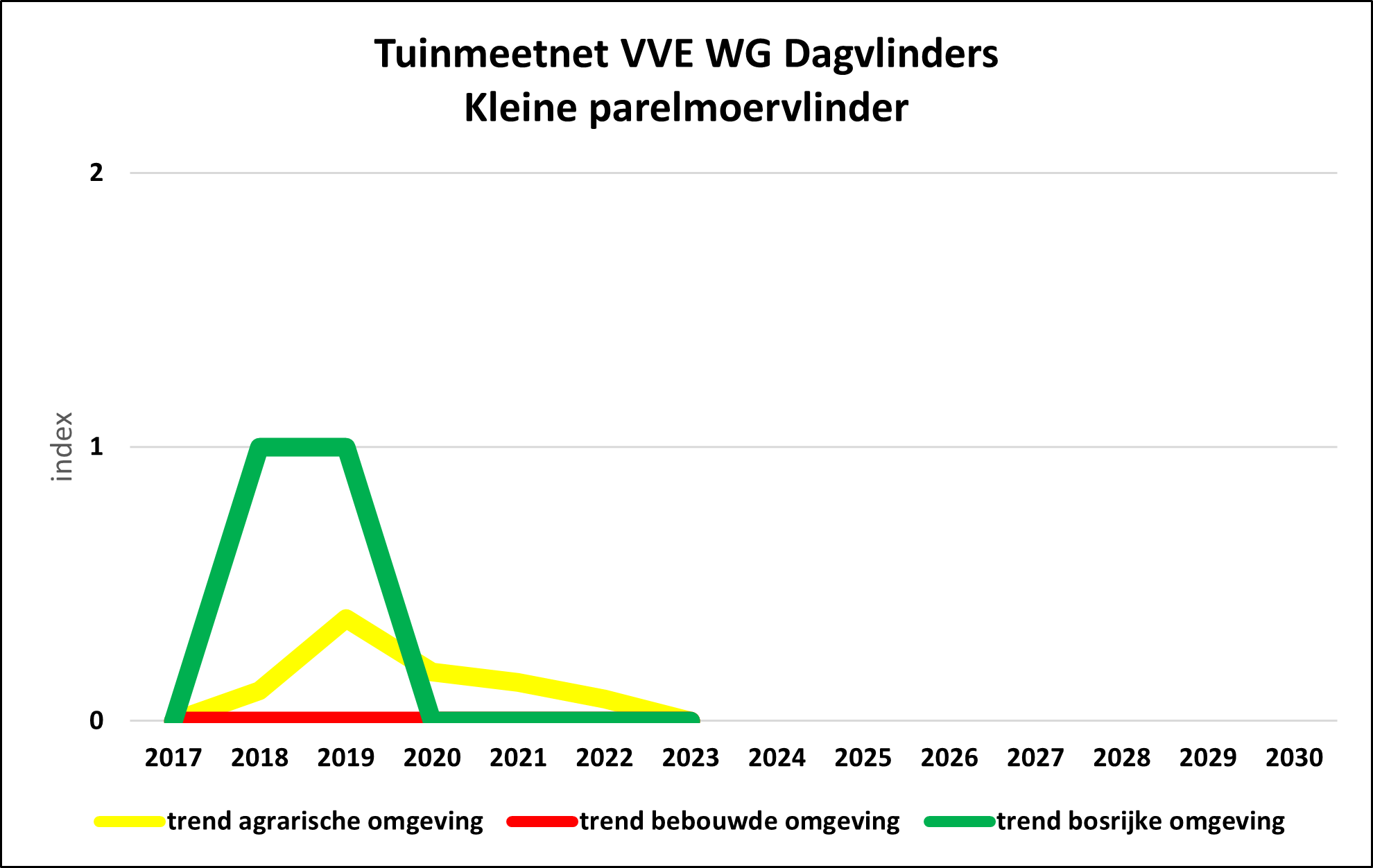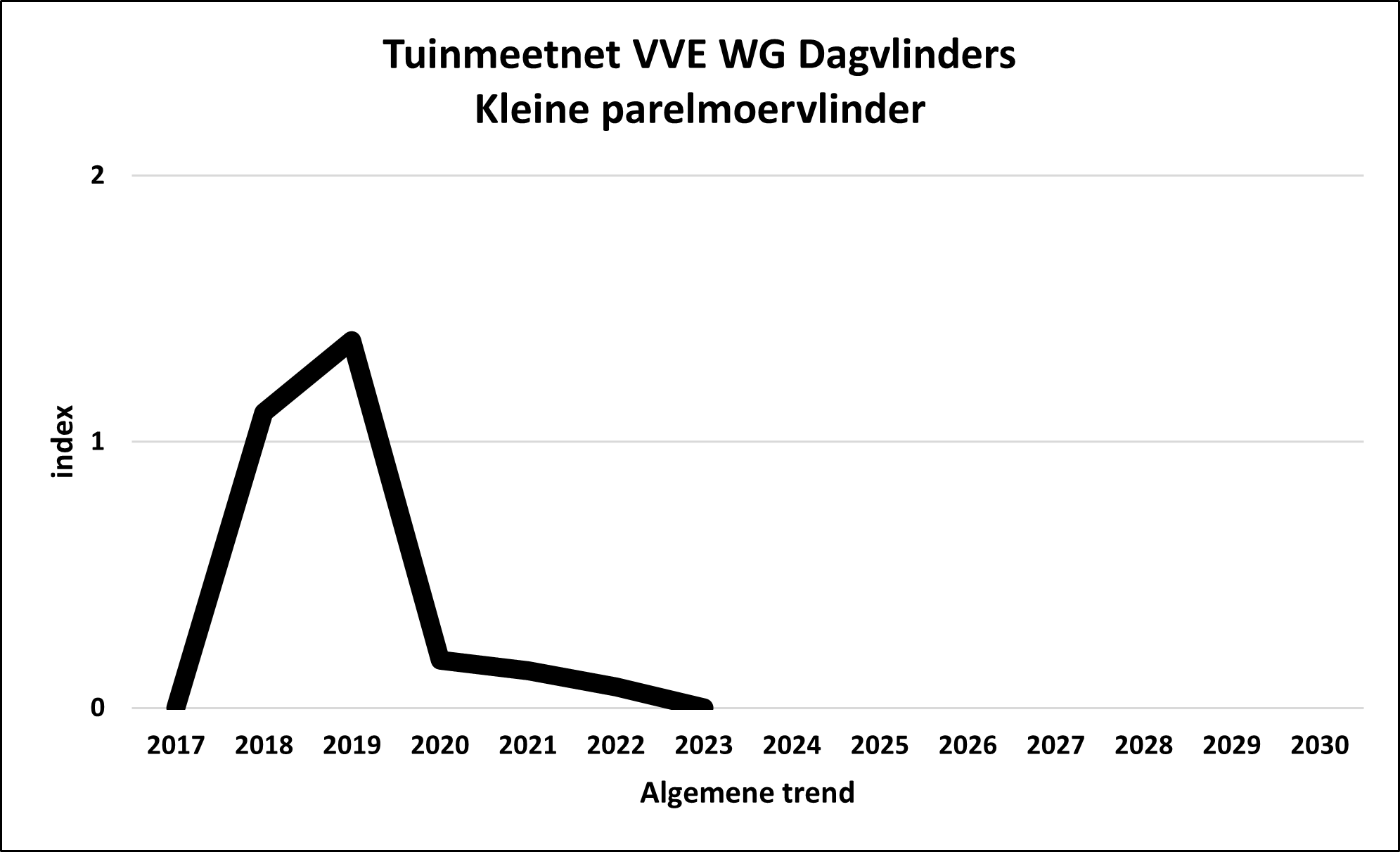 |
 |
 |
Vlaamse Vereniging
voor Entomologie Werkgroep Dagvlinders |
| Home V.V.E. | Dagvlinders | Bijeenkomsten | Projecten | Reisverslagen | Activiteiten | Publicaties | Onderzoek | Flieflotter | Benelux | Tuinmeetnet | Specifieke Meetnetten| |
|
Tuinmeetnet VVE WG Dagvlinders, evaluatie en resultaten 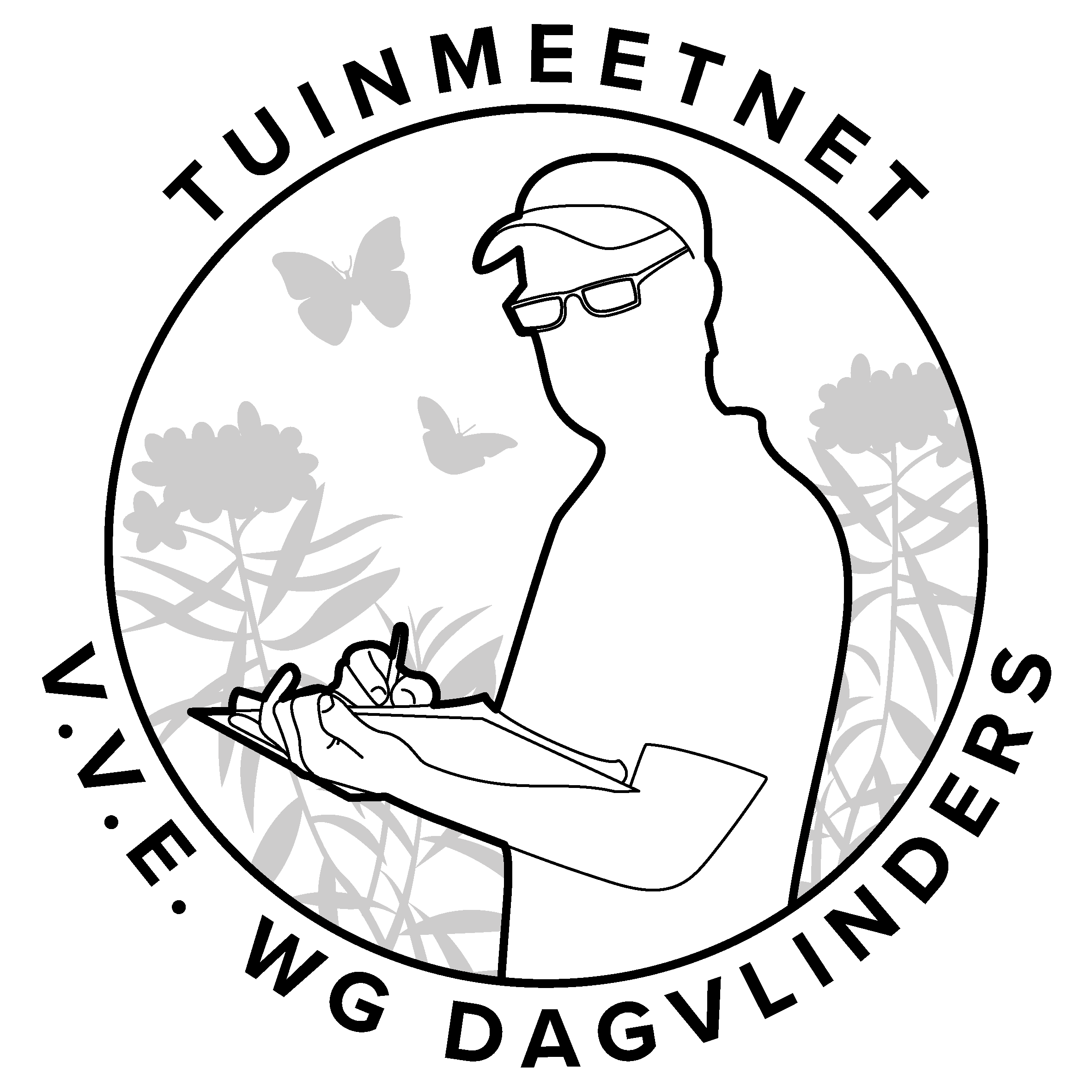
De samenvatting van de
evaluatie en resultaten van het Tuinmeetnet vanaf de start in 2017 tot en met 2023.
The summary of the evaluation and results of the Garden monitoring network from the start in 2017 onwards, up until 2023. This is still a work in progress, other species will be added. Per species, two graphs are shown. The first one discribes the results by environmental type (the dominant part of a given category in the 1km radius around a garden). The hereby compared types for the gardens are the rural environmental type (yellow), the forested environmental type (green) and the built environmental type (red). The second graph is the graph showing the general results (black), rural, forested and built environment combined. The index is a measure of occurance, an average taken over the gardens. You can view the publication by contacting Jurgen Couckuyt.
Algemeen gesproken kent het Groot dikkopje een sterke achteruitgang in het gebied; een trend die zich dan ook voortzet in 2024. Large skipper is mainly present in gardens with a rural environmental type, but it has an occurence in gardens with the built or forested environmental type as well, al be it lesser numbers. Generally spoken, Large skipper does show a rapid decline in the area; a trend, which has continued in 2024. Terug naar inhoud/ Back to content
In tuinen met een bosrijk omgevingstype is de soort initieel afwezig, om pas sinds 2020 in de waarnemingen voor te komen, met een piek in 2021 en na een sterkte daling terug te verdwijnen in 2024. Algemeen bekeken is na een snelle stijging sinds 2021 een scherpe daling ingezet, om in 2024 tot onder het beginniveau van 2017 te zakken. Mallow skipper had an increase in observations; more strongly so in gardens with a built environmental type, compared to gardens with a rural environmental type to have after 2021 a major decrease until it got lower than the level of 2017. In gardens with a forested environmental type, the species was absent at first, only to be present in the observations from 2020 onwards, with a peek in 2021 and, following a strong decline, to be absent again in 2024. Generally spoken, there has been a decrease since 2021, following a steep rise, only to fall be below the initial level of 2017 in 2024. Terug naar inhoud/ Back to content
Waarenemingen blijken groter te zijn in de vooral drogere en warmere jaren 2018 t.e.m. 2020, vooral dan in bosrijke omgeving, 2019 geeft een dal in waarnemingen in tuinen in een agrarisch omgevingstype. In 2021 is er echter overal een enorme afname geweest om dan weer te stabiliseren. Swallowtail is present in every environmental type. Observations appear to be bigger in the mainly dry and warm years of 2018 up until 2020, especially in gardens with a forested environmental type, 2019 is a low in observations from gardens with a rural environmental type. In 2021, however, there was a steep decline everywhere, to stabalise afterwards. Terug naar inhoud/ Back to content
Algemeen was er een grote piek in 2019. Clouded yellow has an irregular presence with low numbers, and this mainly in gardens with a rural and built environmental type. In gardens with a forested environmental type there only was a presence during the peak of 2019. Overall there was a big peak in 2019. Terug naar inhoud/ Back to content
Blijft algemeen genomen stabiel tot stijgend in aantal. Brimstone is common everywhere, but is mainly present in gardens with a forested environmental type. In gardens in the other types, rural and built, the numbers stayed more or less stable, whil in gardens in forested environmental types, there was a big peak in observations in 2023. Overall the numbers remain stable to increasing. Terug naar inhoud/ Back to content
Als algemene trend ziet men een dalende evolutie met fluctuaties in dit deel van Vlaanderen. The graphs of Orange tip prove that it is a forest species, regarding its main presence in gardens in a forested environmental type. Observations in the gardens with the other two environmental types are similar, and always lower then those in forested environment. For an overall trend, we see a decreasing evolution with fluctuations for this part of Flanders. Terug naar inhoud/ Back to content
Na een uitschieter van 2018 zijn de aantallen redelijk stabiel gebleven, maar fluctuerend. Large white is mainly present in gardens with a rural or forested environmental type, where it is subjected to fluctuations, whit the highest peak in 2018. In gardens with a built environmental type it occurs in lower numbers, however quasi stable or very lightly increasing, without significant outliers. Large white stayed reasonably stable in presence, but fluctuates, with 2018 as an outlier. Terug naar inhoud/ Back to content
Plotseling voorkomen sinds 2019, met sinds 2020 groeiende aanwezigheid. 2022 was een minder jaar voor de soort. The Southern small white is a species with a sudden appearance in 2019, yet with a growing presence afterwards in every environmental type. Gardens in a forested environmental type had the largest number of observations, but not exclusively so, and were prone to far bigger fluctuations then was the case in rural or built environmental types. Built environmental type is the type which has, for this species, the least fluctuations, and seams to stablise around an index of 1. Abrupt appearence since 2019, with from 2020 onwards a growing presence. 2022 was a lesser year for this species. Terug naar inhoud/ Back to content
Deze vlinder kent redelijk stabiele waargenomen aantallen, zij het dat deze iets minder waren in 2022. De schommelingen zijn algemeen minder uitgesproken dan bij het bosrijk omgevingstype. Green-veined white was mainly observed in gardens with a forested or rural environmental type, but many observations were also recorded in gardens with a built environmental type. In gardens with a forested environmental type, this species could fluctuate, with a peak in 2019 and a low in 2022. This butterfly has reasonably stable observed numbers, all be it, that these were slightly less in 2022. These fluctuations are generally lesser expressed than those found in the forested environmental type. Terug naar inhoud/ Back to content
Algemeen gesproken lijkt deze vlinder een licht toegenomen trend te vertonen, maar schommelt, met een piek in 2020. Cabbage white does not seem to have a particular interest in a specific environmental type, however, it fluctuates the most in forested environmental type, with a clear peak in 2020. Generally spoken, this butterfly seems to show a slightly increased trend, yet it fluctuates, with a peak in 2020. Terug naar inhoud/ Back to content
Uitschieter in 2017, waarna de waarden zich stabiliseerden. Small copper seems reasonably stable in numbers, with an outlier in 2017, which was mainly due to gardens with a forested environmental type. Small copper has no real preference for any environmental type. Outlier in 2017, after which the values stabalised. Terug naar inhoud/ Back to content
De soort kent algemeen gesproken een licht neerwaardse trend. Purple hairstreak is quasi only present in gardens with a forested, or, to a lesser extend, rural environmental type. In rural environmental types, the species is far more stable, without outliers, compaired to forested environmental type, which shows a big peak in 2020, after 3 stabel years, and it's lowest value in 2022. Overall, the species, had a slightly downward trend. Terug naar inhoud/ Back to content
Algemeen is de soort vanuit afwezigheid naar een plotse piek gekomen sinds 2022 en is voorlopig blijven groeien. White-letter hairstreak showes a very sudden increase in 2022, mainly due to gardens in built environmental type. As for rural environmental type, only a far smaller peak in 2022, to again be called absent in 2023. As for now, no observations were made in gardens in a forested environmental type. Generally, the species came from absence to a sudden peak in 2022, and did continue to grow for the time being. Terug naar inhoud/ Back to content
Een redelijk stijgende trend, maar enorm wisselend, met toppen in 2018, 2020 en 2023 vooral door tuinen in een bosrijk omgevingstype veroorzaakt. Short-tailed blue is mainly present in gardens with a forested environmental type, but is also present in gardens with the built or rural environmental type, which fluctuated far less, and stayed more or less stable. It has a reasonably increasing trend, yet highly changing, with peaks in 2018, 2020, and 2023, mainly due to gardens in a forested environmental type. Terug naar inhoud/ Back to content
Deze vlinder kende tussen 2018 en 2022 een sterk neerwaardse trend, maar kende een zeer sterkte toename in 2023. Brown argus does not have a specific preference for gardens with any type, with the lowest numbers in forested environmental type, however. Rural and built environmental type showed a peak in 2018 and a decline until 2022, whilst observations for forested environmental type gardens continued to decline across the whole line until 2022, to show an amelioration in 2023 for every environmental type. This butterfly had highly declining trend between 2018 and 2022, but did show a strong increase in 2023. Terug naar inhoud/ Back to content
Algemeen is een afname waar te nemen, met een stabilisatie rond een index van ongeveer 4. Common blue is present in gardens in every environmental type, with strong fluctuations in gardens in a forested environmental type. Overall, there is a noticable decrease, with a stablalisation at around an index of approximately 4. Terug naar inhoud/ Back to content
Algemeen was er dus een plotse influx van deze soort in 2023. Pea blue showed a sudden presence in gardens in a rural environmental type, whilst it remained absent for the other environmental types. Overall, there was a sudden influx of this species in 2023. Terug naar inhoud/ Back to content
Algemeen ging de soort er op vooruit, doch met schommelingen. Speckled wood is present in gardens with every environmental type. Peaks were noticed in forested environmental type in 2020, and in rural environmental type in 2022 Overall the species increased, al be it fluctuating . Terug naar inhoud/ Back to content
De tuinen met een bebouwd omgevingstype kennen voor het Bruin zandoogje voornamelijk een sterke daling in 2018, die redelijk stabiel bleef rond een index van 2, om dan vanaf 2022 weer te gaan stijgen. Bosrijk omgevingstype kende ook de daling van 2018, maar bleef daarna meer fluctueren rond een index van 2 à 3. Bont zandoogje is geen uitgesproken bossoort, eerder van een agrarisch omgevingstype. Algemeen blijft de soort redelijk stabiel, met een grote piek in 2017. Meadow brown is present in every garden type. Gardens in rural environmental type have the highest indices. For the other two environmental types, the observations do fluctuate to a far greater extend, and are usually below these of gardens in a rural environmental type. Gardens with a built environmental type showed for Meadow brown a stron decrease in 2018, which remained fluctuation around an index of 2 to 3. Meadow brown is not a distinct species of forests, but rather bound to gardens with a rural environtal type. Overall this species stays relatively stable, with a big peak in 2017. Terug naar inhoud/ Back to content
Algemeen kan een redelijk stabiel verloop opgemerkt worden, met een stijging de laatste jaren. Gate keeper tends to have the highest numbers in gardens with a rural environmental type, with a relatively stable trend. Gardens characterised with a built environmental type tend to have rather small increase, with lower occurences, while for gardens with a forested environmental type, the numbers tend to fluctuate a lot. Overall trend appears to be reasonably stable, with an increase for the last few years. Terug naar inhoud/ Back to content
Algemen werd deze soort in 2020 en 2021 niet gezien na een grote daling tussen 2017 en 2020, om dan weer in 2022 in de tuinen te verschijnen, maar in 2023 niet meer. Deze vlinder is dus niet ieder jaar in de tuinen waar te nemen en kende een drastische daling in waarnemingen. Purple emperor does not occur in gardens in a built environmental type, and shows a clear preference for gardens in a forested environmental type, where observations showed a steep decline between 2017 and 2019, to be present again in 2022. In Gardens in a rural environmental type, this species was only seen in 2017 and 2019. The dry and warm summers seem to keep this species out of the gardens. Overall, this species was not observed in 2020 and 2021 after a steep decline between 2017 and 2020, only to show up again in the gardens in 2022, however not any longer in 2023. This butterfly doesn't show up every year in gardens, and showed a drastic decline in observations. Terug naar inhoud/ Back to content
Lijkt fluctuerend voor te komen met afwisselend goede en mindere jaren. 2019-2021 leken de beste jaren tot nu toe voor deze trekvlinder, die zich goed lijkt aan te passen en ook reeds overwintert. Algemen lijken sterkere jaren zwakkere jaren af te wisselen, met de hoogste pieken voor 2019 en 2021. De trend lijkt stabiel, met grote fluctuaties, maar niet afnemend. Admiral is mainly present in gardens with a rural or forested environmental type, where better and worse years follow up. This species also occurs, all be it to a lesser degree in gardens with a built environmental type, where the numbers show small fluctuations and seem stable, not decreasing. Appears to be fluctuating, swtiching between better and lesser years. 2019-2021 seemed to be the best years up until now for this migratory butterfly, which seems to adapt well, and also hibernates already. Overall, better and lesser years tend to alternate each other, with the highest peaks in 2019 and 2021. The trend seems stable, with big fluctuations, but not decreasing. Terug naar inhoud/ Back to content
Algemeen een grote piek in 2019, gevolgd door een volledige afwezigheid in tuinen met een bebouwd omgevingstype en een grote afname in 2020 elders. Een klein herstel in 2021. Algemeen is er een licht dalende trend vast te stellen. Painted lady is mainly present in gardens with a forested or rural environmental type, but occurs also in gardens with the built environmental type , all be it lesser numbers. Overall there is a big spike in 2019, followed by the total absence in gardens with a built environmental type and a heavy decrease in 2020 elsewhere. A small recovery in 2021. Overall there is a slight decreasing trend in observations. Terug naar inhoud/ Back to content
De soort lijkt algemeen een sinusoïdaal patroon te vormen met om de twee à 3 jaar een piek. Er is geen dalende, noch stijgende trend vast te stellen, de situatie lijkt stabiel. Peacock is more abundant in gardens in a forested or rural environmental type, to a slightly lesse degree it has occurences in gardens with a built environmental type. The species seems tot follow a sine wave pattern for every type of garden, a wave function, with the highest observations in 2021 and 2022, and the lowest numbers in the hot and dry years of 2018 and 2019. Overall, the species seems to follow a wave pattern, with peaks every 2 to 3 years. There is no decreasing, nor increasing trend to be observed, the situation seems to be stable. Terug naar inhoud/ Back to content
Dramatische afname na 2017, met sinds 2020 een matige herstel, vooral dan in tuinen met een agrarisch omgevingstype. Small tortoiseshell does not seem to prefer any environmental type. Absent from gardens in forested environmental type in 2019 and 2021. Dramatic decrease after 2017, with a moderate recovery since 2020, maily in gardens with a rural environmental type. Terug naar inhoud/ Back to content
Algemeen kende deze zeer mobiele soort een sterke toename vanuit afwezigheid in 2018, om daarna dramatisch te dalen en vanaf 2021 weer totaal afwezig te zijn in de waarnemingen. Large tortoiseshell is totally absent from gardens in built environmental type. A large peak in 2018 in gardens in forested environmental type. A smaller, but longer occurence in observations in gardens in a rural environmental type. From 2021 onwards, this species has not been seen in any garden type. Generally spoken, this highly mobile species had a steep presence out of absence in 2018, to decrease dramatically afterwards and again be totally absent in observations from 2021 onwards. Terug naar inhoud/ Back to content
Lijkt redelijk stabiel met fluctuaties, vooral dan in tuinen met een bosrijk omgevingstype. In tuinen met een agrarisch of bebouwd omgevingstype lijkt het voorkomen in grote lijnen stabiel gebleven. Redelijk stabiel, maar met sterke fluctuaties die lijken af te gaan vlakken. Comma butterfly occures in bigger numbers in gardens with a forested environmental type, but also occurs well in gardens with a built or rural environmental type. Appears to be reasonably stable, with fluctuations, mainly in gardens with a forested environmental type. In gardens with a rural or built environmental type it seems to have stayed broadly stable. Reasonably stable, but with strong fluctuations, which seem to be flattening out. Terug naar inhoud/ Back to content
Komt voor met grote schommelingen, maar is algemeen gedaald, maar lijkt te stabiliseren rond een index van 5. Map butterfly is mainly present in gardens with a forested environmental type, with a distinct peak in 2020, but it has also a presence in gardens with the built or rural environmental type. It is prone to big fluctuations, but generally spoken it decreased, but seems to be stabalising around an index of 5. Terug naar inhoud/ Back to content
Deze typische bosvlinder kende een sterke daling, met een dramatisch dieptepunt in 2021 en een goed herstel daarna. Silver-washed fritillary is chiefly present in gardens with a rural environmental type, which is by far the outmost important environmental type for this species, however, it occurs to a far lesser extend also in gardens with other environmental types (rural and built). This typical woodland butterfly had a steep decrease, with a dramatic bottom in 2021, and a good recovery afterwards. Terug naar inhoud/ Back to content
Deze soort kende een plots voorkomen in de waarnemingen in 2023. Marbled fritillary was only observed in gardens with a forested or rural environmental type, with a preference for gardens in a forested environmental type. This species knew a sudden presence in obeservations in 2023. Terug naar inhoud/ Back to content
Kende een piek in 2018 en 2019, die daarna weer afnam tot ze weer uit de waarnemingen verdween in 2023. Queen of Spain fritillary was only observed in gardens with a forested or rural environmental type. After a spike in numbers in 2018 and 2019, it decreased henceforth, to disappear again from the observations in 2023. Terug naar inhoud/ Back to content |
||||||||||||||||||||||||||||||||||||||||||||||||||||||||||||||||||||||||||
|
Contact Werkgroep Dagvlinders: Jurgen Couckuyt |
